

Ultimate guide to the Silo Art Trail in Victoria (with map)
Silo art has really taken off in Australia. The original Silo Art Trail in Victoria is now one of the most popular road trips in the state. Read on to find out more about this trail, and the vibrant murals breathing life back into tiny regional towns.

While Melbourne is well-known for its street art , many people don’t realise there is equally great art to be found in regional Victoria.
The Silo Art Trail in particular is extraordinary and well worth checking out on any visit to the state.
They’re a melding of history and art, devised to bring tourism to small, regional towns in the area.
And they’ve done just that – international acclaim has brought thousands of travellers flocking to this region of the state, spreading the tourist dollar where it’s most needed.
You can now find these painted silos in several states across Australia – Western Australia, South Australia, Queensland and New South Wales have all jumped on board.

The original Silo Art Trail of Victoria
Like Australia’s ‘Big Thing’ statues , these painted silos can brighten up any road trip.
They provide sights to see along the way, as well as a cause to stop in small country towns that you may otherwise miss.
While the online images of the silos are impressive in themselves, they are something that are worth experiencing in the flesh. Like most art, of course!
This guide covers the original silo art trail in the state’s north-west, located in Wimmera Mallee.
There’s now also a second silo trail in Victoria’s north-east .
This Silo Art Trail road trip itinerary contains affiliate links. If you make a purchase, I may make small commission, at no extra cost to you.
You’ll need a car to get out to see the Silo Art Trail. Renting a car is very straightforward in Australia – I’ve done it more times than I can count.

History of the original Silo Art Trail
There are hundreds of silos littered across regional Australia, some which were built in the 1930s.
Originally used to store grain, abandoned train lines and changes in agricultural practices have forced some to close.
The question then arises – what can then be done with these structures?
Some have been sold to private companies for storage. Others have been turned into telecommunication towers, providing mobile phone reception.
In what may be the most genius idea yet, the town of Mirrool in southern inland NSW has held an annual event since 1992, where there is a competition to boot a footy over the local silo .
Whoever kicks the highest, wins!
And of course, they’ve become blank canvas for artists all over the world to paint large-scale works on their surface.

Where it all began
The silo art trail started in the small town of Brim, in Victoria’s north-west.
GrainCorp, who owns most of the silos in Australia, agreed to allow Brisbane artist Guido van Helten to paint a mural on the 30 metre high decommissioned silos in Brim.
The idea was originally intended to be a small community project, dreamt up by Brim Active Community Group, street art agency Juddy Roller and van Helten.
The mural, depicting four locals (three men and a woman) of unknown identities, were an instant sensation.
While the paintings are impressive and van Helten is beyond talented, it is the melding of everything – the space, the canvas, the backdrop and the sheer size of the artwork that makes them what they are.
As a consequence, in 2016, it was agreed that more silos would be donated by GrainCorp and the trail was born.
The Silo Art Trail today
There are now fourteen scattered across the Wimmera-Mallee region. Alongside Brim, you’ll find them in Patchewollock, Lascelles, Rosebery, Sheep Hills, Rupanyup, Nullawil, Sea Lake, Goroke, Kaniva, Walpeup, Horsham, Arkona and Albacutya.
Two more officially trail murals are planned for Rainbow and Serviceton on the SA/VIC border.
There are also silos in nearby St Arnaud, Avoca and Murtoa, which for some reason aren’t officially part of the trail, but can still be seen as part of this road trip.
Something to note. The silos aren’t a mere hop, skip and a jump from Melbourne.
They’re spaced hours apart and the northernmost painted silo in Patchewollock is about a five hour drive from the city.
The trail being as large as it is now, there’s no way you could see them all in a day trip. However, it does make for an excellent weekend getaway from Melbourne – or a long weekend, if you can wangle it.
Luckily, there’s plenty else to see in this underrated part of Victoria.

Originally 200 kilometres, the trail just keeps growing!
If you want to do the trail justice, consider dedicating three or four days to the trip. Stay in the small towns and spread your tourist dollars where they’re most needed.
When I originally saw the silos, I did it over two days, leaving Melbourne at 10am on a Monday and getting back in around 430pm on a Tuesday.
This was when there were only six on the original trail.
It was a very leisurely journey. With two of us driving, we were able to stop whenever we wished, to grab a pie on the road or have a quick poke through any country town that looked interesting.
Consult this map in plotting out your journey along the trail:
This post forms part of my guide to the best places to visit in Victoria . For more, check out this Melbourne itinerary (written by a local) and other unique things to do in the city . Plus here’s my top tips for road tripping in Australia .

Where does the Silo Art Trail start?
Well, it depends where you’re heading from.
The Victorian Silo Art can be started from Melbourne, Horsham, Ballarat or Bendigo .
Alternatively, you can approach the trail from Mildura, starting in Walpeup and working your way down to Horsham.
If you’re coming over the border from South Australia, you’ll hit either Kaniva or Goroke first.
Here are all the silos on the trail, if you were to navigate along the trail from Melbourne.
Horsham Silo Art

With a shiny new piece of art, Horsham is the best place to start your journey along Victoria’s Silo Art Trail.
In the town’s north you’ll find a work by Smug aka Sam Bates, featuring Wotjobaluk Country man Yanggendyinanyuk, alongside his totem, a Gamaty (Black Cockatoo).
The work is called The Yangga Dyata which means ‘Walking on Country’ and is intended as a legacy to Yanggendyinanyuk.
Location: Hazel Street & Wawunna Road, Horsham
Rupanyup Silo Art

Artist: Julia Volchkova
Rupanyup’s mural is painted by Russian artist Julia Volchkova, who chose two young sports stars as her models.
Ebony Baker and Jordan Weidemann play netball and AFL respectively and are featured here in their sporting attire.
Unlike the rest of the silos on the trail, Volchkova’s work is painted on two large steel grain silos – however, it doesn’t make it any less impressive than the other taller works.
If you’re keen to stretch your legs, walk through town, following the Chainsaw Art Trail. These are a series of works by artist John Brady, intricately carved by I would guess, chainsaw.
Previously, you could also view a work by Volchkova’s assistant Georgia Goodie on the main strip, but when I was last in town (November 2023) it had been removed.
📌 Location: 1 Gibson Street, Rupanyup
Sheep Hills Silo Art

Artist: Adnate
Adnate is a Melbourne-based artist who is known for his work with Aboriginal communities across Australia. His paintings regularly feature members of the Indigenous community and his mural at Sheep Hills is no exception.
It features four Indigenous people (Wergaia Elder, Uncle Ron Marks, and Wotjobaluk Elder, Aunty Regina Hood, Savannah Marks and Curtly McDonald) and the starry sky, which is significant within the local community.
📌 Location: 445 Sheep Hills-Minyip Road, Sheep Hills
Arkona Silo Art

Artist: Sam Bates aka Smug
Head to this small town to see the latest in the Silo Art Trail project.
Smug has painted a fitting and somewhat kooky tribute to local Roley Klinge, which also highlights the importance of tennis in regional communities.
Klinge, a local legend, passed away in 1991. As Smug, who works with photorealism, was unable to photograph him, he came up with another ingenious solution of rendering Klinge onto the tiny town’s grain silo.
Which kinda looks like the cover of a Goosebumps book. I dig it.
📌 Location: 835 Dimboola-Rainbow Rd, Arkona
20+ fun facts about Melbourne
What NOT to do when visiting Australia
These are the most haunted places in Melbourne
Kaniva Silo Art

Artists: David Lee Pereira and Jason Parker
This work joined the trail in 2020.
In it, the two artists have painted a vibrant mural based on nearby Little Desert and its diverse flora and fauna.
The image is of an Australian Hobby (a type of falcon), flying between two colourful orchids.
📌 Location: 31 Progress Street, Kaniva
Goroke Silo Art

Artist: Geoffrey Carran
Birds are a popular theme along the trail.
Artist Geoffrey Carran has painted a mural featuring a kookaburra, galah and magpie, paying tribute to local birdlife.
Quite fitting as the name of this town is the local Aboriginal word for magpie.
📌 Location: Railway St, Goroke
Brim Silo Art

Artist: Guido van Helten
Van Helten’s work is the first of the Silo Art Trail murals, completed back in 2015.
It depicts four members of the local community, although van Helten has kept silent on his model’s identities.
He has stated that he wants the spotlight to stay on the resilience of all members of the small town, who face ongoing hardships such as economic pressure and the devastating effects of climate change.
This mural went on to inspire the original trail (and now other silo art trails) and has become a regional landmark in itself.
📌 Location: 1986 Henty Highway, Brim
Rosebery Silo Art

Artist: Kaff-eine
Kaff-eine completed her mural in late 2017, after assisting Rone with his.
Knowing that her work would be nestled between the monochromatic silos of Brim and Lascelles, Kaff-eine purposefully added colour to her mural, which features a young female farmer on one side and a man in an Akubra having a quiet moment with his horse on the other.
📌 Location: Henty Highway, Rosebery
Albacutya Silo Art

Artist: Kitt Bennett
The brightest silo on the trail is a 2021 addition.
Melbourne artist Kitt Bennett was inspired to create a mural that tells the story of growing up in the country.
The resulting artwork is bright, surreal and somewhat distorted from reality.
📌 Location: Albacutya Road, Rainbow
Walpeup Silo Art
This silo commemorates a 16 year old boy from the town, Harold Thomas Bell (Wickham). Unbeknown to his parents, he lied about his age to sign up for the Light Horse Regiment and was sent overseas to fight in WWI.
The teenager was critically injured in battle and died the next day.
The former town local is commemorated in this vibrant work by artists Julian Clavijo and Camilo Delgado. It features a portrait of the boy, a horse and a galah, set against the backdrop of a brilliant sunset.
📌 Location: 31 Cregan Street, Walpeup
Patchewollock Silo Art

Artist: Fintan Magee
The Patchewollock silo was completed in late 2016 and features local sheep and grain farmer, Nick “Noodle” Hulland.
Magee believed the then 42 year old embodied the typical look of a farmer and so used him as his muse.
Patchewollock has a population of 250 and is 420km north-west of Melbourne, in the Mallee district.
It’s hoped the mural will help slow and perhaps even prevent the decline of the town.
📌 Location: 88 Cummings Road, Patchewollock
Sea Lake Silo Art

Artists: Drapl & The Zookeeper
One of the newer pieces of silo art along the trail can be found in the small town of Sea Lake.
The work of street artists Drapl & The Zookeeper, this vibrantly coloured silo features nearby Lake Tyrrell as its centrepiece. Lake Tyrrell is one of Victoria’s pink salt lakes and its gorgeous.
A young girl swings from the branches of a Mallee Eucalyptus, looking over the lake. A Wedge-tailed eagles soars above her, and nearby, three emus run across the land.
The Boorong People of this area were known to have a strong knowledge of astronomy and a deep connection with the giant salt lake that so beautiful reflects the night sky.
📌 Location: Railway Ave, Sea Lake
Lascelles Silo Art

Artist: Rone
The mural at Lascelles (or “Leigh Sales” as I kept calling it, Australians will get the terrible joke) features Geoff and Merrilyn Horman, whose family has farmed in the area for four generations. A staggering amount of time, one would agree.
I have to say that of all the murals, this one seems to blend in best with its environment.
Lascelles is truly a tiny town, with a population of just 48.
📌 Location: Lascelles Silo Road, Lascelles
Nullawil Silo Art

Artist: Sam Bates aka “Smug”
This addition to the original Silo Art Trail resides in the small town of Nullawil.
This work is by Australian street-artist Smug or Smug One. Smug specialises in photorealism graffiti and is internationally renowned, living in Glasgow, Scotland and working across the world.
This was his second silo art mural (his first is in the town of Wirrabara in SA) and it shows a farmer and his Kelpie. He has now painted several around the country.
The emphasis in this work is on the dog, highlighting the importance of working animals to local farming communities.
This work was completed in July 2019 and I don’t have pictures of it yet, but have plans to get back out there to snap some. Watch this space!
📌 Location: 26 Calder Hwy, Nullawil
Other silos near the trail
Here are a couple of silos in the area you can throw into the mix, which aren’t officially part of the Silo Art Trail.

Artist: Torney
Although not technically part of the trail, this silo art can be seen on the same trip, if you’re feeling particularly ambitious.
Entitled ‘Hope’ the mural is representative of the town’s gold rush history. The local community helped select the design.
A local artist, Torney has several other works located around this town.
📌 Location: 3 McMahon St, St Arnaud

Artist: Smug
The silo art in Murtoa is probably one of my favourites to date.
Smug was apparently inspired by the James Hill taxidermy collection found in the Murtoa Museum.
There are 30 birds can be found on the silo, The unique glowing bird represents the 1 in 30 Australians who suffer from mental health illness.
📌 Location: Soldiers Ave, Murtoa

Depending on your route home, you may be able to glimpse this work by Warrnambool-based artist Jimmi Buscombe.
It’s of the endangered Barking Owl. And it is unique, in that it glows in the dark.
So, visit after sunset to enjoy it in its full glory.
📌 Location: 2 Station St, Avoca
Planned works for the future
There are plans to incorporate two more silos into the OG Silo Art Trail in Victoria.
One will be located in Serviceton, right near the South Australian/Victorian border. It was initially planned for completion in 2022, but has been delayed.
The town of Rainbow will also feature on the trail, eventually, with its very own silo mural. Likewise, this is still in the works.
Please feel free to bookmark or pin this page, as I regularly update it.
Best day hikes near Melbourne
20 routes for your next Australian road trip
Small towns in Victoria worth visiting

Other places of interest nearby
Country Victoria is full of all sorts of interesting things, both natural and man-made.
If you want to make a real trip out of your journey to see the painted silos of Victoria, there are plenty of other sights you can visit along the way.
Little Desert National Park
This park is popular for birdwatching, hiking and four-wheel driving.
Visit in late winter or early spring to see its blossoms and wildflowers.
With accommodation being slim pickings out here, you could choose to camp beside the Barringgi Gadyin, before continuing your journey along the Silo Art Trail.
It’s worth noting the nearby town of Beulah was the setting for Australian movie ‘The Dry’ starring Eric Bana and based on the book by Jane Harper.

Lake Tyrrell
Lake Tyrrell, also known as the “Mirror Lake” is in the state’s north-west, not at all far from the Patchewollock silo. There’s a salty formation on the lake bed, which gives it a reflective surface.
The lake is around 120,000 years old and is part of the Indigenous Boorong clan’s land. It features heavily in their stories and astronomy.
Tyrrell’s name derives from the Aboriginal word Tyrille, which means “space” or “sky”. Very fitting.
It’s pretty amazing to see, to be honest and there was no one around when we visited in the late afternoon, apart from one couple and about ten billion bloody flies.
You can jump on a tour with a local expert , who can lead you to the best places for photographs at sunrise, sunset and for stargazing at night.

Pink Lake Dimboola
You can also knock off yet another pink lake during your road trip along the Silo Art Trail.
Dimboola’s Pink Lake (Loch Iel Reserve) is right off the highway, an easy side trip to make after seeing the Arkona silo art, on your way to Kaniva.
Discover other pink lakes in Victoria .
Australian Pinball Museum
The Australian Pinball Museum has got to be one of the coolest hidden gems in Victoria.
It’s located in the town of Nhill and as the name suggests, contains a collection of pinball machines and pinball art.
The museum holds the largest collection of pinball machines in Australia, with games dating back to 1932.
Definitely a place worth dropping into during your road trip.

Murtoa Stick Shed
This heritage-listed shed is the first of its kind to be erected in Victoria.
It was built in the early 1940s for emergency grain store during WWII.
It’s now the last grain stick shed in the country. Very much a unique sight to see while travelling along the Silo Art Trail.
Entry is $10 for adults and it’s open daily from 10am-3pm.
Sovereign Hill, Ballarat
Ballarat is one of the state’s best known towns from the Gold rush era and packs a whole lotta history.
Sovereign Hill is an open-air museum, paying homage to this era of Victoria’s history. It features a replica of a gold mining town, filled with costumed actors and visitors can go panning for gold.
Here are some other things you can get up to in Ballarat .

Grampians (Gariwerd) National Park
The Grampians as they’re known (Gariwerd is their Indigenous name), are mountains with waterfalls and hiking trails. They’re a great destination to head to if you fancy a day out in nature.
Victoria’s Silo Art Trail is not far from the Grampians at all. If you were heading out there for more than a weekend, you could easily tack on a day spent tramping along trails and taking in the splendour around you (and bird watching too!).
For more, check out my guide to the best waterfalls in Victoria .
Kryal Castle
Kryal Castle is on the way back from the Silo Art Trail, if you’re heading home via Ballarat.
It’s a replica of a medieval castle. There’s a maze, jousting, a wizard’s workroom, archery, pony rides… enough to keep you busy for at least an afternoon.
You can even spend the night there and I can’t even begin to tell you how much I wish to do this.
↠ Book a ticket in advance to Kyral Castle. Or reserve a room , to spend the night in this medieval museum.

Hepburn Bathhouse
This area is known for its mineral spring water, which you can experience at Hepburn Bathhouse .
The spa consists of two sections. General bathing is available in the two mineral pools within The Bathhouse, which can be accessed for between $37-$47 dollars (for an adult), depending on the time and day.
For an upgraded luxury experience, you can book into The Sanctuary, for $79-$99 per adult.
A great place to soak your muscles after all that time spend in the car!
Here are more things to do in Daylesford and Hepburn Springs .

Where to stay on the Silo Art Trail
Most of the towns that feature silo art are tiny, so they don’t have many accommodation options, if any in most cases.
Sea Lake is an exception, with accommodation springing up thanks to interest in the trail and Lake Tyrrell.
Stay the night at the Royal Hotel Sea Lake (where you can also grab dinner) or Skymirror Villa , a guest house in town.
When I drove the trail, I stayed in Horsham, which is about halfway back to Melbourne from Patchewollock. Check in to Comfort Inn Capital Horsham or Golden Grain Motor Inn .
For something completely different, I recommend spending a night at Yarriambiance . There’s a guest house, two tiny houses and a campsite, located about 25 minutes drive from Horsham.
Should you drive the Silo Art Trail?
In short, (although it’s a long trip) the Silo Art Trail in Victoria is a truly unique thing to do.
Even if you can only squeeze in a handful of silos, it’s well worth the trip.
Have you driven the Silo Art Trail? Would you like to?
Need to hire a car for your Silo Art Trail road trip?
Sort your hire car with Rentalcars.com. It’s simple to use and there’s a large selection of cars and providers to choose from.
For more like this, check out my guides to the street art in Adelaide and Perth .
Keen to do this road trip yourself one day? Stick a pin in this post for future reference 📌

This Victoria Silo Art Trail guide contains affiliate links. If you make a purchase, I may make small commission, at no extra cost to you. This goes towards the cost of running this blog. I only recommend goods and services I think are helpful and use myself. Thank you – I absolutely appreciate the support!
NEVER MISS A POST! SIGN UP FOR THE BIRDGEHLS NEWSLETTER , WHICH WILL HIT YOUR INBOX ONCE A MONTH.
Similar Posts
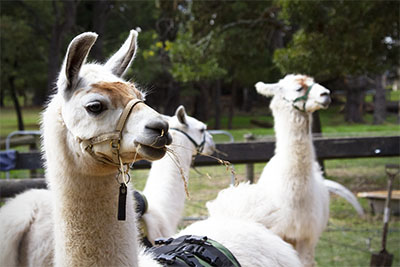
You herd it here: walking with llamas to Hanging Rock
Discover what it’s like to go walking with llamas out at Hanging Rock in Victoria, Australia – spitting distance from Melbourne.
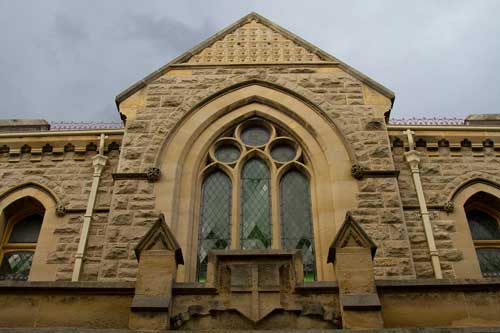
Open House Melbourne: Exploring the City’s Historical Buildings
There are various cities around the world who for two days of the year, fling open the doors of buildings that normally deny access to the public. They’re known as Open House [insert whichever city is in question here] (such as London, Bendigo, etc) and it’s quite simply, a marvellous event. Melbourne is one such…
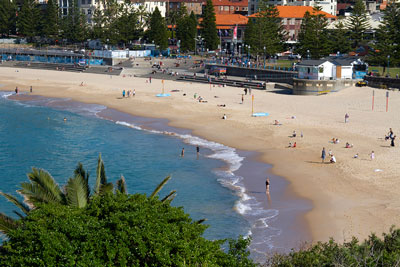
Where to stay in Sydney in 2024
Sydney is a large, sprawling metropolis with plenty to explore. Choosing where to stay in Sydney can be the hardest part of your trip, particularly as it doesn’t have the cheapest accommodation options. This article will help you decide where to stay in Sydney, whether it’s your first time in the city or your tenth!…
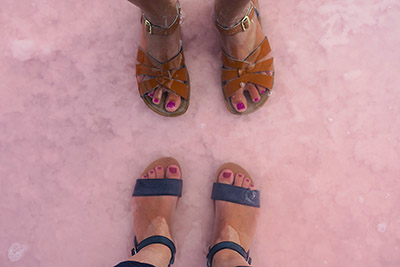
A quick guide to the pink lakes of Victoria, Australia
Did you know Victoria has a few pink lakes? Here’s when and where you can find them.
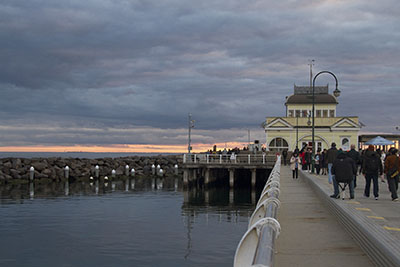
7 days in Melbourne itinerary: complete guide for 2024
Find out exactly how you can spend 7 days in Melbourne with this Melbourne itinerary – written from a local’s perspective.
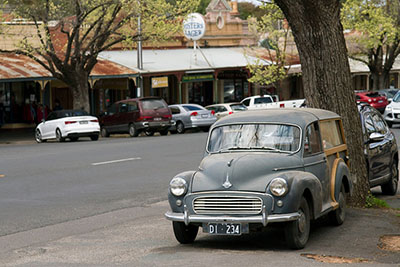
Necessary road trip tips for Australia
Hitting the wide open roads of Oz? Before you go, check out these road trip tips in Australia, to make sure you’re fully prepared.
14 Comments
Hi…just to let you know there are two other silo artworks around Devenish / Goorambat – at Tungamah and St James. Coming from Albury/Wodonga, I did all four in a day trip: Tungamah, to St James to Devenish to Goorambat.
Thanks Joanna! Great timing, I actually saw them a week ago, just haven’t got around to updating this post yet. They’re amazing – I think I like the Tungamah one best, but do have a soft spot for kookaburras.
These silos are amazing! I love the art and scale (plus the blue skies!) I need to add this to the bucket list.
We got very lucky with the weather on both occasions. The sheer scale of them is mind boggling! Hope you get to see them soon.
Great post! Silo art has really taken off to showcase our regional areas. Have you been to Maldon, designated First Notable Town in 1966? Most well-preserved 19th Century Streetscape award. Now a thriving rural farming community and tourist town, close to Castlemaine. Worth checking out!
Thanks Marie! I haven’t, will have to make a visit. I have been to Clunes however and fell in love with its streetscape. So many lovely places to explore in VIC!
Did the Silo Art Trail top to bottom 12th July 2019. On our way up to Sea Lake there was a new one been painted at Nullawill(day 6). It was finished on 19th July
Oooh how exciting! Thanks for the heads up Trev. Will have to get back up there and snap some pics.
Beautiful silos at Rochester just north of Bendigo.
Oh I’ve seen pictures! Need to get up there and see it properly.
Thank you Joanna for making the effort of this post. very informative and helpful.
I am working up a trip for my Probus Club in Ballarat and will include your North east silo trail.
Colbinabbin also have added their silo to the artists brush.
Thanks for the tip, Russell. Just looked it up – what a beauty. Hope to see it in the flesh one day.
can also recommend the Spanner Man , Piccoli’s Spanner Sculptures in Boort if you have the time
Leave a Reply Cancel reply
Your email address will not be published. Required fields are marked *
Save my name, email, and website in this browser for the next time I comment.
This site uses Akismet to reduce spam. Learn how your comment data is processed .
Just Me Travel
Solo travel blogger, the complete guide to road tripping victoria’s silo art trail [2021 updated].

The Best Authentic Road Trip to Victoria’s Silo Art Trail and the Artists Behind the Murals
Take a road trip with a difference – travel along the Silo Art Trail in Victoria, Australia. See how disused grain silos have been transformed into unusual, towering art canvases. Each canvas is unique, with murals reflecting the people, landscape and culture of the community in which they appear.
Empty grain storage silos are scattered around rural Australia. Silo art projects (with the first completed in 2015) have become a national phenomenon, appearing in Victoria, New South Wales, Western Australian, South Australia, and Queensland. The silos provide a canvas for creations that are reinvigorating some of Australia’s smallest and most remote regional towns. They have become a lifesaver for rural communities, bringing tourism to towns that have been seriously struggling due to economic decline.
Perhaps the best-known silo art project is the painted silos in Western Victoria; in the Wimmera Mallee region. Here, six painted silos form a 200-kilometre route from Rupanyup in the south (if coming from Ballarat, as we did) to Patchewollock in the north. This is the Silo Art Trail.
My sister and I took a 12-day road trip around regional Victoria – from Albury to Bendigo, to Ballarat, to Hopetoun, to Sea Lake, to Rochester, and back to Albury. The road trip deliberately incorporated the Silo Art Trail in the Wimmera Mallee region as I had read so much about it and had a strong desire to see the murals for myself. My desire was heightened after visiting the painted silos in North East Victoria .
What you will find in this post:
The Silo Art Trail
Why you should visit the silo art trail, getting there.
- Rupanyup silo Art by Julia Volchkova
- Sheep Hills Silo Art by Adante
Brim Silo Art by Guido van Helten
- Roseberry Silo Art by Kaff-eine
Lascelles Silo Art by Rone
Patchewollock silo art by fintan magee, where to eat, where to stay.
The Silo Art Trail is Australia’s largest outdoor gallery. The trail stretches over 200 kilometres in Victoria’s Wimmera Mallee region, linking the towns of Rupanyup, Sheep Hills, Brim, Rosebery, Lascelles, and Patchewollock.
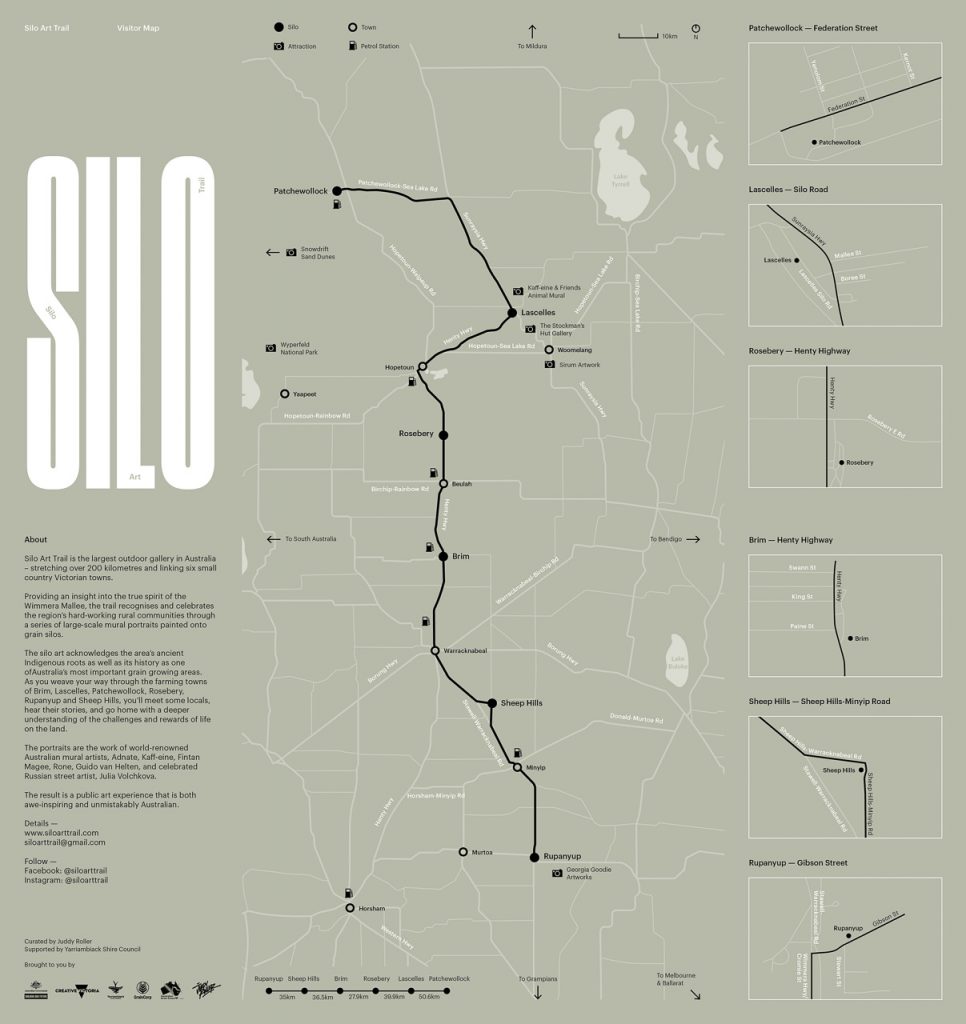
Map of Victoria’s Silo Art Trail. Courtesy http://siloarttrail.com/home/
Providing an insight into the true spirit of the Wimmera Mallee, the trail recognises and celebrates the region’s people through a series of large-scale mural portraits painted onto grain storage silos, many of which date back to the 1930s.
The national and international artists whose murals appear on the silos spent time visiting the region and meeting the locals before transforming each grain silo into an epic work of art. Each mural tells a unique story about the host town.
The level of detail the artists have achieved in their murals is impressive. Something I find astonishing given the scale of the artworks. How do you create such fine detail with an aerosol can?
The Silo Art Trail was conceived in 2016 after the success of the first artwork in Brim. What started as a small community project by the Brim Active Community Group to save their town from extinction resulted in widespread international media attention and an influx of visitors to the region. The idea for the Trail was born.
Whether in a car, motorhome or towing a caravan, parking is not a problem at any of the silos.
The Silo Art Trail website provides detailed information on other attractions to visit while in the area, including murals in some towns and painted silos at Nullawil, Goroke, Kaniva and Sea Lake. Taking in these additional painted silos extends the route to 330 kilometres from end to end.
- This is street art at its best.
- The murals are painted on unusual canvases.
- The silo artworks are in public spaces; in outdoor galleries open 24 hours a day / 7 days a week. And they are free to visit.
- It is artwork on a massive scale. How many paintings do you know that require an extended cherry picker to complete?
- The murals painted on the silos depict local community members, giving an insight into the area.
- Grain storage silos have been ‘painted’ on Australia’s landscape since the 1920s.
- Victoria’s Silo Art Trail is Australia’s ultimate road trip.
While you can travel the route in any direction, I will take you from Rupanyup in the south to Patchewollock in the north – the approach we took on our road trip.
-> From Melbourne to Bendigo is 151 kilometres (approximately a 2-hour drive). From Bendigo to Rupanyup is 169 kilometres (approximately a 2-hour drive)
-> From Melbourne to Ballarat is 112 kilometres (a 1-hour and 39-minute drive). From Ballarat to Rupanyup is 177 kilometres (a 2-hour drive).
As you can see, it is really neither here nor there as to whether you arrive in Rupanyup from Melbourne via Bendigo or Ballarat. My preference would be to travel via Bendigo, a historic gold mining town with some of the best food we had on the whole road trip. Historic Bendigo Pottery is worth a visit. Don’t miss Bendigo Pottery’s museum.
Other helpful distances:
> From Bendigo to Patchewollock is 284 kilometres. If stopping 30 minutes at each silo artwork, the entire trip would take approximately 6 hours, 11 minutes.
> From Ballarat to Patchewollock is 332 kilometres. If stopping 30 minutes at each silo artwork, the trip would take approximately 6 hours, 42 minutes.
> From Patchewollock to Sea Lake (possible accommodation option) is 73 kilometres – a 50-minute drive.
> From Patchewollock to Mildura (possible accommodation option) is 141 kilometres – a drive time of approximately 1 hour, 38 minutes.
> From Patchewollock to Swan Hill (possible accommodation option) is 145 kilometres – a drive time of approximately 1 hour, 36 minutes.
The distances from silo to silo:
- Rupanyup to Sheep Hills is 35 kilometres;
- Sheep Hills to Brim is 36 kilometres;
- Brim to Roseberry is 28 kilometres;
- Roseberry to Lascelles is 40 kilometres;
- and Lascelles to Patchewollock is 51 kilometres.
Rupanyup Silo Art by Julia Volchkova
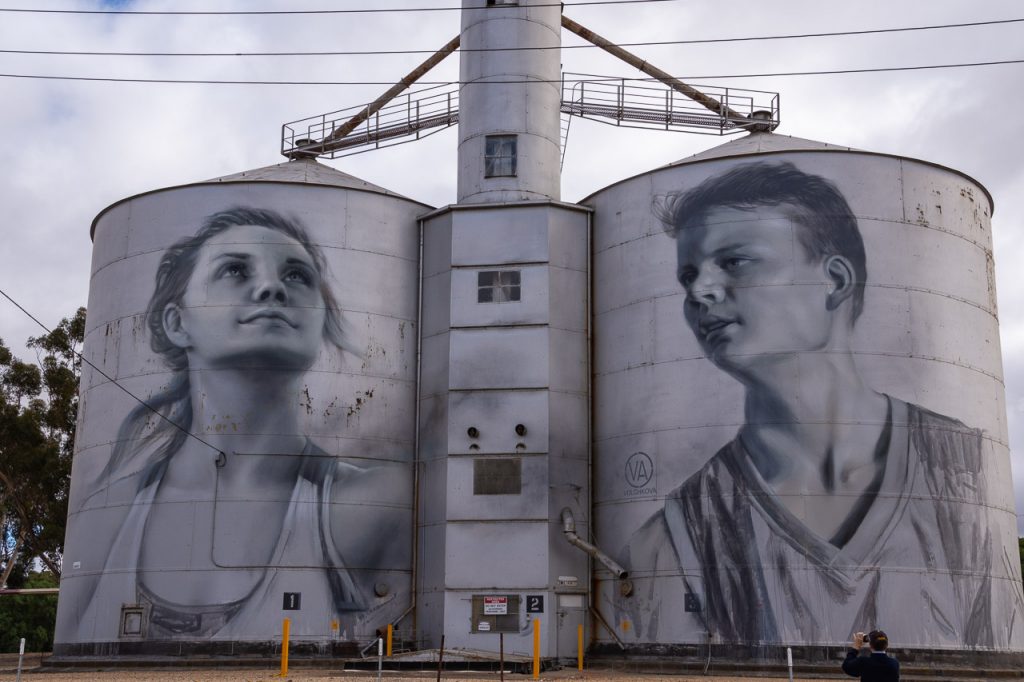
Rupanyup silo art of young people from local sporting teams on Victoria’s Silo Art Trail
Completed early 2017, the faces featured on the silos are those of Rupanyup residents and local sporting team members Ebony Baker and Jordan Weidemann. Dressed in their sports uniforms (netball and Australian Rules football, respectively), the mural captures the spirit of community while honouring the integral role that sport and community play in rural Australia.
Rupanyup’s silo art is the work of Russian mural artist Julia Volchkova. The monochromatic work is typical of Volchkova’s realist portraiture style. An avid traveller, her frequent travels have resulted in numerous large-scale murals of local people in Indonesia, Malaysia and elsewhere around the world.
Sheep Hills Silo Art by Adnate
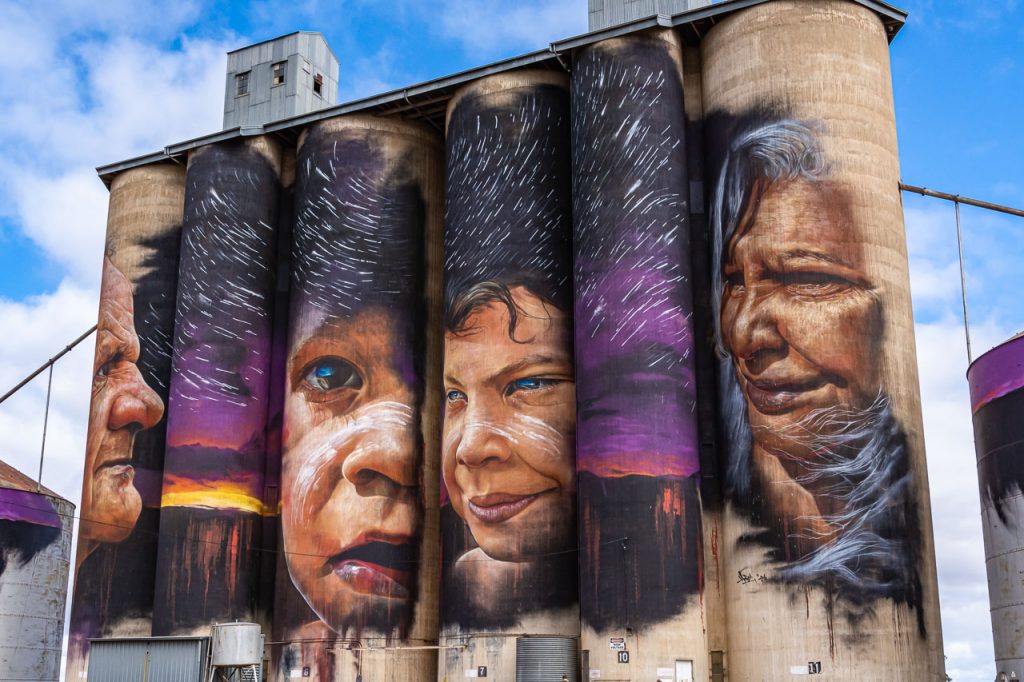
Sheep Hills silo art of Aboriginal Australians on Victoria’s Silo Art Trail
Melbourne-based artist, Adnate, uses his artwork to tell stories of Indigenous people and their native lands, particularly Aboriginal Australians. He painted the mural on the silos at Sheep Hills in 2016 after spending four weeks with the community. He found his inspiration for the mural after developing a friendship with the Barengi Gadin Land Council in North East Victoria.
Through his portraits of Wergaia Elder, Uncle Ron Marks, and Wotjobaluk Elder, Aunty Regina Hood, alongside two young children, Savannah Marks and Curtly McDonald, Adnate celebrates the richness of the area’s Indigenous culture.
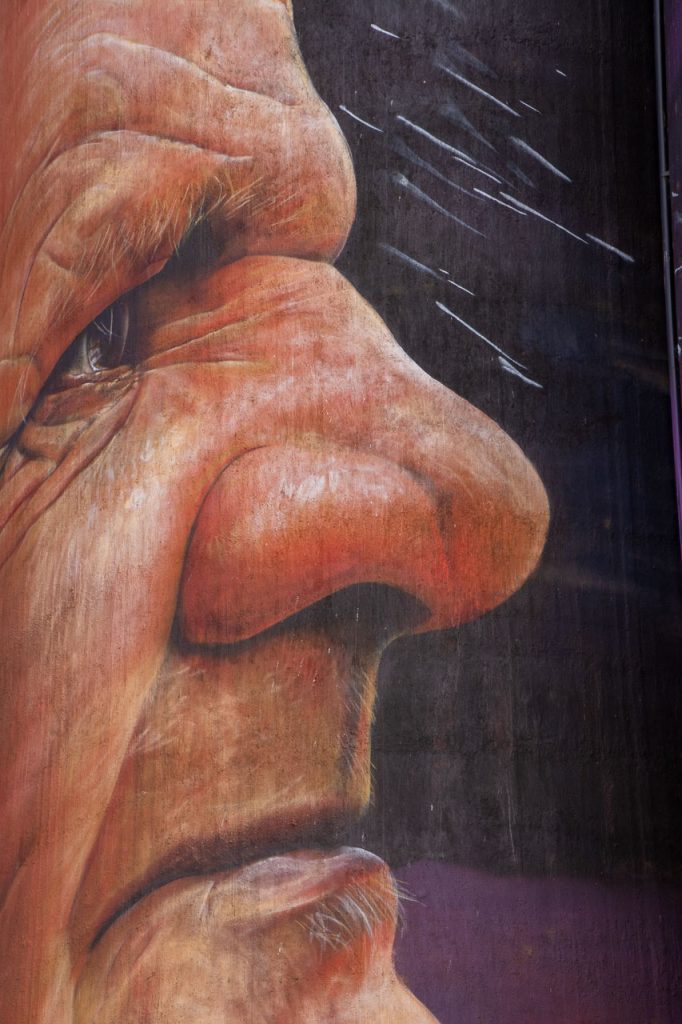
The night sky in the mural represents elements of local dreaming, and the overall image signifies the critical exchange of wisdom, knowledge and customs from Elders to the next generation.
Featuring a bold use of block colours via acrylic and spray paint, Adnate’s portraits are known for introducing an energetic presence to their surroundings. Described as “life-like” and “emotive”, his large-scale murals can be found in various settings throughout Australia and worldwide.
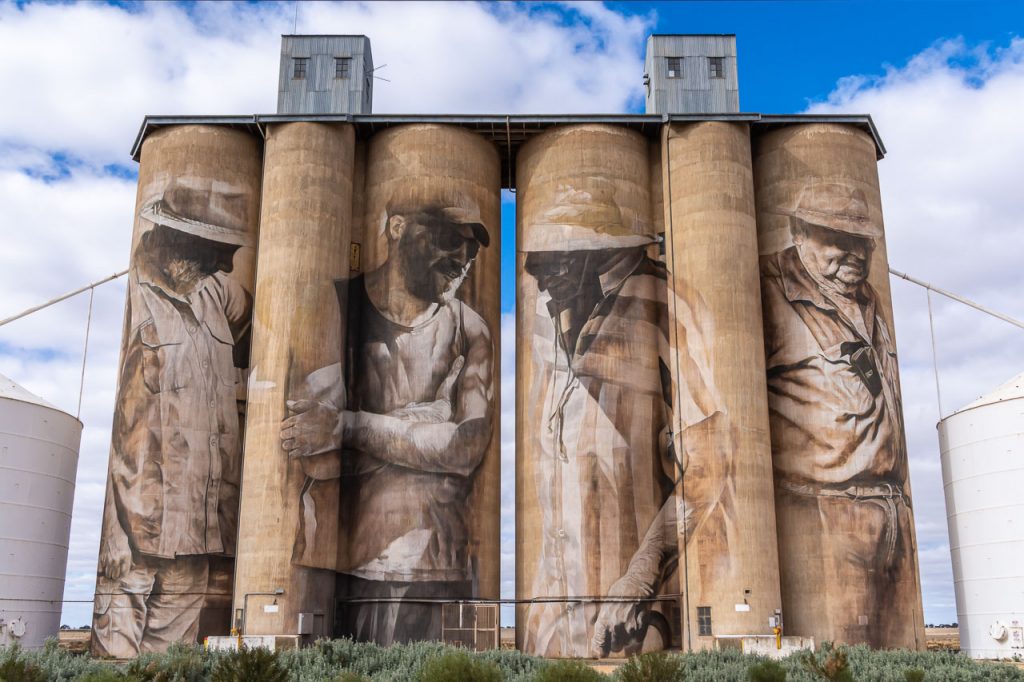
Brim silo art of multi-generational male and female farmers on Victoria’s Silo Art Trail
Although the third silo artwork along the Silo Art Trail (travelling from Melbourne), the mural painted on the disused GrainCorp silos at Brim, was the first to be painted in Victoria and was the inspiration for the Silo Art Trail.
Painted by world-renown Australian street artist Guido van Helten, his mural of four anonymous, multi-generational farmers (three men and one woman) was completed in January 2016. Guido’s subjects bear expressions that exemplify the strength and resilience of the local farming community as they face immense economic pressure and the tangible consequences of climate change. His work captures the spirit of the local area and connects the characters to their chosen place, infusing the landscape with a comforting, familiar presence.

Celebrating everyday characters in forgotten places, Guido’s monochromatic, photorealistic style offers an intimate glimpse into the lives of others. His large-scale portraiture murals are found throughout Europe, Scandinavia, the United States, and Australia. They tell stories of culture, history, and identity to capture the soul of people and place.
Rosebery Silo Art by Kaff-eine
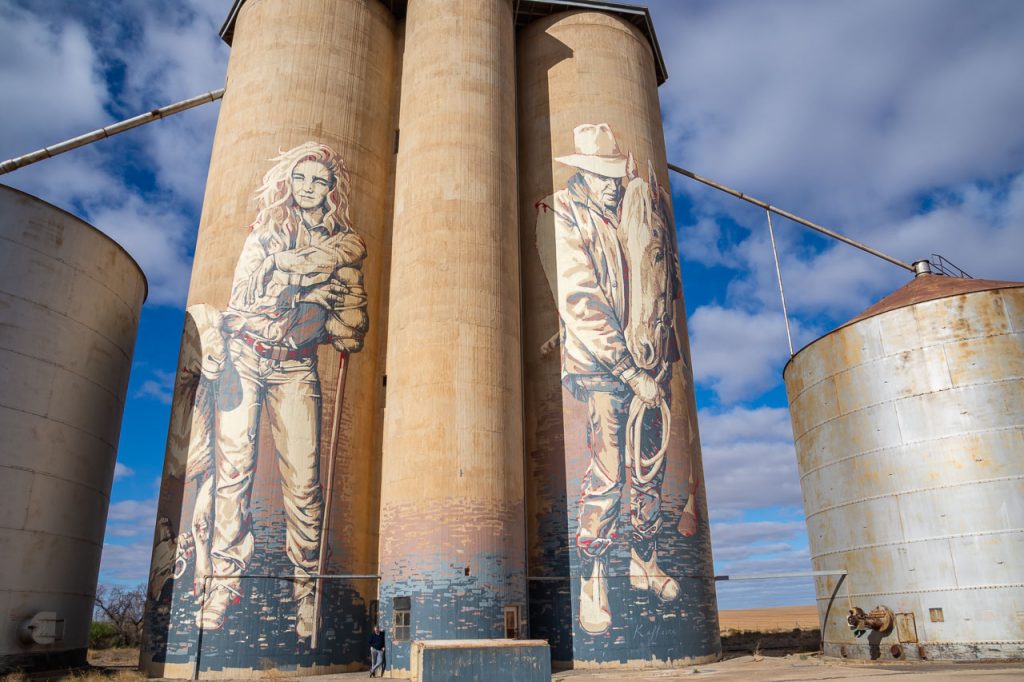
Rosebery silo art of female farmer and horseman with his horse on Victoria’s Silo Art Trail
The silo on the left captures the grit, tenacity and character of the region’s young female farmers, who regularly face drought, fires and other hardships living and working in the Wimmera Mallee. In her work shirt, jeans and turned-down cowboy boots, the young female sheep farmer symbolises the future.
The silo on the right portrays the strong connection between man and horse. The contemporary horseman appears in an Akubra hat, Bogs boots and oilskin vest – typical attire for Wimmera Mallee farmers. Both man and horse are relaxed and facing downward, indicating their mutual trust, love and genuine connection.
Completed in late 2017 by the successful, internationally renowned street artist, Kaff-eine, her Rosebery mural depicts themes that she says embody the region’s past, present and future.
Combining creativity with a strong social conscience, Kaff-eine makes art and film projects in marginalised communities around the world, with her work inviting audiences to engage with social and political issues. Kaff-eine describes her practice from photorealistic to darkly sensual stylised characters as “loaded with symbolism and narrative”.
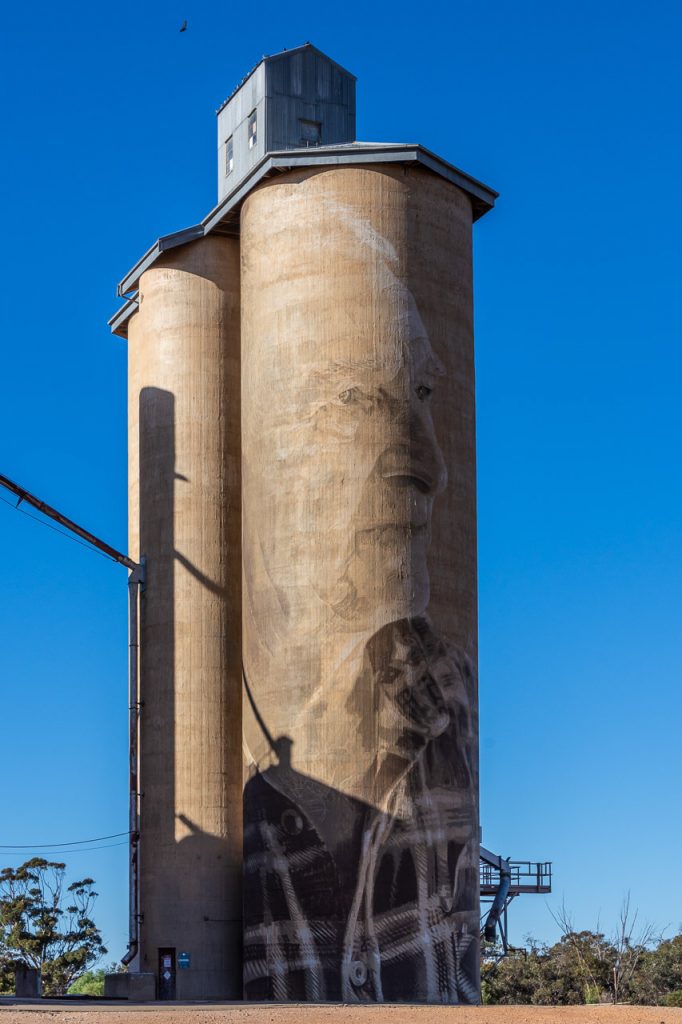
The artwork here of the local farming couple, Geoff and Merrilyn Horman can never be photographed together because they are painted on opposite sides of two grain silos.
The Horman’s are part of a family who has lived and farmed in the area for four generations. Painted by Rone in mid-2017, he wanted the mural to portray his subjects as wise and knowing, nurturing the town’s future with their vast farming experience and longstanding connection to the area.
Rone worked for two weeks to transform the two 1939-built GrainCorp silos. He went to great lengths to paint in the silo’s existing raw concrete tones to produce a work that would integrate sensitivity into its environment. Utilising this muted monochrome palette, he added water to his paint as a blending tool to create a ghostly, transparent effect – a signature of his distinctive painting style.
An influential figure in Australia’s early street art scene, Rone is perhaps best known for his large-scale “Jane Doe” portraits, featuring beautiful young women painted onto old, decaying backgrounds. This interplay between beauty and decay is a key theme throughout his work, emphasising the fleeting nature of beauty and encouraging audiences to appreciate it while it lasts.
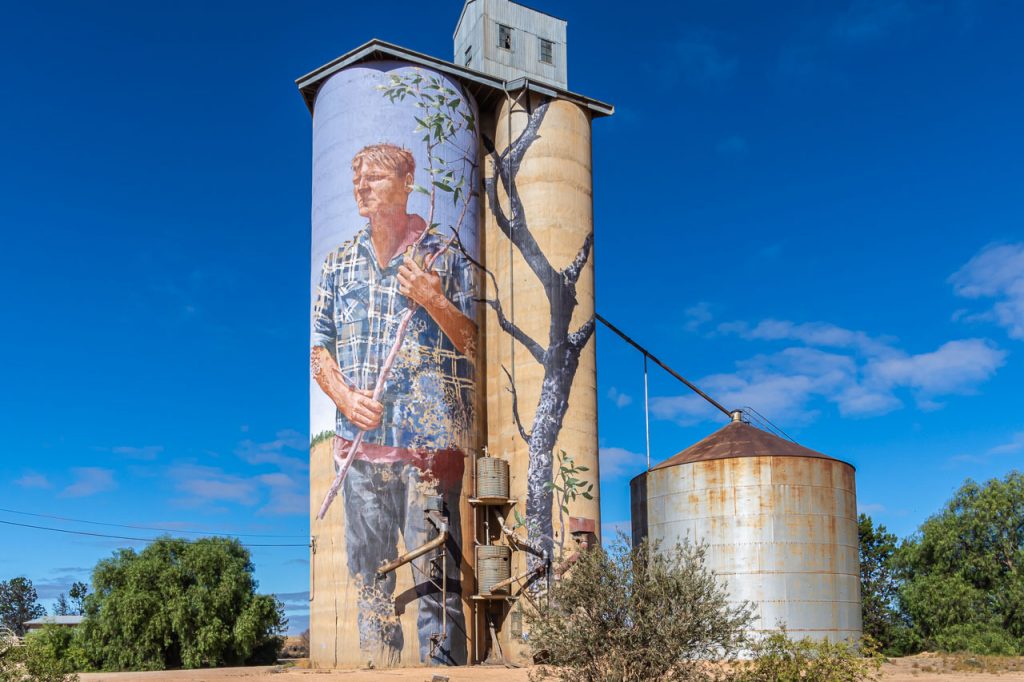
Patchewollock silo art of local farmer, Nick “Noodle” Holland on Victoria’s Silo Art Trail
To prepare his Patchewollock mural, Brisbane artist Fintan Magee booked a room at the local pub to immerse himself in the local community and to get to know its people. When he met local sheep and grain farmer Nick “Noodle” Hulland, Magee knew he had found his subject.

The face of local farmer, Nick Holland on the Patchewollock silo on Victoria’s Silo Art Trail
Why Nick Hulland? According to Magee, the rugged, lanky local exemplified the no-nonsense, hardworking spirit of the region. Perhaps more importantly, though, Hulland had just the right height and leanness to neatly fit onto the narrow, 35-metre-high canvas of the twin 1939-built GrainCorp silos.
Completed in late 2016, Magee’s depiction of the famously reserved Nick Hulland portrays the classic Aussie farmer – faded blue “flanny” (flannelette shirt) and all. Hulland’s solemn expression, sun-bleached hair, and squinting gaze speak to the harshness of the environment and the challenges of life in the Wimmera Mallee.
Combining surreal and figurative imagery with a trained artist’s discipline and technical skill, Magee’s work explores global themes and climate change, displacement and migration, as well as environmental issues such as his family’s experience in the devasting 2011 Brisbane floods. Understanding that not everyone has access to art galleries, Magee aims to make art more accessible to isolated communities and the general public.
Autumn, in my opinion, March to May, is the best time in Australia. The sting of intense heat wanes, the bush comes alive, the landscape changes colour, the desert sprouts, and the people wake from their summer stupor.
Sub-standard food (with a few exceptions), poor food choices due to limited options, or non-existent food outlets, was typical throughout the whole road trip. At one point, my sister noted in her journal that the food situation was making her unhappy as she was not eating well (and not from choice).
I make two suggestions here:
- Eat up big in Bendigo or Ballarat because it’s the last decent meal you will have until after you leave the Silo Art Trail; and
- Buy snacks in Bendigo or Ballarat before heading up the Silo Art Trail. If you find you haven’t bought enough or are sick of what you did purchase, you can stock up at the supermarket in Warracknabeal. We made the mistake of eating lunch at the local Chinese restaurant in Warracknabeal because that was what we felt like. Big mistake! However, the chocolate biscuits I bought at the local supermarket were yum and eaten before my sister could blink. Did she want some?
We had several good meals in Bendigo. Our first breakfast was at The Boardwalk on Lake Weeroona (28 Nolan street). The service was faultless, and the food here was so good we ate breakfast at The Boardwalk each morning of our stay in Bendigo. I couldn’t resist the Gourmet Fruit Loaf with Bacon.
Have lunch at The Rifle Bridge Hotel, 137 View Street, Bendigo. Talk about a yummy salad – Chicken and Macadamia Nut Salad with Beetroot, Pear and Figs.
For dinner, Masons of Bendigo, at 25 Queen Street, is a must. Plating is modern Australian, with all dishes (starters, mains and desserts) designed to be shared. We received excellent service from friendly, informative staff. Reservations are essential.
On our first night in Ballarat, we ate at The Forge Pizzeria (14 Armstrong Street) because it was recommended in the Ballarat tourist information booklet. The restaurant was packed, which is always a good sign. My sister enjoyed her pizza, but it was a poor food choice for me, as I am not keen on pizza.
The next day we had lunch at L’Espresso café (417 Sturt Street, Ballarat). A trendy café (people waiting to be seated) with efficient service and, we both commented, excellent food. That night, we ate at The Gallery Restaurant in the Craig’s Royal Hotel (10 Lydiard Street), where we stayed in Ballarat. We had mixed feelings regarding our meals here. I thoroughly enjoyed my main course and dessert. But my sister was not impressed with her meal.
In Rosebery, after viewing the silo art, we passed an old church 228 metres down the road with a sign out the front advertising scones and cream. This couldn’t be real! We were in the middle of nowhere! Turning around, we discovered the old church was now a café, Mallee Sunsets Gallery Café, and it did indeed have scones with jam and cream on its menu. We couldn’t resist. Together with the best ice coffee I probably have ever had (I watched her put six scoops of ice cream in my ice coffee), I was in heaven.
The story of this once Presbyterian Church brought home how much these small, remote farming communities are struggling. It stopped being a church in 1990 because there were only five people left in the congregation. The church’s closure divided the community as those five people then had to attend services in Warracknabeal or Hopetoun. Three went one way, and two went the other.
The final painted silo on our Silo Art Trail road trip was at Patchewollock. Looking to eat lunch after viewing the mural of Nick “Noodle” Hulland, we had two options: the café that only sold sausage rolls they could heat in a microwave, or the Pub. We settle for toasted sandwiches at the “Patche Pub”.
From Patchewollock, we headed to Sea Lake for two nights. At the time, the only meals available for dinner were dispensed from a vending machine at the motel and were disgusting. There were two cafes open for breakfast, but one closed at 5.30 pm (too early for dinner), and the other advertised they close at 8.30 pm. But not this night! They had two tourist coaches in town and had shut the café to all other people. The hotel in Sea Lake has been renovated and is now open for accommodation and meals. Bonus!
So, being very, very hungry by this stage of our latter travels, on our second day in Sea Lake, we drove 45 minutes to Spoons Riverside Café and Restaurant in Swan Hill for lunch. Spoons Riverside is in a beautiful location, overlooking the Murray River. I ate far too much, but the food was so yummy.
Being influenced by tourist information advising that Hopetoun is an excellent base for exploring the gigantic artworks that comprise the Silo Art Trail, we broke our journey for the night in Hopetoun. Both my sister and I strongly recommend you don’t do this. The only accommodation in town was very basic (that I can live with), but my room was filthy. On top of this, our food choices were minimal and tasteless.
The Quality Hotel Lakeside in Bendigo (our ‘home’ for three nights), at 286 Napier Street, is located opposite Lake Weeroona and a stone’s throw from ‘The Boardwalk’, where we had breakfast each morning. A modern hotel, our balconied rooms were very large, with a king-size bed, comfortable lounge, writing desk and tea/coffee making facilities. The hotel also had a guest laundry.
In Ballarat, we stayed at Craig’s Royal Hotel – 10 Lydiard Street, South Ballarat. Located in the historical part of Ballarat across the road from Her Majesty Theatre, this luxury boutique hotel was comfort-plus with an old-world charm. Craig’s Royal Hotel has been a Ballarat icon since 1853.
The drive, via the Silo Art Trail, from Ballarat to Sea Lake, at 405 kilometres, or from Bendigo to Sea Lake, at 357 kilometres, can be done in one day. This is not excessive and easily accomplished with plenty of time to view each of the silo artworks. Don’t make the mistake we made stopping for the night along the Silo Art Trail.
In Sea Lake, we stayed at the Sea Lake Motel on the Calder Highway (93 Railway Avenue, Sea Lake). Our room (the only time we shared a room on this road trip) was small and basic but clean. The now renovated Hotel (pub) on the main street in town may be a better accommodation option.
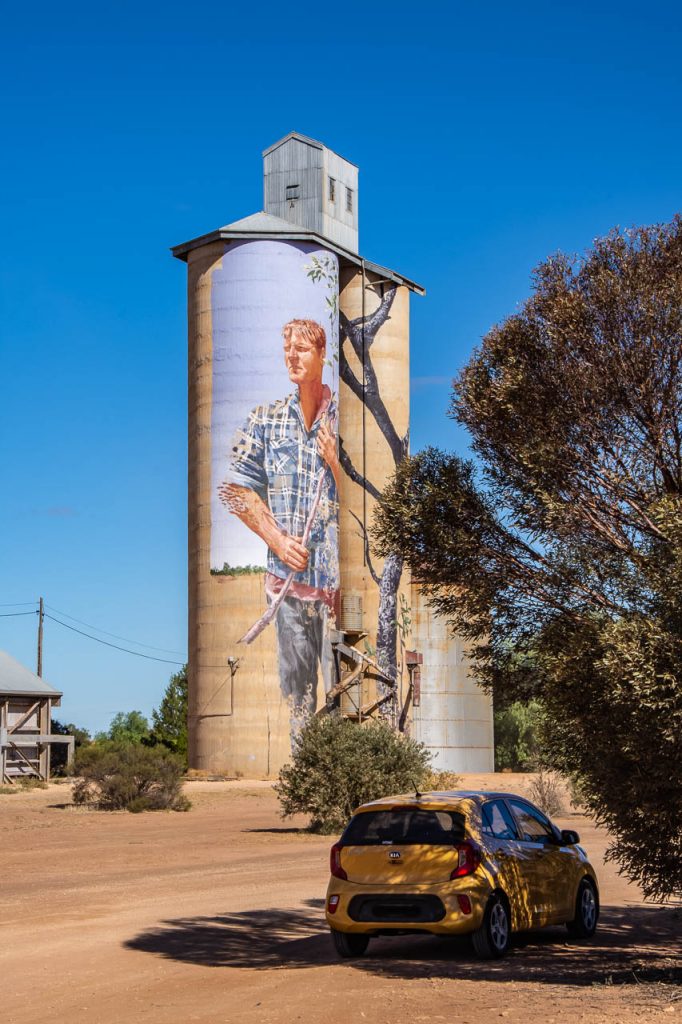
Patchewollock silo art of Nick Holland and car. The end of Victoria’s Silo Art Trail
What did surprise me was the lack of infrastructure to support tourism along the Silo Art Trail. I’m not referring to the roads. They were in good condition that my little car had no trouble traversing. If the Silo Art Trail has any hope of encouraging the financial sustainability of the towns in questions through tourism and saving them from extinction, then appropriate places to eat and sleep are crucial. We would have seen a maximum of 3 other couples visiting these painted silos. I can understand people are hesitant to open cafes and accommodation when the tourists aren’t there to generate a viable business enterprise. It’s a bit like which comes first, the chicken or the egg. What are your thoughts on this?
I want to leave you with a comment from my sister as she summed up her experience of the Silo Art Trail.
“At first, I was not overwhelmed by the silo art. But on reflection, the use of these giant canvases to reflect community has been interesting and something to remember. Some of them, and their place in the landscape, have affected me. It would be good to go back and look at them quietly and reflect on the landscape.”
For my sister, the people in the murals were of the landscape. A need to further examine the connection between landscape and the art themselves fuelled her desire to return to the Silo Art Trail.
Editor’s Note: This post was originally published in January 2020 and has been updated for accuracy and comprehensiveness.
Disclaimer: This post contains no affiliate links. All views and opinions are my own and non-sponsored. Unless expressly stated, all photos are my own and remain the copyright of Joanna Rath.
Comment below to share your thoughts on this blog post. Tell me which of the painted silos in this post is your favourite.
If you like this post, PIN it for keeps.
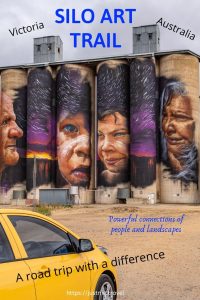
For more on Australia’s silo art, read:
Unique Silo Art Celebrates Local Communities and Fauna
3 of the Best Things to See and Do in Rochester
Author’s Note: Please check the latest travel restrictions before planning any trip, and always follow government advice.
You might also like...
5 of the best painted silos in new south wales, what is the missing truth about climbing sri lanka's little adam's peak.
Type on the field below and hit Enter/Return to search
Beyond Wild Places
Your guide to the wilder side of life
A Complete Guide to the Silo Art Trail in North West Victoria
The North West area of Victoria is one of Australia’s most important grain-growing regions. Fields of wheat, barley, rye and legumes stretch for hundreds of kilometres, with nothing interrupting the rows of crops except towering silos. Some of these silos are adorned with colourful and vivid artwork by renowned artists depicting various aspects of the local culture. Visiting each of these silos as part of the silo art trail in the Wimmera Mallee region is one of the most unique road trips in Victoria.
Silos have been a major part of the farming industry since around the 1930s and are often built alongside railway tracks for easy transportation of the harvested grain. Since 2016, there has been an ongoing effort to encourage people to visit these old farming towns in the Wimmera Mallee region and these painted silos have done the trick. While the Great Ocean Road gets the crowds, the Silo Art Trail is the perfect excuse for a road trip into Victoria’s much less visited north-west area.
I spent a week driving along the Silo Art Trail, visiting all eight of the current sites and staying overnight in the small towns along the way. If you want to take a trip to the Wimmera Mallee region and check out the Silo Art Trail, this blog has all the information you’ll need.
Disclaimer: This post contains affiliate links which means I get a commission if you buy a product through my link at no extra cost to you. By doing so, I can keep this blog going and continue to create helpful guides for you. Read more: Privacy Policy
About the Silo Art Trail
The Silo Art Trail in the Wimmera Mallee region of North West Victoria is considered the largest outdoor gallery in Australia. The trail includes commissioned murals on eight different grain silo sites across a number of rural towns.
The murals depict an insight into the local community and culture by world-renowned artists, who often spent weeks in the towns to gather inspiration for their pieces. The first silo in the region was painted in Brim in 2016 (which was also the second recognised silo art in Australia). After its incredible success at drawing visitor’s attention, the idea of the Silo Art Trail was born, and the subsequent art was commissioned. Sea Lake’s silos are the most recent addition, which were completed and joined the trail in late 2019.
The trail now extends from Rupanyup up to Patchewollock and across to Nullawil in North West Victoria. It’s been credited with breathing new life into these small rural towns which had otherwise very little appeal to visitors. The silo art has helped keep some of the pubs and general stores in these towns open with visitors stopping for lunch and supplies on their way through.

When to visit the Silo Art Trail
North West Victoria is great to visit at any time of the year. However, in summer you’ll most likely get some stinking hot days. When I visited in January there were a few days of high 30s, even pushing the 40-degree mark. The area is very dry, so the landscape will also be a sunbaked golden colour at this time. However, you’ll be blessed with clear blue skies and long daylight hours too.
Winter is the coldest time, but temperatures will generally be moderate in this part of Victoria. It does get a bit of rain, but if you time the weather right you can get some very clear days and beautiful sunrises.
Autumn and spring would be the best seasons to visit the Silo Art Trail. This is when you’ll get the best weather and very few other people visiting outside of the holidays.

How to get there
The Silo Art Trail is a great self-drive road trip in Victoria. You’ll want to set aside at least a couple of days to really enjoy the region, as it’s quite a long drive from Melbourne.
The closest silo art to the city is at Rupanyup, which is 289km or just over a three-hour drive from the CBD. This is where most people choose to start the art trail as the other sites are all north from here.
The northernmost silo art is in Patchewollock, which is 160km north of Rupanyup. From Patchewollock, the trail heads east to finish in Nullawil, which is another 120km away.

What you need to know before you go
The Silo Art Trail is not something you want to try and do as a day trip from Melbourne. There’s lots of driving to be done from one silo to the next and if you plan on taking in all eight sites, you’ll be driving many hours. It’s best to break the trip up and allow at least two days, or longer if you want to enjoy some other parts of the region.
Each silo town, as well as others in between, generally have a pub and general store for essential supplies. You can also find a few fuel stations along the way, although most are basic and tend to be part of the general stores. It’s important to note that you can’t always assume that these places will be open all the time, so make sure that you’re well-stocked.
These tiny towns are very quiet with sparsely populated farms surrounding them, so shops are not always open regular hours like you might be used to in the city. Make sure you have enough fuel in the tank and water and snacks with you. In saying that, it’s also a good idea to plan to spend some money in these towns and support the local community . Have some lunch at the pub or grab a cold drink from the general store.
Most towns also have small picnic areas with public toilets as well. These are generally well maintained and cleaned by the council but you might want to carry some toilet paper with you just in case.
There’s plenty of signage and parking areas around each silo. You won’t struggle to find your way around. The silos stand out from across the horizon, so it’s hard to miss them.
I visited the area in mid-January, and it was relatively quiet. I saw a few other cars at some of the silo art spots, but in general, the roads are extremely quiet and the towns are peaceful places.

Where to stay on the Silo Art Trail
If you want to stay along the trail, there are some great campgrounds. The road trip is really ideal for those with caravans or campervans, as you’ll find some cheap community-run places, some even with powered sites. If you’ve got the Wikicamps app , you’ll find the overnight camping spots easy enough.
For those looking for some more comfort, there are also other accommodation options. Many of the pubs offer basic rooms, which would be your best bet in many of these small towns near the silos. Sea Lake has some particularly great accommodation options, with rooms at the Lake Tyrrell Accommodation starting at $120 per night.
If you want to be close to shops and a more bustling area, you can also stay at larger towns such as Bendigo or Horsham which are still within easy reach of the silos. If you stay at Horsham, you could even complete the silo art trail in one long day from there as it’s quite close to Rupanyup. However, I recommend breaking it up for at least a night on the trail, so you can appreciate the region.

Where to eat on the Silo Art Trail
On the Silo Art Trail itself, self-catering is a great option, as there are plenty of general stores and IGA supermarkets on the way to stock up on supplies. However, it’s also a good idea to try and support some of the rural pubs by having a meal at the bar.
A favourite stop on the Silo Art Trail is Mallee Sunset Gallery in Rosebery. This old, converted timber church is now a café and gift shop run by a beautiful local lady right across from the silo art in Rosebery. She claims to make the best iced coffee in the region. She’s only open Wednesday to Sunday from 9am to 5pm. It’s considered a must-stop on the Silo Art Trail.
Silo Art Trail and towns on the way
I’m going to run through all eight of the current silo art sites and the towns along the way. It’s most convenient to begin in Rupanyup, which is closest to Melbourne, so heading north from there, these are all the places you need to know about.

Rupanyup silo art
The two greyscale portraits on Rupanyup’s twin steel silos are the work of Russian mural artist, Julia Volchkova. The silo art depicts two youth from the town, a female in netball gear and a male in an AFL uniform. The monochrome work was completed over several weeks in 2017 and represents the town’s youth and their love of sport.
Rupanyup town
The town of Rupanyup is a quiet farming community. The name comes from the Aboriginal word meaning ‘branch hanging over water’. The town layout is unique in that it has a wide medium strip down the main street. Many of the town’s shops appear old and rundown but this just showcases the history of the settlement. It’s known as the ‘town with pulse’ because its farms specialise in lentils, chickpeas and beans, instead of the wheat in other nearby towns.
Where to stay | You can stay at the public campground at the central Memorial Park. It’s $10 per night for a powered site on a large gravel area and they have hot showers and toilets.
Where to eat | The Kindness Kitchen is a 100% vegan café, one of the only such cafes of its kind in the entire region of Victoria. It’s relatively new to town, and open from 8.30am to 3.30pm from Thursday to Sunday. Definitely the trendiest café on the Silo Art Trail.

Sheep Hills silo art
The vivid mural at Sheep Hills silo was completed by popular Melbourne-based artist, Adnate, in 2016. He spent several weeks in the community and he sought to emphasise the area’s Aboriginal history and connection through his work. These silos are one of the most stunning sights on the whole trail. The entire silo structure is decorated with the portraits of Wergaia Elder and Wotjobaluk Elder alongside two young children, with the background being a deep purple night sky which is meant to depict the local dreamtime stories.
Sheep Hills is almost a non-town now and the silos seem to be standing lonely in the middle of nowhere off the side of the road.
Warracknabeal
Although this town doesn’t have a silo art attached to it, it is worth knowing that it’s the main service town for the Wimmera Mallee area. If you’re after any supplies, you’ll be able to get it here with an IGA supermarket, a few cafes and take away shops, petrol stations and banks.
Where to stay | Country Roads Motor Inn is a comfortable motel with an outdoor pool and large rooms.
Where to eat | The Creekside Hotel is the popular choice in town for a feed and a drink. It has a nice restaurant feel rather than a traditional pub, but you’ll find plenty of nice pub meals on the menu.

Brim silo art
This now iconic silo art was the first to be completed in Victoria and the original inspiration for the Silo Art Trail. Completed in 2016, Guido van Helten’s mural depicts an anonymous multi-generational quartet of farmers. It was intended that the mural represent the strength and resilience of the community in the face of hardships.
It’s one of the only silo art sites to be lit up at night, so if you’re staying nearby it’s a good chance to catch a different view of it.
This tiny wheatbelt town became well-known after the first silos were painted here in 2016. It’s since become a popular place to stop for the night, as it’s nicely located in the middle between Rupanyup and Patchewollock.
Where to stay | There’s a great campground on the banks of the Brim Weir Pool, which has toilets and showers and access to powered sites. It’s $10 per night and is a great bush setting at the back of the town.

Rosebery silo art
Melbourne artist, Kaff-eine spent time exploring the Mallee region before completing this mural in late 2017. She depicts two typical characters of the region in her work. The first silo is painted with a young female farmer and on the right silo, a horseman sharing a moment with his steed.
Don’t forget to drop into the Mallee Sunset Gallery just on the opposite side of the road to the silo for an iced coffee!
Although not being home to any of the silo art sites, Hopetoun is a nice town to stop and pick up some supplies. There is a 24-hour unmanned fuel station, an IGA store, local petrol station and nursery, and a couple of cafes and, of course, the pub.
Where to stay | Lascelles Lake just next to town is a popular holiday destination and a great place to camp if you have a caravan or campervan. There are a few limited powered sites, otherwise you can camp anywhere for free along the banks of the lake.
Where to eat | Hopetoun Café is your regular small-town café that serves burgers, fish and chips, coffee and cake. It’s right on the main street and often the only place open for some food.

Patchewollock
This colourful silo art was done by Brisbane artist, Fintan Magee, in late 2016. He stayed at the pub to meet the locals and find a muse for his work. He found it in local sheep and grain farmer, Nick Hulland, who he painted on the silo as an embodiment of the archetypical Aussie farmer.
Patchewollock town
Patchewollock is a very quiet little town. It’s in close proximity to the Wyperfeld National Park, with most people passing through town on the way to the snow drift sand dunes. The general store was the only thing open when I was there, and the lady was very friendly. The pub is open from 5pm every night, and occasionally for lunch.

Lascelles silo art
The Lascelles silos were the blank canvas for Melbourne-based artist Rone. He decided to depict local farming couple Geoff and Merrilyn Horman, part of a family that have been farming in the area for four generations.
His distinctive painting style means that the monochrome artwork blends into the concrete silo’s environment. The first silo you see from the car park is of Geoff, while you have to walk around the other side to find the portrait of Merrilyn.
This tiny town has a pub and a general store and that’s about it. Still, it’s a great place to stop for a meal or stay overnight, with the pub being open from around 10am until 8pm every day, later on weekends.
Where to stay | The Lascelles pub operates self-contained cabins for an overnight stay, starting from $80 per night. If you have a camping setup, the picnic area across from the pub has powered sites for $10 per night with hot showers and toilets (pay at the pub, of course). I camped here for the night and would happily do it again as it’s right across from the silos.
Where to eat | It’s all about the pub in Lascelles. They serve regular pub food and pizza.

Sea Lake silo art
These are by far the most colourful and vibrant of the silo art in the Wimmera Mallee region. The incredibly beautiful artwork depicts a girl swinging over Lake Tyrrell, with the bright colours of a sunset or sunrise over the background. It was completed by two artists, Drapl and The ZooKeeper.
Silo Lake town
Sea Lake is a colourful little town on the Calder Highway. It’s a nice place to stop with a small supermarket, pharmacy, petrol station and of course, a pub. It’s worth taking the detour from town out to Lake Tyrrell, and even better if you can get out there for sunset.
Where to stay | For camping, the Sea Lake Travellers Rest park area has overnight camping options with $20 for a powered site ($15 for solo travellers!) or $10 for unpowered. For something more comfortable, Lake Tyrrell Accommodation offers a range of rooms starting from $120 per night.
Where to eat | The Bottom Café on the main street is a popular little place. Pretty standard take-away and eat-in options such as burgers, sandwiches and wraps, with a popular breakfast menu.

Nullawil silo art
The final silo art in the trail is at Nullawil. The artwork there was done by Australian street-artist Smug. It is a photo-like depiction of a farmer and his Kelpie, with the emphasis being on the working dog, and was completed in 2019.
Nullawil town
This tiny town is located right on the Calder Highway. There’s a little general store if you need supplies, but otherwise the town is a pretty quiet one.
Things to see near the Silo Art Trail
If you’ve got more time, you may as well make the most of this region of Victoria. There’s a few other places that are worth exploring near the Silo Art Trail and can easily be added onto your trip.

Lake Tyrrell
Lake Tyrrell is a shallow, salt-crusted depression in the heart of the Mallee region. It’s just seven kilometres north of Sea Lake and is worth a detour off the Silo Art Trail. It’s Victoria’s largest salt lake and is ancient at almost 120, 000 years old.
There is evidence of local Aboriginal people occupying the land around the lake for 45, 000 years. It’s part of the land of the Boorong clan, who are renowned for their astronomy and stargazing. The name of the lake is derived from the local Wergaia word for ‘sky’ in recognition of its importance for local dreamtime stories. It is known for being one of the best places in the country to view the night sky, so if you’re a keen stargazer this is a place you’ll want to visit.
There is an unmanned visitor centre, toilets and viewing platform at the lake. You can also continue driving past this centre on a dirt road and you’ll come to a car park area out on the lake where you can take photos of the salt crust.
Over 100, 000 tonnes of salt is extracted from the lake each year, but most of the operations are well away from the visiting area.
The best time to visit Lake Tyrrell is sunrise or sunset when you can witness the incredible colours. There are also stargazing lounges supplied at the end car park, if you want to return after dark.

Wyperfeld National Park
If you have a 4WD and a bit of extra time up your sleeve, you might want to explore Wyperfeld National Park. If you head west from Patchewollock, you’ll get to the snow drift sand dunes and camping area.
They are the biggest sand dunes in the national park and are great to check out, especially at sunset time. The campground there is managed by Parks Victoria.
Grampians National Park
The Grampians is one of Victoria’s most spectacular and popular national parks. The rugged mountain landscape is well-known for its hiking trails and waterfalls.
You might be surprised to learn that Halls Gap (the main town at the heart of the Grampians) is just 75km south of Rupanyup, where the Silo Art Trail begins. If you have the time, you can easily extend your road trip to include both the Grampians National Park and the Silo Art Trail.
Check out my travel guide to the Grampians and the best day hikes in the Grampians to plan your trip.

Bendigo is an old gold rush boom town that has become one of the largest rural cities in Victoria. It’s a nice place to stay the night or spend a weekend, with a lot of history and art to explore in the area. The Bendigo Art Gallery, Central Deborah Gold Mine and Golden Dragon Museum are all worth visiting if you have the time.
Check out some accommodation in Bendigo here .
More silo art
If you’re not sick of silo art yet, then I have some good news: there’s plenty more to see in Victoria! Near Bendigo, you can check out two silo art sites, one at Rochester and the other at Colbinabbin.
If you want to do another silo art road trip, then North East Victoria also has a shorter silo art trail which is north of Benalla.

Suggested silo art trail itinerary
Over two nights, you can explore the whole Silo Art Trail at a comfortable pace. Here’s my suggested Silo Art Trail itinerary.
Day 1: Melbourne to Brim
Begin your drive from the city and head for Rupanyup, the start of the silo art trail. It’s a long three and a half-hour drive, so take a break in Ballarat on the way.
Check out the silo art in Rupanyup, and then continue driving up the road towards the next silo. You’ll pass through the small town of Minyip, before arriving in Sheep Hills. Stop to admire the beautiful silo art here and then continue on towards Brim.
You’ll pass through Warracknabeal, so you can stop here for some supplies at the local IGA. As you come into Brim, you can check out their silo art site and then stay the night at the town’s great public campground.
Day 2: Brim to Lascelles or Sea Lake
Continue the next day through the town of Beulah onto Rosebery. Stop to take a look at the silo art here and don’t forget to stop at Mallee Sunset Gallery for morning tea.
Continue your drive onto Hopetoun. This town has a great IGA, a couple of cafes and petrol station if you need supplies.
Keep driving north to Patchewollock, the northernmost silo art on the trail. Check out the impressive artwork here and then head southeast to Lascelles.

Stop in Lascelles to have a look at the silo art here. If you’re weary, stay the night at the campground next to the Lascelles Hotel or in the hotel’s rooms.
If you’re keen to continue on, you can keep driving to Sea Lake for the night. There’s a campground here too or you can stay at Lake Tyrrell Accommodation just outside of town. If you do choose to stay in Sea Lake, you have to head out to see Lake Tyrrell at sunset or sunrise, or both!
Day 3: Back to Melbourne
If you stayed at Lascelles, drive onto Sea Lake to check out the silo there and the colourful main street. Take a side trip to Lake Tyrrell and enjoy the vast expanse of the salt lake.
From Sea Lake, head down the Calder Highway and don’t forget to stop in Nullawil to check out the last silo art stop on the trail.
From Nullawil, you can head back to Melbourne. It’s a long 300km or three and a half-hour drive back, so stop in Bendigo for a break if you need.
Pin this post

Share this:

Overnight Hike to Lake Tali Karng from McFarlane Saddle

10 Best Places to Stay on Phillip Island

Discovering the Waterfalls on Lady Talbot Drive in Marysville

A Complete Guide to the Great Ocean Walk (2024 Update)
[…] West Victoria. I spent a few weeks exploring the lesser known, rural part of the state, with the Silo Art Trail being the main […]
Woomelang is a lovely little town not far north east of Hopetoun. It has 8 painted mobile silos situated around the town. There are 2 great free camping areas to choose from.
[…] Read more: Complete Guide to the Silo Art Trail in Northwest Victoria […]
Leave a Reply Cancel reply
Discover more from beyond wild places.
Subscribe now to keep reading and get access to the full archive.
Type your email…
Continue reading
Email a Friend

- Road Trips and Itineraries /
- Echuca Moama Silo Art Trail
Explore Victoria's silo art in Echuca Moama & District
Total driving time, excluding stops, is approximately 3.5-4 hours.
Echuca Moama & District is home to many of Victoria's silo and water tank art installations.
Watch the video, download the map , and follow the trail below. Explore the many art and cultural attractions along the way.
Allow a full day to explore the Silo Art Trail itinerary below. Stopping for lunch at a winery or break it up into two half-day drives.

DOWNLOAD BROCHURE & MAP HERE
Approx. 25 mins drive
Travel to Rochester to view the Rochester GrainCorp Silos , which were the first art silos painted in the Echuca Moama region. Artist, Jimmy Dvate, completed the first two silos in 2018, which feature two threatened local species - the azure king fisher and the wrist-winged squirrel glider. A third silo was painted in 2022, featuring a duck-billed platypus. 18 Ramsay St, Rochester
Iddles Lane : Former Victoria Police homicide detective, Ron Iddles, has been commemorated in his hometown of Rochester. The Iddles Lane mural was painted by Tim Bowtell and celebrates the achievements of one of the state’s most respected detectives.
Rochester Mural Park : Located off Moore Street in Rochester, Mural Park features a selection of 2.1m x 4.8m murals created as part of the annual Rochester Mural Festival.
New murals are added each year.

Rochester to Colbinabbin Approx. 25 mins drive
The six-silo art mural in Colbinabbin was painted by Tim Bowtell in 2020, and re-tells significant moments from the town’s history, including its important links to agriculture, community, environment and the construction of the railway. Station St, Colbinabbin.
Feeling peckish?
Stop by the Colbinabbin General Store to pick up a coffee and bite to eat, or for a more hearty meal, head to the recently renovated Colbinabbin Country Hotel.
Colbinabbin to Heathcote Wine Region/Toolleen Approx. 20 mins drive
Famous for its robust shiraz, superb cabernet sauvignon, ancient red cambrian soils and tranquil bush setting, the Heathcote wine region is a prestigious Australian wine region, with a number of wineries located just 15 minutes drive from Colbinabbin.
We highly recommend Tellurian Wines , Peregrine Ridge , and Domaine Asmara in Toolleen; Silver Spoon Estate in Mt Camel; and The Shiraz Republic in Cornella.

Kyabram Water Tank Art, Cnr Drum & Union St Kyabram

Girgarre Sound Trail
Toolleen to Kyabram (via Stanhope & Girgarre) Approx. 70 mins drive
The Kyabram Art Water Tank , owned by Goulburn Water, is the most recent addition to the Echuca Moama region’s silo art trail, being painted by Jimmy Dvate in January 2021. It features the Kyabram Fauna Park wetlands and some of the wildlife that inhabit them, including the eastern long neck turtle, golden whistler, red-capped robin, yellow crimson rosella, Major-Mitchell’s cockatoo, endangered plains-wanderer, spotted-tail quoll, blue skimmer dragonfly, brolga and a bush tone-curlew. Crn Union & Drum St, Kyabram
- Kyabram Town Hall Gallery: Housed in the historic town hall building, the gallery is one of the largest in the region and showcases regional artists, touring exhibitions and a changing exhibition program of vintage clothing.
On the way
Visit Stanhope: call into the Many Makers Gallery; and view the Fonterra Mural, which features thousands of individual photos that create one enchanting artwork. The recently painted Montevideo Maru Mural, by Tim Bowtell, pays tribute to all those who perished in Australia's largest maritime disaster, including three men from Stanhope. 15 mins drive from Kyabram
- Visit Girgarre: Explore the Girgarre Sound Walk, a hands-on musical journey through town using repurposed materials to create interactive musical instruments, and take a stroll through Gargarro Botanic Gardens and event space. If you happen to be in town on for the monthly Girgarre Markets , you will be able to meander through the 120 market stalls selling local produce, arts and crafts. 15 mins drive from Kyabram, 8 mins drive from Stanhope
Kyabram to Tongala Approx. 15 mins drive
Visit the small town of Tongala and marvel at the 40+ street murals painted on buildings and fences around the town centre. The Hay Bale Trail also pops up at Christmas and Easter, with local artists and farmers coming together to add even more colour to this artistic town.

Tongala street mural

Picola Art Silo, 25 Moram St Picola
Tongala to Picola Approx. 40 mins drive
Visit the Picola Art Silo , painted by Jimmy Dvate in 2020. It features the culturally significant Barmah National Park and some of the wildlife that calls it home. The silos are still operational and located on private land, however can be viewed from the roadside. 25 Moran St, Picola
Picola to Echuca Moama Approx. 40 mins drive
Return to Echuca Moama and end you day with a food & wine experience at one of our riverside wineries, contemporary restaurants, historic pubs, or relaxed clubs.
- Customs House Gallery
- Foundry Arts Space
- Whistlestop Gallery
- Alton Gallery
Museums
- Port of Echuca Discovery Centre
- Echuca Historical Society Museum
- Chanter Estate Military Museum
- The Great Aussie Beer Shed &Heritage Farm Museum
Outdoor art
- David Maughan’s Les Belle Helen II sculpture in the Moama Botanic Gardens
- Geoff Hocking’s Long Paddock sculptures near the Moama Kerrabee Sound Shell
- Timber Cutters sculptures at Edward River Bridge picnic area
- Corey Thomas’s Long Paddock sculptures at the Mathoura Visitor Information Centre
- Jimmy Dvate’s mural on the side wall of the Gunbower Hotel.
Book your stay in Echuca Moama

Junction Moama

Book Accommodation

Book an experience

Wine, dine & So Much More

Road trips & itineraries
Receive Echuca Moama deals, travel inspiration, upcoming events and more...
- Retail stores
- Fuel prices
- Help & support
Victoria's Silo Art Trail: how to explore Australia’s biggest outdoor art gallery

Nicola Dowse
Posted June 05, 2023
Spanning 700-kilometers and featuring works by Rone, Adnate, and other iconic artists, discover Australia’s largest outdoor art gallery on this unique Victorian road trip.
Australia is home to plenty of big things : big prawns, big merinos, and big bananas. The location of each big thing often plays homage to the local industries or landscape. Given that, it makes perfect sense that Victoria, often referred to as the cultural heart of Australia, is home to the country’s biggest outdoor art gallery.
The Silo Art Trail has been turning heads on dusty regional roads since 2016 with its 700km-long collection of massive street artworks celebrating the people and culture of Victoria’s northwest.
Originally a region known for its agriculture industry, the project has injected new life into rural towns and encouraged tourism to the areas, along with providing economic benefits for the local communities and gifting Victoria one of the most unique road trip routes in the country.
Follow our guide on the best way to visit Victoria's Silo Art Trail.
How to visit the Silo Art Trail
There’s no hard and fast way to explore the Silo Art Trail, and the route you take can be altered depending on how long you have and what works you want to see. The one thing you will need, however, is a vehicle.
If travelling from Melbourne, Bendigo, Ballarat , Geelong or Victoria's east, it’s advised tourists begin with the Rupanyup silo before heading north towards Sheep Hills, Brim and Rosebery. Once you hit Hopetoun, you’ve the choice to continue north to Patchewollock, west to Albacutya, or east to Lascelles and Sea Lake.
From Melbourne, it's roughly a 3.5 hour drive to Rupanyup, where you can elect to stop at the RACV Goldfields Resor t in Creswick on your way home.
Alternatively, you can tackle the trail by flying into Mildura, hiring a vehicle, and approaching the trail from the north, beginning with Patchewollock. Those driving from Adelaide can start the trail from Kaniva.

If you don't have time to see all the silos, driving from Rupanyup through to Lascelles lets you encounter five of the main works.
Highlights of the Silo Art Trail
With more than 15 works (and growing), it’s hard to single out just a few silos. There are, however, a few key works you can't miss:
Rupanyup silo art by Julia Volchkova
The Rupanyup silo is the first many tourists will encounter. The silo was created by Russian muralist Julia Volchkova, who was inspired by the town’s youth, and their enthusiasm for team sports in particular.
Like many Victorian towns, Rupanyup has its own football and netball clubs, with Volchkova choosing to portray local sports club members Ebony Baker and Jordan Weidemann on the silos.
Brim silo art by Guido van Helten
This huge mural by photorealistic street artist Guido van Helten and Juddy Roller was the artwork that started the entire Silo Art Trail. The work was completed in 2016, and soon after brought international attention to the small town of Brim (which has a population of just 181 people).
The mural depicts four fictional farmers intended to represent the resilient farming community of the Wimmera region, and was also nominated for the 2016 Sulman Art Prize (Australia’s leading genre, subject or mural painting prize delivered alongside the Archibald Prize by the Art Gallery of NSW).
Lascelles silo art by Rone
Victorian street artist Rone, known for his large-scale installations in abandoned and decaying buildings, chose to depict two Lascelles locals in his silo artwork. Farming couple Geoff and Merrilyn Horman who have lived in the area for four generations are the subjects of the huge mural, which has been created on silos that date back to 1939.
Their portraits have been created in Rone’s signature washed-out style of realism painting that makes the works appear as if they’ve organically risen out of the silo’s concrete walls.
Like many Victorian towns, Rupanyup has its own football and netball clubs, with Volchkova choosing to portray local sports club members Ebony Baker and Jordan Weidemann on the silos.
Rosebery silo art by Kaff-eine
This Melbourne street artist actually assisted with Rone’s silo work in Lascelles, and used this time to explore and learn more about the land and people of the Wimmera-Mallee region.
She then took this knowledge and created her own silo artwork in Rosebery, painting a mural intended to portray the region’s past, present and future. On the left, Kaff-eine painted a female farmer, a nod to the many women who work the land in the region and their tenacity against nature. On the right, she painted a tender moment between a man and his horse, dressing the man in items common to the area such as an Akubra and oilskin vest.
Sheep Hills silo art by Adnate
Adnate is no stranger to painting huge murals, having created the southern hemisphere’s tallest street artwork on a Collingwood public housing tower in 2018. His silo artwork in Sheep Hills is the result of his friendship with the Barengi Gadjin Land Council, and the four weeks he spent getting to know this community.
The mural portrays Wergaia Elder, Uncle Ron Marks, and Wotjobaluk Elder, Aunty Regina Hood alongside two children, Savannah Marks and Curtly McDonald, in a work that speaks to the local dreaming as well as the passing of ancestral knowledge between generations.
Help is never far away Be prepared for road trips with RACV Emergency Roadside Assist →
Related reading

The best day trips from Melbourne

The ultimate guide to Kryal Castle

The best things to see and do in Ballarat for free
This site will not function correctly without JavaScript enabled. Please enable JavaScript in your browser.
We use cookies and other technologies to understand and improve your browsing experience. By using our site, you agree to us collecting this information and to our Privacy Charter .
Explore Victoria’s little-known Silo Art Trail
Emily Murphy
Social Media Manager & Writer
22 July 2022
Get ready to marvel at the large-scale murals along the Silo Art Trail in Victoria.
Stretching over 200 kilometres, Victoria’s Silo Art Trail is Australia’s largest outdoor gallery (and one of 100 Amazing Road Trips).
Conceived after the success of the first silo artwork in Brim in 2016, the trail recognises and celebrates the Wimmera Mallee region through a series of large-scale mural portraits that have given new life to the 80–90-year-old grain silos.
The project saw a team of renowned artists from Australia and across the world visit the region, meet the locals and transform each grain silo into an epic work of art; each one telling a unique story about the host town.
DAY ONE: Melbourne to Rupanyup
Located about three hours from Melbourne, Rupanyup is the ideal first stop for your Silo Art Trail road trip.
Rupanyup’s silo art is the work of Russian mural artist, Julia Volchkova, who turned her attention to the town’s youth and their great love of team sport. Capturing the spirit of community and providing an accurate insight into rural youth culture, the work features the faces of Rupanyup residents and local sporting team members, Ebony Baker and Jordan Weidemann, who are dressed in their sports attire (netball and AFL, respectively).
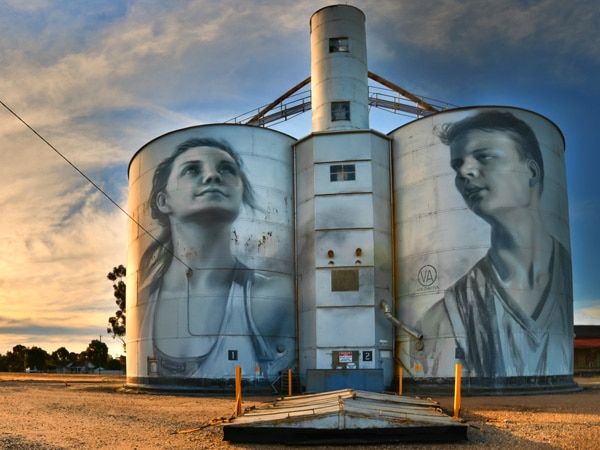
Julia Volchkova depicted Rupanyup locals Ebony Baker and Jordan Weidemann on the silos. (Image: Visit Victoria/Anne Morely)
Georgia Goodie artwork, Rupanyup
As a side project of the Silo Art Trail, Melbourne street artist Georgia Goodie painted two murals in Rupanyup, each one depicting firefighters. The first mural is at a house that was damaged by fire in September 2016, while the other adorns the town’s old shire office building.
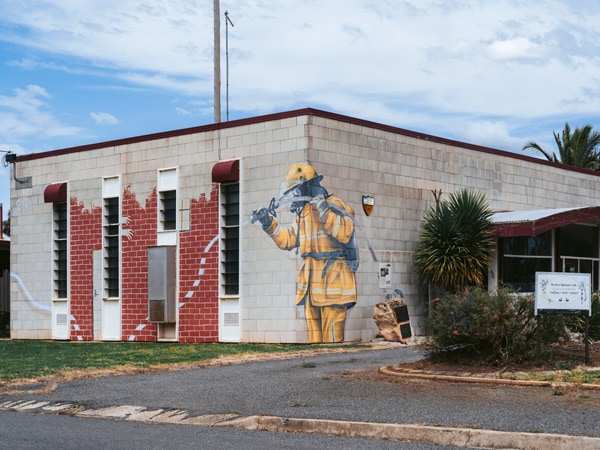
Head to the Rupanyup old shire office building to see Melbourne street artist Georgia Goodie’s firefighter murals. (Image: Visit Victoria/Anne Morely)
The Shack is a rustic and homely rural retreat. The two-bedroom cottage offers panoramic views of farm paddocks, dams, gum trees and the Grampians, the perfect place to rest after a day of exploring.
DAY TWO: Rupanyup to Sheep Hills, Goroke, Kaniva and Brim
Sheep hills.
Melbourne-based artist, Adnate found inspiration for his mural on the Sheep Hills silos in 2016 when he developed a friendship with the Barengi Gadjin Land Council in north-west Victoria.
Adnate depicted Wergaia Elder, Uncle Ron Marks, and Wotjobaluk Elder, Aunty Regina Hood, alongside two young children, Savannah Marks and Curtly McDonald to celebrate the richness of the area’s Indigenous culture.
The night sky represents elements of local dreaming and the overall image signifies the important exchange of wisdom, knowledge and customs from Elders to the next generation.
Spending four weeks with the community in late 2016 to conceive and complete the mural, Adnate sought to shine a spotlight on the area’s young Indigenous people and highlight the strong ancestral connection they share with their Elders.
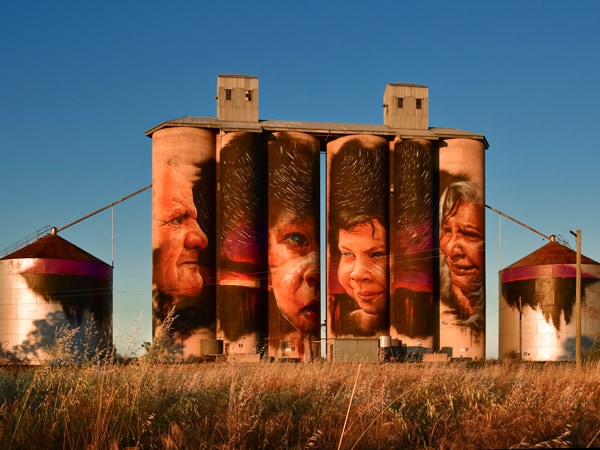
Adnate shines light on the strong ancestral connection young Indigenous people share with their Elders. (Image: Visit Victoria/Anne Morely)
Artist Geoffrey Carran was heavily inspired by the birdlife in West Wimmera Shire when creating the Goroke silo art. The word Goroke is the local Aboriginal word for magpie, so the native bird was a natural choice. Geoffrey then expanded the idea to include other native birds, including a kookaburra and galah.
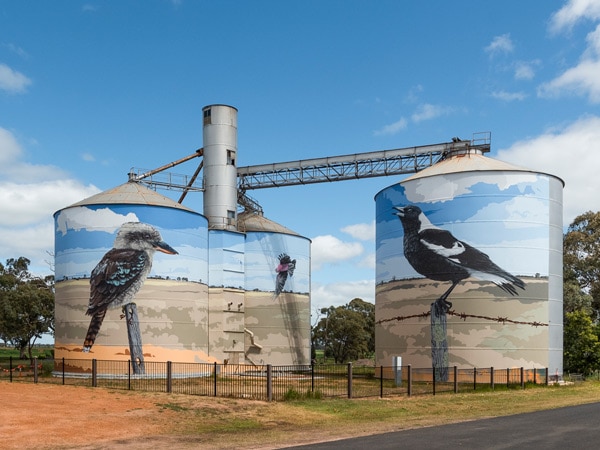
The word Goroke is the local Aboriginal word for magpie. (Image: Visit Victoria/Anne Morely)
The artwork was painted by David Lee Pereira and pays tribute to the nearby Little Desert and its diverse flora and fauna. It is home to more than 600 species of native plants, 220 species of birds and 60 native mammals and reptiles.
The design features the Australian Hobby bird, which is smaller than other falcons, and is one of six Australian members of the family ‘Falconidae’. To the left of the bird is the plains sun orchid, with the salmon/pink sun orchid on the right.
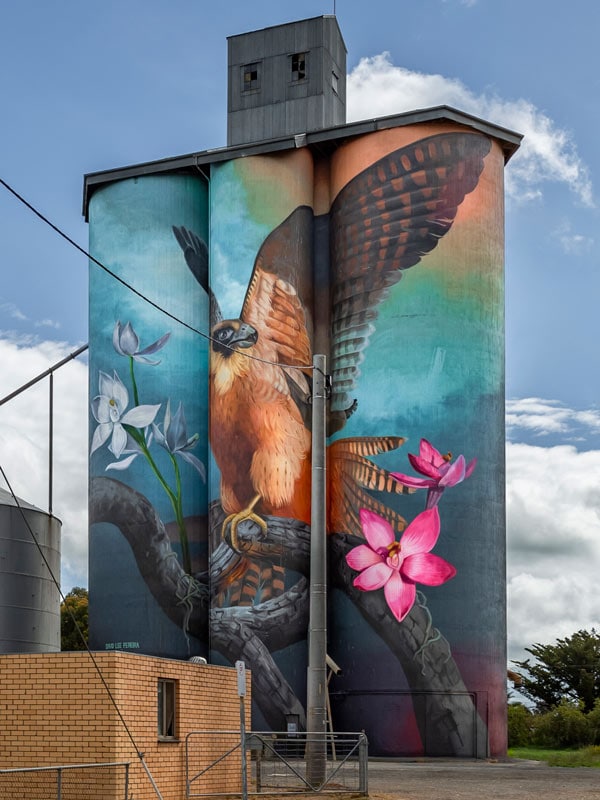
The Australian Hobby bird is smaller than other falcons. (Image: Visit Victoria/Anne Morely)
Guido van Helten’s iconic Brim mural was the first silo artwork to appear in Victoria, and after gaining widespread local and international attention, its success shone a spotlight on the Wimmera Mallee region and inspired the establishment of the Silo Art Trail.
Completed in early 2016 van Helten’s mural depicts a multi-generational quartet of female and male farmers. Rendered across the four silos, van Helten’s subjects bear expressions that exemplify the strength and resilience of the local farming community.
The figures are both central and peripheral, present and absent, and the work explores shifting notions of community identity at a time when rural populations face both immense economic pressure and the tangible consequences of climate change.
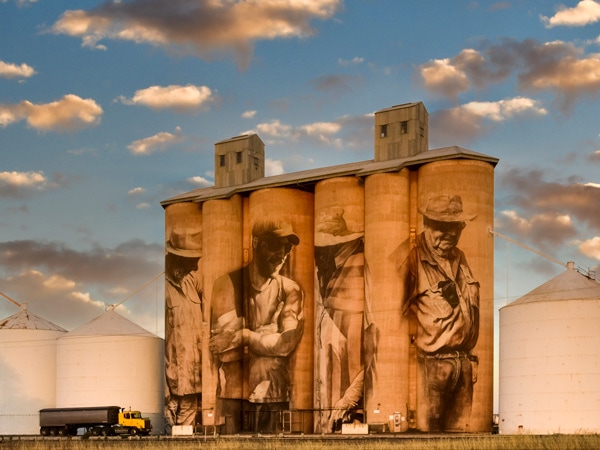
Guido van Helten’s Brim mural was the first silo artwork to appear in Victoria. (Image: Visit Victoria/Anne Morely)
Nine kilometres north of Brim on the Henty Highway is the Netting Fence, constructed in 1885 to stop rabbits invading the Mallee from the south and to keep the dingos to the north. The fence is also the division between the Wimmera and the Mallee regions.
Brim has a stunning free campsite, which can be powered (or not!) called Reddas Park Camping Area .
DAY THREE: Brim to Rosebery, Albacutya and Patchewollock
Before commencing work in Rosebery, Melbourne artist, Kaff-eine spent time in the Mallee assisting fellow artist Rone on his Lascelles silo project. Kaff-eine’s artwork depicts themes that she says embody the region’s past, present and future.
The silo on the left captures the grit, tenacity and character of the region’s young female farmers, who regularly face drought, fires and other hardships living and working in the Mallee.
The silo on the right portrays a quiet moment between man and horse, who are relaxed and facing downward, indicating their mutual trust, love and genuine connection.
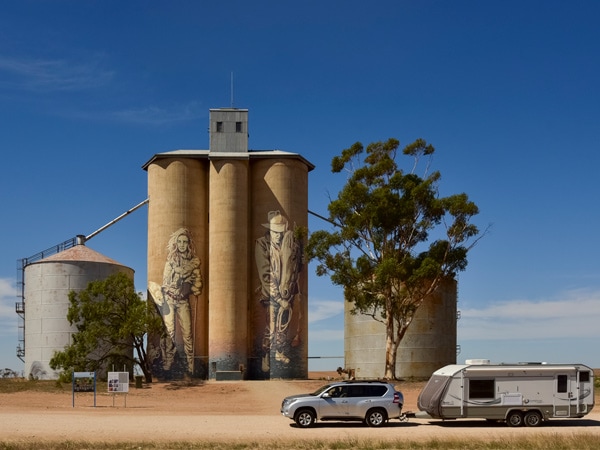
Kaff-eine’s artwork depicts themes that embody the region’s past, present and future. (Image: Visit Victoria/Anne Morely)
Ten kilometres north of Rainbow lies the quirky, colourful and more modern take on Silo Art at Albacutya Silo.
Melbourne artist Kitt Bennett was inspired to, “create an artwork that tells a story of growing up in the country as a youth. I have fond memories of exploring the bush and looking for yabbies under rocks in creeks with my parents. Reflecting on this weird and wonderful time as an adult is something that brings me a lot of happiness.”
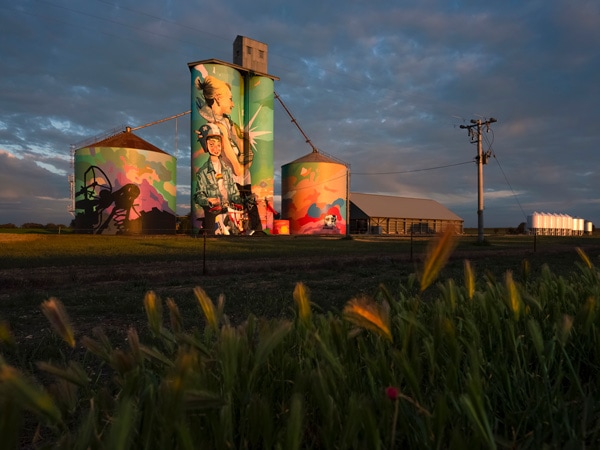
The Albacutya Silo by Kitt Bennett is a more modern take on silo art. (Image: Visit Victoria/Anne Morely)
Patchewollock
To prepare for his Patchewollock mural, Brisbane artist, Fintan Magee booked a room at the local pub to immerse himself in the community and get to know its people. When he met local sheep and grain farmer, Nick “Noodle” Hulland, Magee knew he had found his muse.
The rugged, lanky local exemplified the no-nonsense, hardworking spirit of the region. Perhaps more importantly though, Noodle had just the right height and leanness to neatly fit onto the narrow, 35-metre-high canvas of the twin silos. Hulland’s solemn expression, sun-bleached hair and squinting gaze speak to the harshness of the environment and the challenges of life in the Wimmera Mallee.
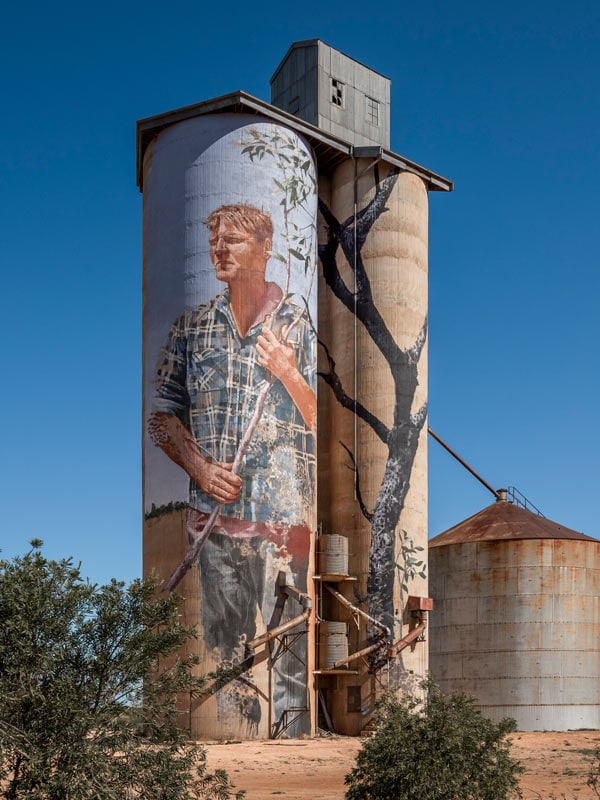
Brisbane artist, Fintan Magee met his silo art subject at the local pub. (Image: Visit Victoria/Anne Morely)
Lake Albacutya
Lake Albacutya is one of a series of terminal lakes on the Wimmera River, which form the largest land-locked drainage system in Victoria.
The Big Mallee Fowl
The Big Mallee Fowl, constructed almost entirely from painted corrugated iron, is one of the most obscure of Australia’s Big Things . Make sure you stop by when you’re in Patchewollock!
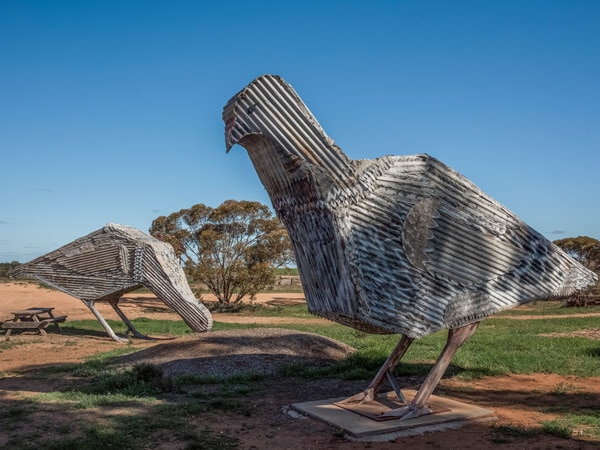
The Big Mallee Fowl is a lesser-known “Big Thing” in Australia. (Image: Visit Victoria/Anne Morely)
Just 20 minutes out of Patchewollock is Pine Plains Lodge. With glorious sunrises, lingering sunsets, clear night skies and stars so close you can almost touch them, it is the perfect place to cosy up next to the fire after a big day sightseeing.
DAY FOUR: Patchewollock to Lascelles and Sea Lake
In order to capture the true essence of Lascelles, Melbourne-based artist, Rone knew that he had to learn about the town from those who were deeply connected to it. He depicts local farming couple Geoff and Merrilyn Horman, part of a family that has lived and farmed in the area for four generations.
Rone says that he wanted the mural to portray his subjects as wise and knowing, nurturing the town’s future with their vast farming experience and longstanding connection to the area.
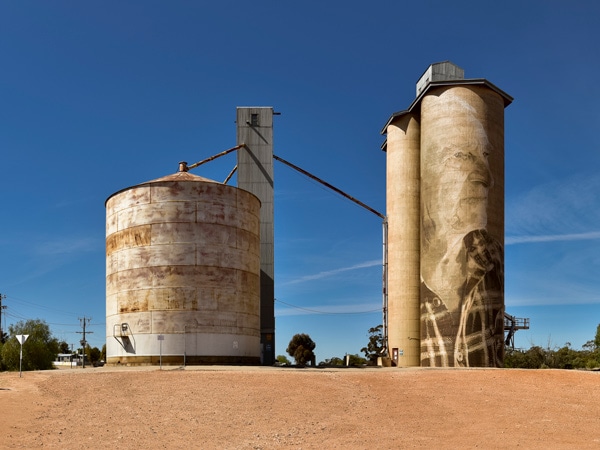
The mural portrays Geoff and Merrilyn Horman as wise and knowing. (Image: Visit Victoria/Anne Morely)
Joel Fergie and Travis Vinson painted the silo artwork at Sea Lake as a celebration of the still and silence found in outback Victoria, and the associated feelings of wholeness and freedom. The young girl, swinging from a Mallee Eucalyptus, looks over Lake Tyrrell and reflects on her Indigenous heritage.
The Indigenous name ‘Tyrille’ means ‘space opening to the sky’ as the colours of dusk and dawn are reflected in the shallow saline bowl. The Boorong People were known to have more knowledge of astronomy than any other tribe, and their stories are rich in culture and connection to the lake. The artwork aims to connect and bring the viewer closer to some of the relatively ordinary and overlooked elements of the outback landscape and allows viewers to see these elements from a new perspective.
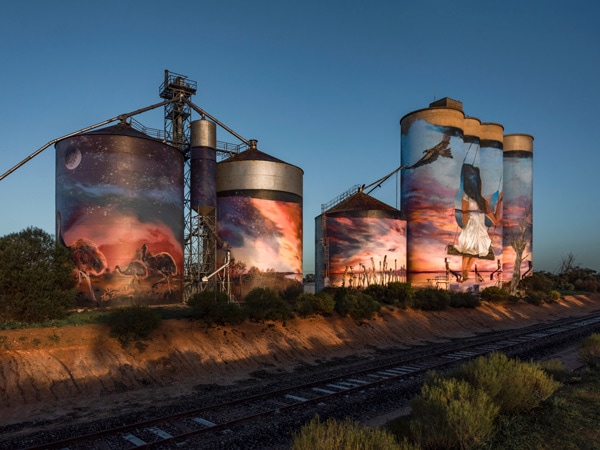
The Boorong People were known to have more knowledge of astronomy than any other tribe, and their stories are rich in culture and connection to Lake Tyrrell. (Image: Visit Victoria/Anne Morely)
Lake Tyrrell
A visit to Lake Tyrrell, Victoria’s largest salt lake, is a must while in Sea Lake. You’ll get a once in a lifetime insta pic, plus the 120,000-year-old lake is regarded as one of the best places in Australia for stargazing, with the dark and endless skies providing the perfect environment.
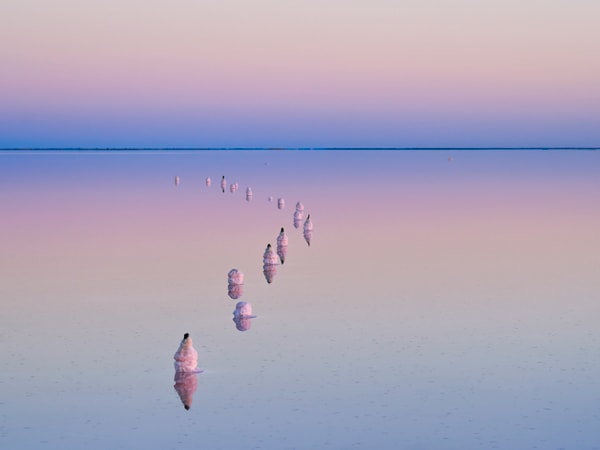
Lake Tyrrell is the ultimate stargazing spot. (Image: Visit Victoria/Anne Morely)
Sea Lake has a range of different stays to suit your needs, whether camping is your vibe or you’d prefer to relax in a hotel.
DAY FIVE: Sea Lake to Melbourne via Nullawil
Artist Sam Bates (Smug) painted the Nullawil silo of a kelpie sheepdog and a farmer on the concrete canvas. The soft-coated black and tan Kelpie was depicted with a sheen on his coat, a shiny black nose, a spark in his brown toned eyes and fine grey whiskers above his semi drooped mouth.
As a “nod” to the history of Nullawil the registration disc has a “galah” and “stick” engraved on it. The name of the town is derived from two Aboriginal words, “Nulla” which means killing stick, and “Wil” derived from the term “willock” meaning Galah.
After visiting Nullawil, it’s back home to Melbourne!
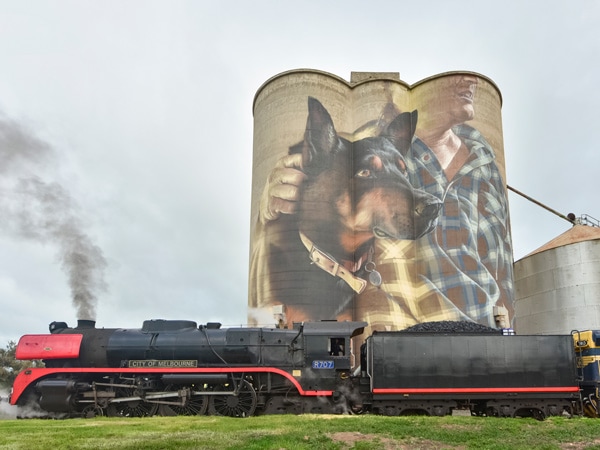
The name of the town is derived from two Aboriginal words, “Nulla” which means killing stick, and “Wil” derived from the term “willock” meaning Galah. (Image: Visit Victoria/Anne Morely)
Emily Murphy found her passion for writing at a young age and knew her future was in travel after she moved overseas solo at 18. Em loves to write about beautiful, under-the-radar destinations and anything that will ignite a desire in more people to explore the vastness and beauty that is Australia. She is a devoted bun mum and in her spare time you'll find her by the sea, reading a good book, binge-watching a TV show or exploring Sydney's dining scene.

LEAVE YOUR COMMENT
Cancel reply.
Save my name, email, and website in this browser for the next time I comment.
Comments (3)
Any chance of getting a bus company to do a bus tour of the Silo Art Trail you have featured in this email?
My sister and I managed to do most of the Victorian Silo Trail last year and it was fabulous. Such a delight to travel from one small country town to another, something lost in ravel with all the highways that bypass smaller towns. I recommend the Trail to everyone.
An intriguing article which does the work for you. A perfect getaway for me with my teardrop camper.
You might also like
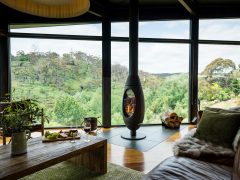
Cosy villas & luxury accommodation in Daylesford
From zen-like ryokans to luxury lodges and self-contained retreats hidden away in the bush, these are the best Daylesford hotels, villas and Airbnbs. ...
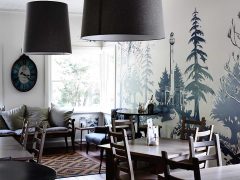
A hit-list of Daylesford cafes for brunch & coffee
Daylesford is not a destination that’s short on cafes – here are some of the region’s best. This pretty pocket of Victorian countryside is know...
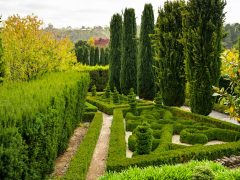
Top things to do in Daylesford & surrounds
From roaming around sweetly scented lavender farms, to taking scenic walks, wine tasting, and hitting the local day spas, these are the best things to...
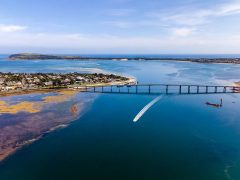
Victoria’s secret: 5 easy Phillip Island road trips you should know
Phillip Island is a peaceful refuge, known for its flora and fauna – think penguins and fur seals – as well as its mesmerising sunsets, fantastic ...
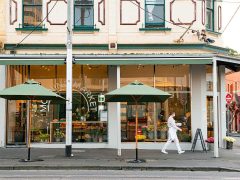
A neighbourhood guide to Gertrude Street, Melbourne
Brimming with independent boutiques, galleries, bars and restaurants that channel a strong creative spirit, this storied street in Melbourne’s oldes...

© Australian Traveller Media 2024. All rights reserved.
- © Roadtrippers
- © Mapbox
- © OpenStreetMap
- Improve this map
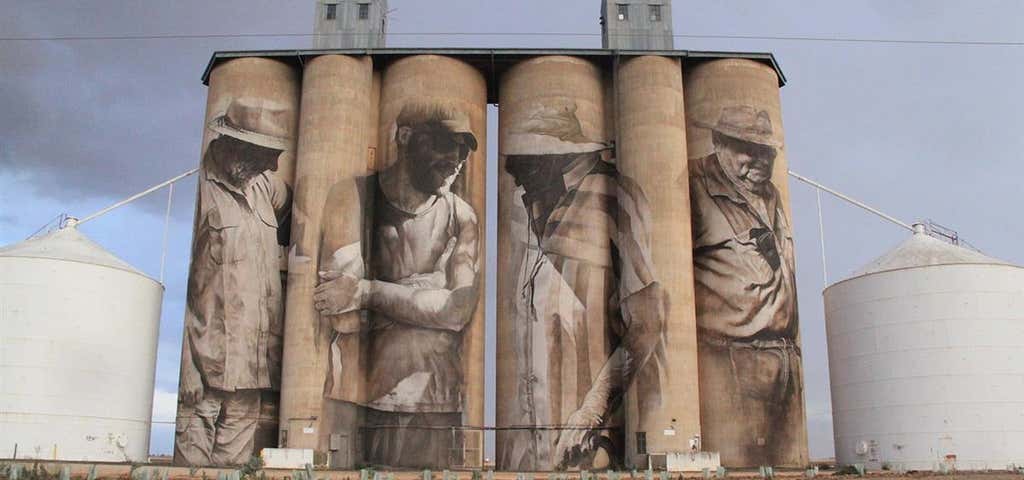
Silo Art Trail
1 Gibson St, Rupanyup, Victoria 3388 Australia
- Independent
“Australia's largest outdoor gallery, and a fantastic use of old silos.”
The car-stopping Silo Art Trail stretches over 200 kilometres. The ambitious project bought a team of renowned artists from Australia and across the world to visit the region, meet the locals and transform each old grain silo into an epic work of art; each one telling a story unique to the host town. To travel the Silo Art Trail from one end (Julia Volchkova’s Rupanyup) to the other (Fintan Magee’s Patchewollock), it should take two and a half hours, depending on how long you want to stand and marvel at each one. They’re all different. Once you’re in the Wimmera Mallee, the approximate drive time from one silo to the next is: Rupanyup to Sheep Hills: 25 minutes Sheep Hills to Brim: 25 minutes Brim to Rosebery: 20 minutes Rosebery to Lascelles: 25 minutes Lascelles to Patchewollock: 35 minutes

Reviewed by gnash57

Reviewed by mr_mrs_pawlin
looking forward to traveling to see this art work in august, it is on out list of things to do in Australia so any hints and tips would be good
Be the first to add a review to the Silo Art Trail.
Problem with this listing? Let us know .
Has RV parking changed? Let us know .
- Unavailable Parking
- Unknown Pets Allowed
- Unknown Restrooms
- Unknown Wifi
- Unknown Wheelchair Accessible
- Unknown Credit Cards Accepted
Nearby Hotels
Click to discover a great deal!
Related Trip Guides
Inland melbourne to adelaide, hobart - swansea weekend roadie, foodie adventures a short drive from sydney, explore the southwest, keep exploring with the roadtrippers mobile apps..
Anything you plan or save automagically syncs with the apps, ready for you to hit the road!

Connect with us and hit up #roadtrippers
Tall tales, trip guides, & the world's weird & wonderful.
- Roadpass Digital
- Mobile Apps
Business Tools
- Partnerships
Get Inspired
- Road trip ideas by state
- National parks
- Famous routes
- Voices from the Road
Fresh Guides
- The ultimate guide to Mammoth Cave National Park
- The Ultimate Guide to Badlands National Park
- Route 66 Leg 2: St. Louis to Tulsa
- Route 66 Leg 1: Chicago to St. Louis
- Route 66 Leg 3: Tulsa to Amarillo
- Top 10 things to do in Ohio
- Offbeat Road Trip Guides
- Road Trip USA
- Scenic Routes America
- National Park Road Trips
- Terms and Conditions

Guide To Visiting The Silo Art Trail – Amazing Murals In Rural Victoria
Jayne Gorman
June 2, 2020
Billed as Australia’s largest outdoor gallery, the Silo Art Trail is a collection of 8 decommissioned wheat silos in rural Victoria that have been transformed by international street artists.
Large-scale murals depicting the local culture and community have been painted on the silos by world-renown artists in a bid to inject colour, creativity, intrigue and (hopefully) a bit of tourist dollar into these remote areas.
It’s hard to describe the impact of seeing a ghostly portrait or deep purple night sky rise out of the dry fields, but trust me when I say these murals are amazing and the Silo Art Trail is one of the best road trips from Melbourne.
Why visit the Silo Art Trail?
One of the things I really appreciated about the Silo Art Trail is that each artist has chosen to tell a story about the people of the region – from the sports-mad youth to the hard-working farmers and respected indigenous Elders – and it’s these faces that keep you driving, as much as the unique (and somewhat surreal) experience of discovering such vibrant art in a remote rural setting.

My husband and I loved our weekend break to the Silo Art Trail in April 2018, which is when I initially wrote this post. As more silos have been added to the trail in Victoria, and they’ve become popular throughout Australia, I’ve updated this post with the latest information.
Where is the Silo Art Trail?
The official Silo Art Trail in Victoria consists of 8 silos spread over 200 kilometres in the Wimmera Mallee region.
The closest silo to Melbourne is The Rupanyup Silo by Julia Volchkova, which is where most people choose to start the trail.
It takes approximately 3.5 hours to reach Rupanyup from Melbourne by car, if you set out early.
You could also stay the night in Horsham (like we did) or Ballarat to break up the driving. Horsham is about 35 minutes from the first silo.

How long does the Silo Art Trail take?
Technically you can drive the whole Silo Art Trail is about 4 hours. To travel the entire length of the original 200 kilometre trail from Julia Volchkova’s work in Rupanyup to Fintan Magee’s mural in Patchewollock takes just over 2 hours. There are also 2 new silos found on the A79 that you’ll need an additional 1.5 hours to reach from Patchewollock.
But, of course, you’ll want to stop, soak up the creativity and take in some of the sights mentioned at the end of the post.
So, while you can visit the Silo Art Trail in a (long) day I recommend taking at least 2 so you’re not rushing it.
Trail maps and regional information guides can be found at each of the silos but you can also download a copy of the visitor map to help plan your trip.
Who painted the silos in Victoria?
Various well-known Australian and international street artists have made their mark on the Silo Art Trail. If you’re familiar with the street art in Melbourne and Sydney, you might recognise the styles of artists such as Rone, Adnate and Kaff-eine.
Below is a little introduction to each of the murals and the artists.
Rupanyup Silo by Julia Volchkova

Russian artist Julia Volchkova focused on the town’s youth and their love of team sports for her mural in Rupanyup.
Julia’s work has also transformed little-known areas in George Town and Balik Pulau in Penang .
Sheep Hills Silo by Adnate

Melbourne-based artist Adnate is well known for his portraits of indigenous people and their native lands.
At his mural in Sheep Hills he has depicted local Elders, Uncle Ron Marks and Aunty Regina Hood, alongside two young children to signify the important exchange of wisdom, knowledge and customs from Elders to the next generation.
Brim Silo by Guido van Helten

Guido van Helten’s mural in Brim (also pictured at the top of the post) was the first silo artwork to appear in Victoria and its international success inspired the establishment of the Silo Art Trail. ( As well as a feature on Masterchef Australia, is anyone remembers that?! )
The mural depicts an anonymous, multi-generational quartet of farmers and represents the strength and resilience of the local farming community.
Rosebery Silo by Kaff-eine

The only female artist on the trail, Kaff-eine spent some time assisting Rone with his mural in Lascelles before completing her own in Rosebery in late 2017.
Kaff-eine’s artwork depicts the region’s past, present and future and portrays a young female sheep farmer and a horseman enjoying a quiet moment.
Lascelles Silo by Rone

Rone’s ethereal mural in Lascelles features local farming couple Geoff and Merrilyn Horman, part of a family that has lived and farmed in the region for 4 generations.
Patchewollock Silo by Fintan Magee

Brisbane artist Fintan Magee met the muse for his mural at the local pub. Local (lanky) sheep and grain farmer, Nick “Noodle” Hulland, had the exact spirit (and build!) Magee wanted to portray on the narrow GrainCorp Silos.
The following 2 silos were painted after our visit so I don’t have my own images to share. (Yet, hopefully I’ll get back there one day!)
Nullawil by Smug
Sydney-born and now Scotland-based artist Sam Bates (a.k.a. Smug) has depicted a local farmer in a classic flannelette shirt with his trusty sheepdog besides him.
Sea Lake by Drapl & The Zookeeper
The newest addition to the trail was painted by Travis Vinson and Joel Fergie, also known as Drapl and The Zookeeper. This work features a young girl swinging from a eucalyptus tree, gazing out over the reflective surface of Lake Tyrrell, the biggest inland salt lake in Australia, which you can also experience for yourself via a viewing platform situated around a ten minute drive from Sea Lake.
Tips for visiting the Silo Art Trail
Now that I’ve whet you appetite for a road trip, here are some tips for your visit to the Silo Art Trail.
- As mentioned earlier, I’d recommend setting aside at least 2 days to cover the trail and stop at places that catch your eye along the way. There are additional murals by Kaff-eine, for example, found in Lascelles and Beulah, The Mallee Sunset Gallery in Rosebery is worth a visit, and speaking to the locals in the bakeries and hotels will give you more insight into the area. Click here for a list of other attractions along the trail .
- If self-catering, stock up on basic supplies and refreshments in bigger towns like Horsham or Warracknabeal. There is a small convenience store in Patchewollock , the most remote of the silos, although it was closed during our visit – much to our regret. We did find some much-needed snacks at a tuck shop inside the Lascelles Hotel though.
- There are clean but basic public loos dotted along the trail. You might want to pack your own loo roll and anti-bacterial hand gel.
- We visited on a week day – just before ANZAC Day – and there was often just us and one other couple at each silo, so you might want to plan your visit for mid-week in order to get people-free pictures.
- Please check it’s safe to do so before before launching, but I think you are permitted to fly drones over some of the silos as we saw someone doing so.
Where to stay on the Silo Art Trail
Silo art trail accommodation.

We hired a car and drove from Melbourne, staying in Horsham the first night and in a gorgeous cottage outside Ballarat the second.
We chose these areas as we wanted access to cafes and restaurants and a shorter drive home afterwards, but it did mean doing a lot of driving over the 2 days on the trail.
We stayed at the Comfort Inn in Horsham – clean, basic, did the trick for $150 AUD.
Search for more hotels in Horsham.
If you’d like to stay somewhere on the trail itself , the Lascelles Hotel has built some cabins directly opposite the Rone mural. They are available to book on AirBnb from $80 AUD per night. Check out Wagon Inn self-contained units.
If you don’t mind driving towards Ballarat at the end of the day, I cannot recommend Pound Hill Cottage at Miners Rest enough. This beautifully maintained 3-bedroom property has a roaring log fire, cosy beds and stunning rural views. It made this city girl consider a move to the country! (Priced from $180 AUD per night.)
See also: Quirky places to stay in Melbourne & Victoria
Camping Options
Most people we saw doing the trail were in campervans. There are a couple of basic caravan parks found along the trail and in remote areas like Patchewollock I think you’ll be glad to have your own fridge!
The Mallee Bush Retreat on the shores of Lake Lascelles has some quirky options including 2 Silos, 2 Cow Sheds, Stables and a Limestone Grain Store for rent – you’ll have to bring your own linen – as well as free camping around the Lake perimeter.
Find more information on caravan parks in the Yarriambiack Tourism guide .
Things to do near the Silo Art Trail

There are some great places you can visit in the surrounding area before or after your visit to the Silo Art Trail.
We spent the weekend in Daylesford and Hepburn Springs before heading out to Horsham to begin the Silo Art Trail.
Other places you can combine your visit with include:
- Sovereign Hill – an open air museum set in Victoria’s gold digging era
- Kryal Castle – come over all Medieval at the bizarre Kryal Castle
- Eureka Centre – learn about the 1854 Eureka Stockade at the home of the Eureka Flag
- The Grampians – go wild with bird watching, hiking and rock climbing in the Grampians
- Bendigo – learn about Bendigo’s gold boom on a vintage talking tram
- Lake Tyrell – Take stunning photos and enjoy the stargazing at Australia’s largest inland salt lake, just north of the silo at Sea Lake.
I hope you enjoy your visit to the Silo Art Trail as much as I did.
You may also like:
6 must-do road trips from Melbourne
What to do in Daylesford & Hepburn Springs
What to see & what to do in Australia
Is the Penguin Parade on Phillip Island worth visiting?
Pin for later:

Share this:
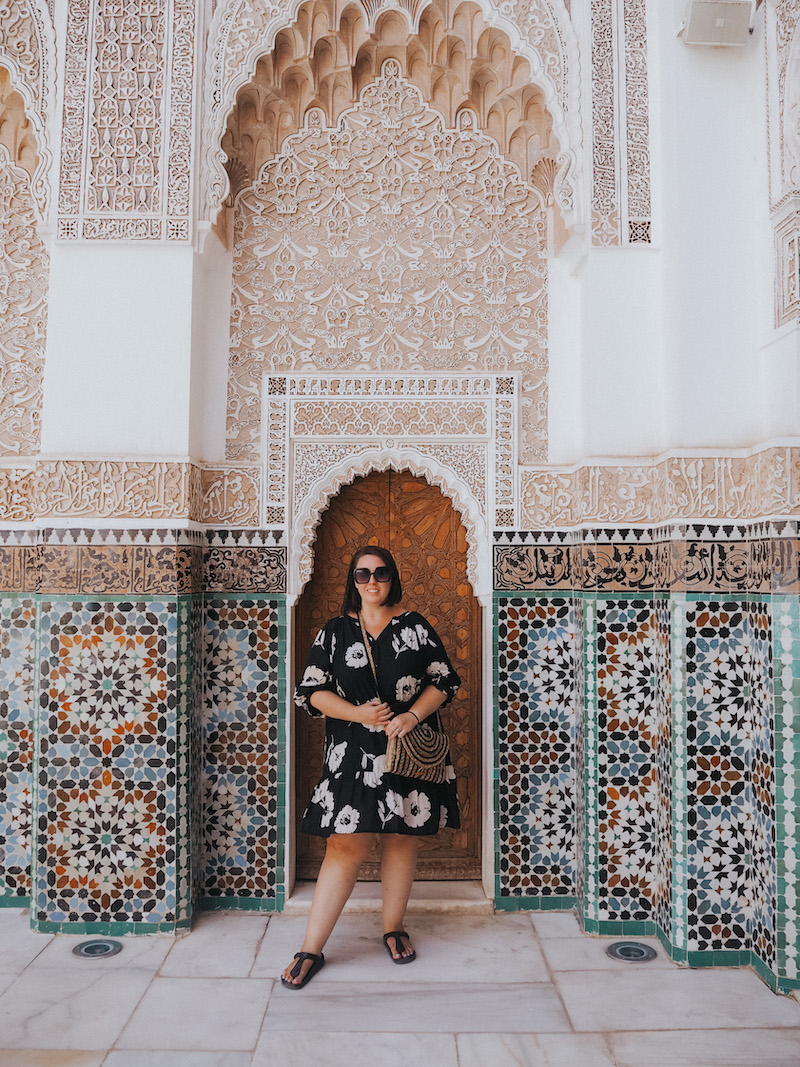
I’m Jayne, a travel blogger, content creator and mum to a 4-year-old son. I’ve been blogging since 2010, travelled to 65 countries and share travel guides and tips to help you plan stylish, stress-free trips.
Baby Travel Essentials
A social distancing day out at west wittering beach, 24 thoughts on “guide to visiting the silo art trail – amazing murals in rural victoria”.
I love this! Thanks for introducing me to a part of my home State that I didn’t know existed. I definitely need to do this. On a side note, if you’re ever in Rioja, Spain, the Bodega Solar de Samaniego has more silo art by Guido van Helten (appropriately called ‘The Wine Cathedral’).
Oh I never knew – good knowledge! And I hope you get a chance to try the trail sometime soon.
Such an original post! The art on the silos definitely look amazing. I had no idea about his type of art. Thanks for having me dicover this 🙂 Best, Marcella
You’re welcome Marcella! Hope you get a chance to visit.
You’ve totally inspired me to go check these out (I think Toni and I are going to go have a look-see in October). It’s such a fantastic and innovative idea!
Yay! Go do it, we totally enjoyed the experience and I’m sure you will too.
these are so beautiful – what a great idea to make an otherwise bleak silo more interesting and also a great way to tell a place’s story. I remember them from Masterchef last year and was – wow! Great idea for a road trip and yes agreed – drone footage would be awesome to see though I really love your images.
Aw thank you. We have since purchased a drone and I’m toying with going back although the original impact of seeing them for the first time them might be lost.
We are planning a trip at the end of October and I’m looking for dog friendly accommodation? Can anyone recommend a place. We live in Melbourne and would be traveling mid week.
Hi Anne, I can’t recommend anywhere personally but you may find this website helpful. https://www.visitvictoria.com/dogs Best, Jayne
Hi Jane. just found your page, how great to see all your suggestions. My brother is coming from Sydney in Nov so we had planned a trip to the silos so your info has been greatfully received. Cheers Pauline
Hi Pauline, thanks so much for leaving a comment! Hope you and the family have a lovely trip in November 🙂
Thanks so much for the information…. is there a better time of day, with the sun full on the silos to capture the pictures, or perhaps early morning for pictures.. ?
I’m not entirely sure Ruth as it takes quite a long time to drive between them we just went with what we could fit in 2 days!
Hi all, just done the silo art trail! The artists have done an amazing job! I would just like to add a few more to the list that my partner found by coincidence! 1. Sea Lake 2. Nullawil 3. Rochester 4. Tungamah 5. St James 6. Devenish 7. Goorambat All in Victoria
Thanks for this! I can’t believe how much the trail has grown since we visited. We’ll have to go back.
And more coming with a few wins in the pick-my-project for 2019-2020, however if you planned a loop starting from Ballarrat and working from Bendigo and St.Arnaud northward, follow the trail until Hopetoun, divert to Woomelang and on to Sea Lake, then on to Lascelles and Patchewollock, then go north towards Walpeup, but turnoff to Ouyen at the Y intersection (with a little luck and the right time of the year you can see the Mallee Hens around here), visit the walls in Ouyen, then head west along the Mallee Highway through the border into SA (don’t forget to eat your fruit before crossing as there is a checkpoint) visiting a number of painted silos and buildings along the way from Pinaroo through to Talem Bend, turn back into the Dukes/Western Highway after visiting Talem Bend itself ( a lot to see there including the old town a few km. on the Adelaide side) and check out Servicetoun and Kaniva (both soon to be completed), Nhill and Dimboola have walls and cut back through Warracknabeal and Sheep Hills as you needed to miss it before. What started as a weekend trip has somewhat grown to needing at least a week to do properly.
Plenty of Caravaners are doing it and facilities are along the way at reasonable distances.
Someone really needs to do a proper guide, however as ther are mall in Halls Gap and coming on the Coast road, I suspect it would be out of date before it was released.
These are so cool! Absolutely love the Sheep Hills one especially. I love that they’ve spruced otherwise dull objects into works of art.
It’s such a clever idea isn’t it. And the contrast between the industrial structures and works of art just makes it all the more interesting.
Hi Jayne Thanks for you website. It is really great coverage of key information.
I thought you and your readers might like to know of a recent addition for your Tips section. We are a farming family at Sheep Hills and are trialing this autumn providing a ‘Pop-up’ from the back of our ute of cool drinks, tourist information, local produce and souvenirs on the Road Reserve at our local silos. We are making as much time as possible for this, but it still has to fit into our lives, so we hope visitors will support us and look forward to meeting them and adding to their viewing experience of Yarriambiack’s Silo Art Trail.
I’d also like to suggest that you add in to places to stay that Warracknabeal has two motels too .
And, many people miss that there is what I call “Roundabout Art’ at Minyip and Warracknabeal. Very realistic 3D art (statues) that tell a story about the farming of the towns – and are worth driving around the roundabouts to see!
Thanks for this list and tips. When visiting Sea Lake, you must go to Lake Tyrell and the new viewing platform, solar sun chairs (or star chairs at night) and the walkway out on the salt lake. A surprise site not to be missed !! 5 mins drive north on the road to Ouyan from Sea Lake silos.
Such great information here. Thank you Jayne and everyone!
You’re welcome. Hope you have a great trip!
Many thanks heading off next weekend to visit the silos. Is there a good guide to ensure we don’t miss the additional attractions mentioned on this site?
Leave a Comment Cancel reply
This site uses Akismet to reduce spam. Learn how your comment data is processed .
Victoria Silo Art Trail – Magnificent Wimmera Mallee Road Trip
If you are looking for road trip ideas over a long weekend, then look no further. The Victoria Silo Art Trail is an ideal public-holiday weekend road trip, for anyone who is based in or around Melbourne, Geelong, Bendigo and Ballarat. Have a look below for the perfect itinerary.
We just got back from a trip exploring the northwest top-end of Victoria and decided this would be the second part of our trip. Read on to find out where to eat, sleep and stop. Plus there is some extra insider travel tip info.
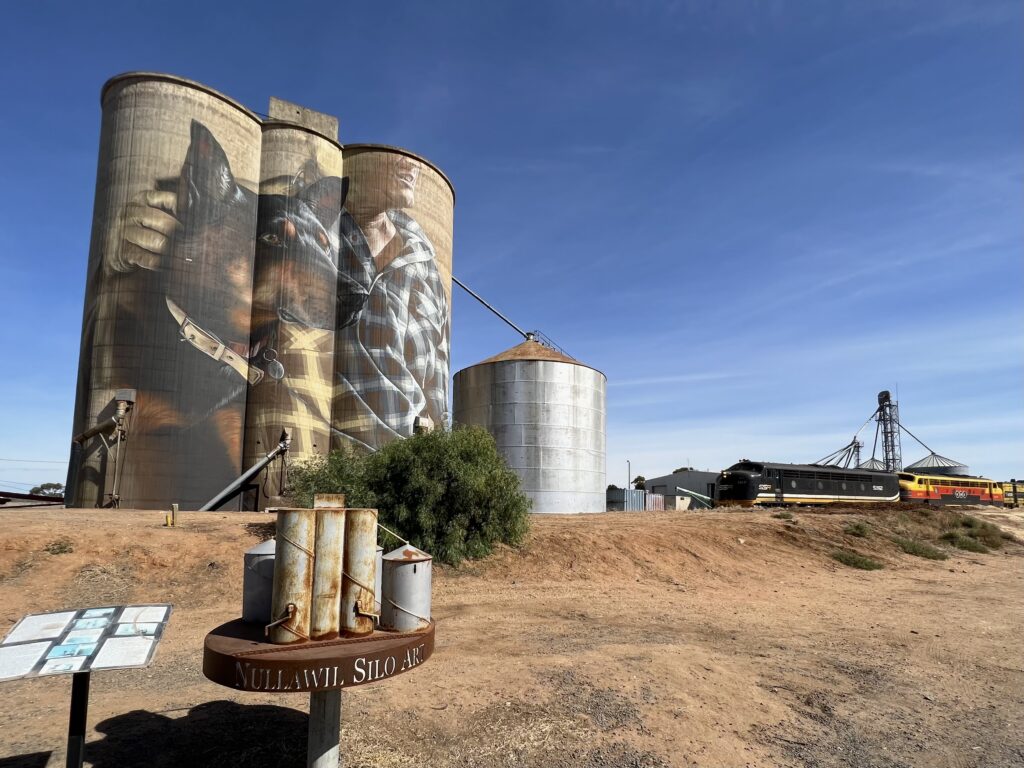
Silo Art Trail Victoria Itinerary
The route allows you to either start or end your road trip at Sea Lake. Just reverse the order below if that is what you desire. By the way this itinerary does not encompass all of the Silos on the trail, for that you would need much more time. We picked up some others which you can read about here .
A really good option is to drive straight to Sea Lake on the first day, so that you can catch the sunset on Lake Tyrrell, eat, sleep and in the morning complete the Silo Art Trail on the way home.
Sea Lake Silo Art
Depending on the time that you arrive in Sea Lake and how you feel, you could check out the silo art murals at the Sea Lake Silos, in the afternoon before enjoying the Lake Tyrrell sunset followed by dinner or you could check the Silo Art out in the morning before setting of on the next leg of your road trip. This flexibility is hand for breaking up your Silo Art Itinerary and having a more relaxing road trip overall.
Dinner options at the Royal Hotel, Sea Lake and the Juke Sea Lake are discussed further on so keep reading.
Starting at Sea Lake
- Melbourne to Sea Lake (Lake Tyrrell) for sunset
- Sea Lake Silo
- Sheep Hills
Finishing at Sea Lake
- Sea Lake (Lake Tyrrell) for sunset (maybe)
- Sea Lake (Lake Tyrrell) for sunrise!
- Return to Melbourne
Wimmera Mallee Silo Art Trail Road Trip – VLOG
You can check out our account of our Wimmera Mallee Silo Art Road Trip in the video. Youtube account of the road trip here .
Where to Stay and have Dinner
There seem to be only two restaurants that you can eat an evening meal at in Sea Lake. The first is the Royal Hotel Sea Lake (and pub/bar) and the second is The Juke Restaurant Sea Lake, which is located in the Royal Hotel.
Royal Hotel Sea Lake Menu
If you choose to eat at the Royal Hotel, the food comes from the Juke, where you also need to order. The menu at the Royal Hotel Pub is made up of your typical club classics, they also have Pizza and a Parma night, so depending on when you go there are some great options and it’s a beautiful relaxing country pub.
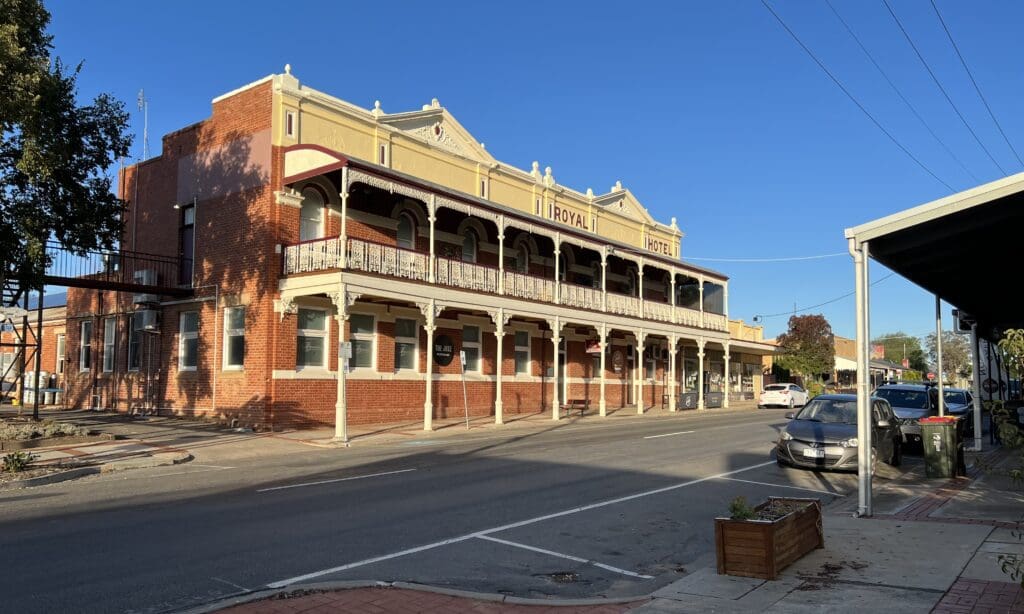
The Juke Sea Lake Menu
The Juke has a contemporary menu, which is short, and will definitely please. Inside, the restaurant has a comfortable vibe and importantly, after sunset photography, is nice and warm. Be sure to book though, being one of the few places to eat in Sea Lake, The Juke is popular and busy.
The Juke, does not seem to its website, but it is a part of The Royal Hotel’s website and has details on how to book. Here is also a link on Google Maps .
Regardless of where you eat, the Royal Hotel was a great pub to have a beer at to unwind after a hard day on the road.

Best Accommodation Silo Art Trail Victoria
Sea lake hotel and motel accommodation options.
We stayed at Lake Tyrrell Accommodation , which seems to be setup for the main attraction of Sunset at Sea Lake, ie. Lake Tyrrell or even Sunrise on the lake, you’ll hear people setting off to catch the Sunset at Lake Tyrrell, or to do a spot of star gazing at the Sky Lounge. Likewise in the morning you’ll sense a buzz around people setting off to catch sunrise at Lake Tyrrell. The accommodation offers modern, clean and very simple but pleasant rooms, with loads of parking. Highly recommended.
Other options around Sea Lake for Accommodation are the Royal Hotel, which has the Pub and The Juke restaurant downstairs and then the Sea Lake Motel, both of which offer decent rooms and have great reviews.
Lake Tyrrell (Free) Camping Options
If you are looking for free camping around Lake Tyrrell, you may be out of luck, there are however a couple of options for camping. So do not despair.
The Royal Hotel in Sea Lake has a parking area out the back for self-contained campers, such as caravans and campervans. This was free, subject to permission at the time of writing. So give the Royal Hotel a call prior to arrival to check out that option on Lake Tyrrell’s and the Pub’s doorstep!
Another option is Green Lake, located around 10km south of Sea Lake on the road to Birchip, camping here is by honesty box at around $20/night. The sites are powered and there are facilities.
Finally there is also an option that is 34 km further north of Lake Tyrrell and Sea Lake at Nandaly Travellers Rest, opposite the Nandaly Community Hotel, there are public toilets, shower, BBQ, firepit and a playground.
Essential Insider Info – Hiring Gumboots
Now, let’s get something straight. If you are visiting Lake Tyrrell, then regardless of whether you are taking photos or not you really need gumboots!
If you do not own gumboots, fear not! You can hire them for $10-15 at the Tourist Info Centre on the main road. Click here for location.

Best Time to visit Lake Tyrrell
Lake Tyrrell is famous for its stunning salt flats that create mirror-like pink reflections during certain times of the year.
It is a tricky question, as to when the the best time to visit Lake Tyrrell is, because it depends on the experience you’re looking for:
- Mirror Effect : The main attraction of Lake Tyrrell is the mirror created by the shallow water on the salt flats and is what gives the opportunity for those amazing photos of big skys. This effect is most prominent during the dry times of the year, when the water has evaporated, from November to March. The best time to witness the mirror effect is during these warmer months when there’s less chance of rainfall and the salt crust is pretty dry.
- Astrophotography : Lake Tyrrell is famous for its dark skies, making it a great location for astrophotography and star gazing. The best time for this activity is during the cooler months of the year when the skies are clearest, bring some seriously warm clothes. The period from April to September is generally ideal for stargazing and capturing the Milky Way and other celestial phenomena, like satellites blazing across the night sky.
- Wildlife : If bird watching and observing wildlife is your thing, the cooler months, April to September are better, as the lake attracts migratory birds and other wildlife.
- Avoiding Crowds : If you don’t do crowds, visiting Lake Tyrrell during the shoulder seasons in October and March. The weather is still pleasant, watch the forecast, and you might have the place almost to yourself.
- Weather Considerations : It’s important to note that the weather can be quite harsh, when you are exposed in the open. During the summer months (December to February), temperatures can soar, so be prepared. In contrast, winter months (June to August) can bring chilly temperatures, especially during the night, but it is definitely worth putting up with the cold.
Silo Art Trail – Sea Lake to Melbourne
Sea lake silo art – drapl & the zookeeper.
The silos at Sea Lake are situated walking distance from the centre of Sea Lake town, so you can easily grab a coffee whilst you admire the work of Drapl & The Zookeeper .
The silo viewing area is separated from the silos by the railway, which provides context to their purpose. The art itself represents a girl swinging from a Mallee gumtree overlooking Lake Tyrrell.
Lake Tyrrell Sky Lounge – Sea Lake
The area is well known for it’s dark sky at night making it an excellent place to grab some time star gazing or doing a spot of astrophotography. In fact Lake Tyrrell is ranked as one of the best dark places in Victoria to see the stars, so what better place and opportunity to witness the night sky for a spot of star gazing, than from the purpose build sky lounge, so relaxing.
The Indigenous word ‘Tyrille’ means ‘space opening to the sky’ which is apt. When you visit you will see why, make sure you check out the sky lounge at Lake Tyrrell. The Indigenous Boorong People were known to have more knowledge of astronomy than any other tribe, and their stories are rich in culture and connection to the lake.
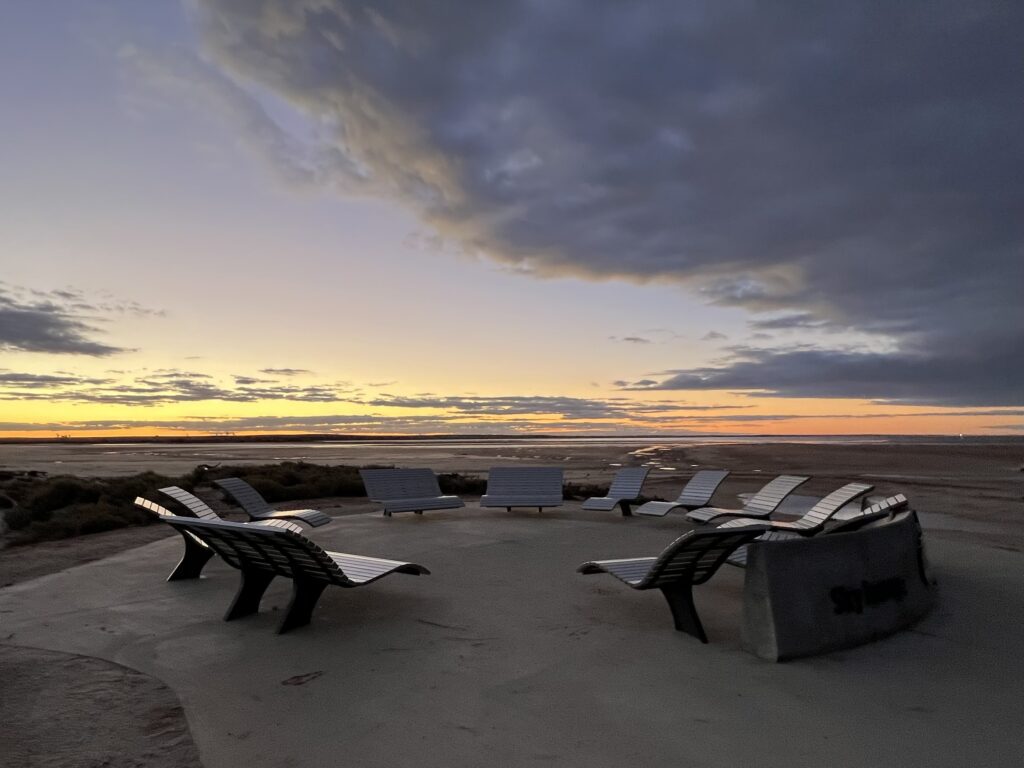
Getting back to the silo art, the scene depicted represents the sense of stillness and silence, that the vastness of the outback provides. The colours certainly reflect what you can expect to experience when you visit the Salt Lake.
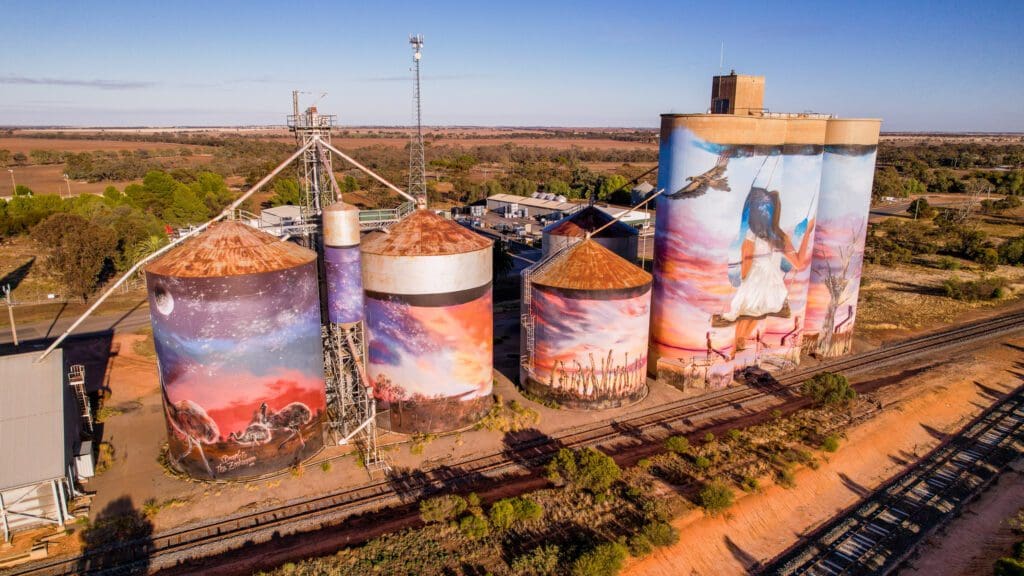
Lascelles – Rone
The art at the Lascelles Silos, depict a local couple from the community, farmers Geoff and Merrilyn Horman, part of a family that has lived and farmed in the area for four generations.
These silos were completed in 2017 by Rone, who wanted to portray his subjects wisdom, knowledge and nurturing for their community.
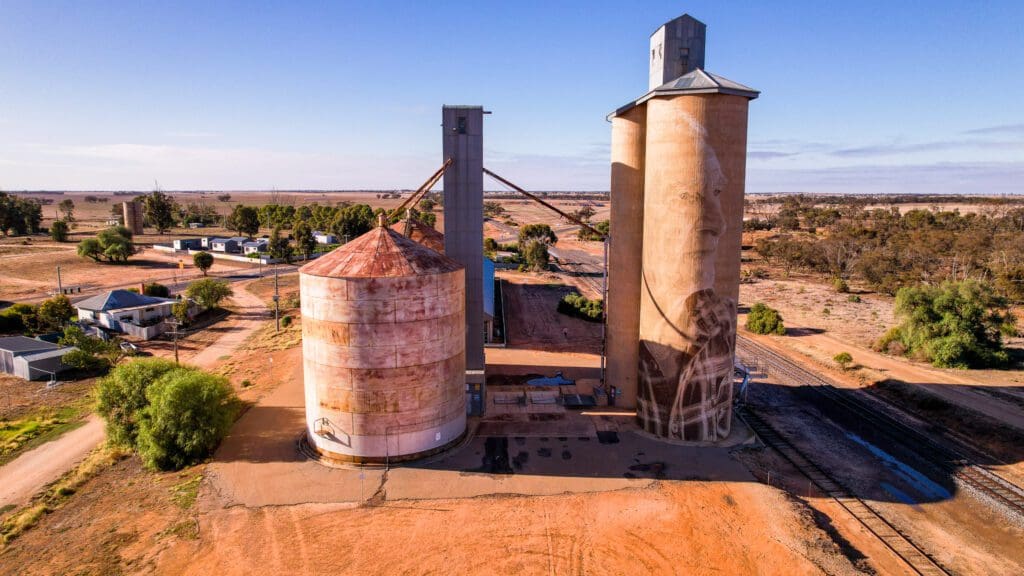
Check out Melbourne based Rone on his website and Instagram .
Rosebery Silo Art – Kaff-eine
The Rosebery silo art was completed by Kaff-eine , who is another Melbourne based artist; former lawyer and public servant. In order to complete this work, in 2017, they spent time with the artist behind the Lascelles silo art project. The silos themselves date back to 1939.
The silo on the left captures the grit, tenacity and character of the region’s young female farmers, who regularly face drought, fires and other hardships living and working in the Mallee. In her work shirt, jeans and turned-down cowboy boots, the strong young female sheep farmer symbolises the future. The silo on the right portrays a quiet moment between dear friends. The contemporary horseman appears in Akubra hat, Bogs boots and oilskin vest – common attire for Mallee farmers. Both man and horse are relaxed and facing downward, indicating their mutual trust, love and genuine connection. siloarttrail.com

Check out Kaff-eine on her website and Instagram .
Brim Silo Art – Guido van Helten
The Brim silo art was the first of the silo art trail to be created in Victoria, immediately demonstrating the impact of the artworks on the local community. It was the work at Brim silos that inspired the establishment of the silo art trail and has consequently helped the Wimmera Mallee region of Victoria.
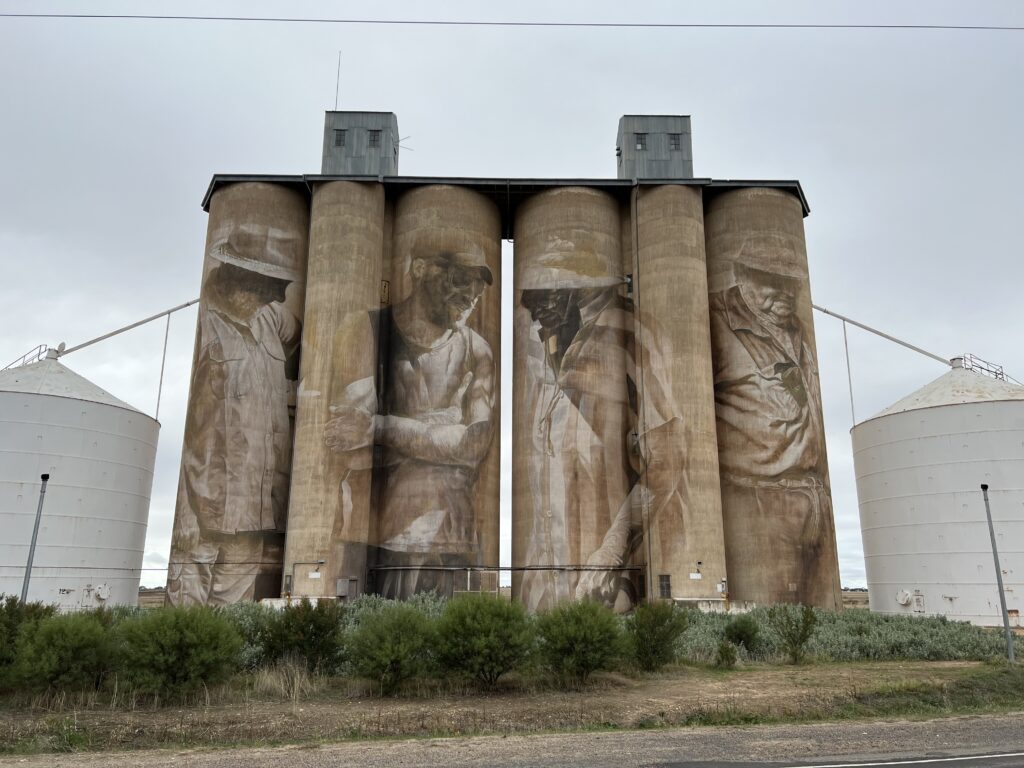
Guido is another Melbourne based artist, who was born in Canberra, ACT. He studied art at the Southern Cross University. Guido was nominated in 2016, for the Sir John Sulman Prize at the Art Gallery of NSW this work at Brim.
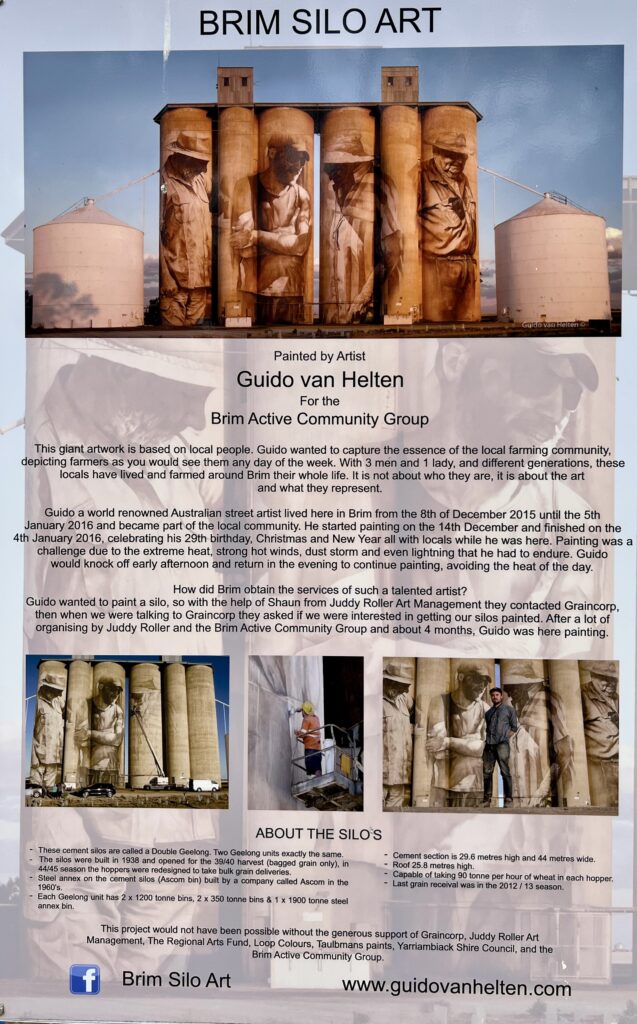
Completed in early 2016, with limited financial resources, van Helten’s mural depicts an anonymous, multi-generational quartet of female and male farmers. Rendered across these four 1939-built GrainCorp silos, van Helten’s subjects bear expressions that exemplify the strength and resilience of the local farming community. By rendering the figures as both central and peripheral, present and absent, the work explores shifting notions of community identity at a time when rural populations face both immense economic pressure and the tangible consequences of climate change. Using the documentary style of humanist street photography as studies, the translucent aerosol technique conjures a sense of ghostliness. The resulting characters are profoundly connected to their chosen place, infusing the landscape with a comforting, familiar presence. siloarttrail.com
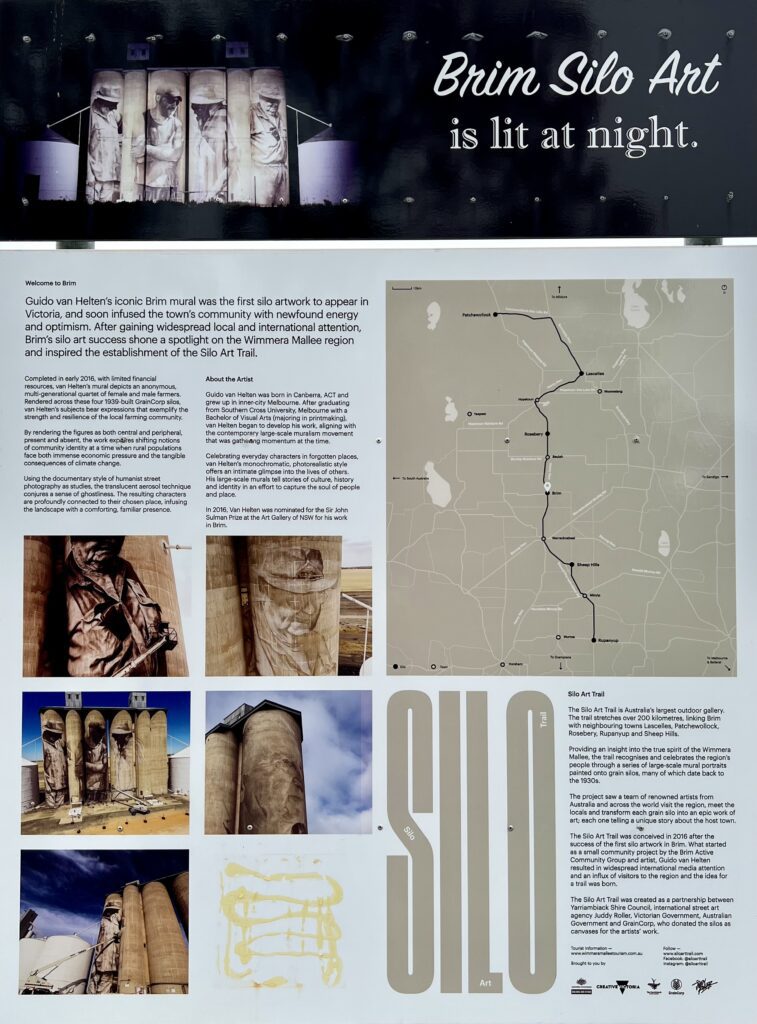
Check out Guido van Helten on his website , Instagram or Facebook .
Sheep Hills Silo Art – Adnate
The Sheep Hills silos, were actually the first of the silo art exhibits we saw on a previous trip . They are the work of Adnate, who is a Melbourne based artist. Anyone living in Melbourne would be familiar with his work for example in Hosier Lane.
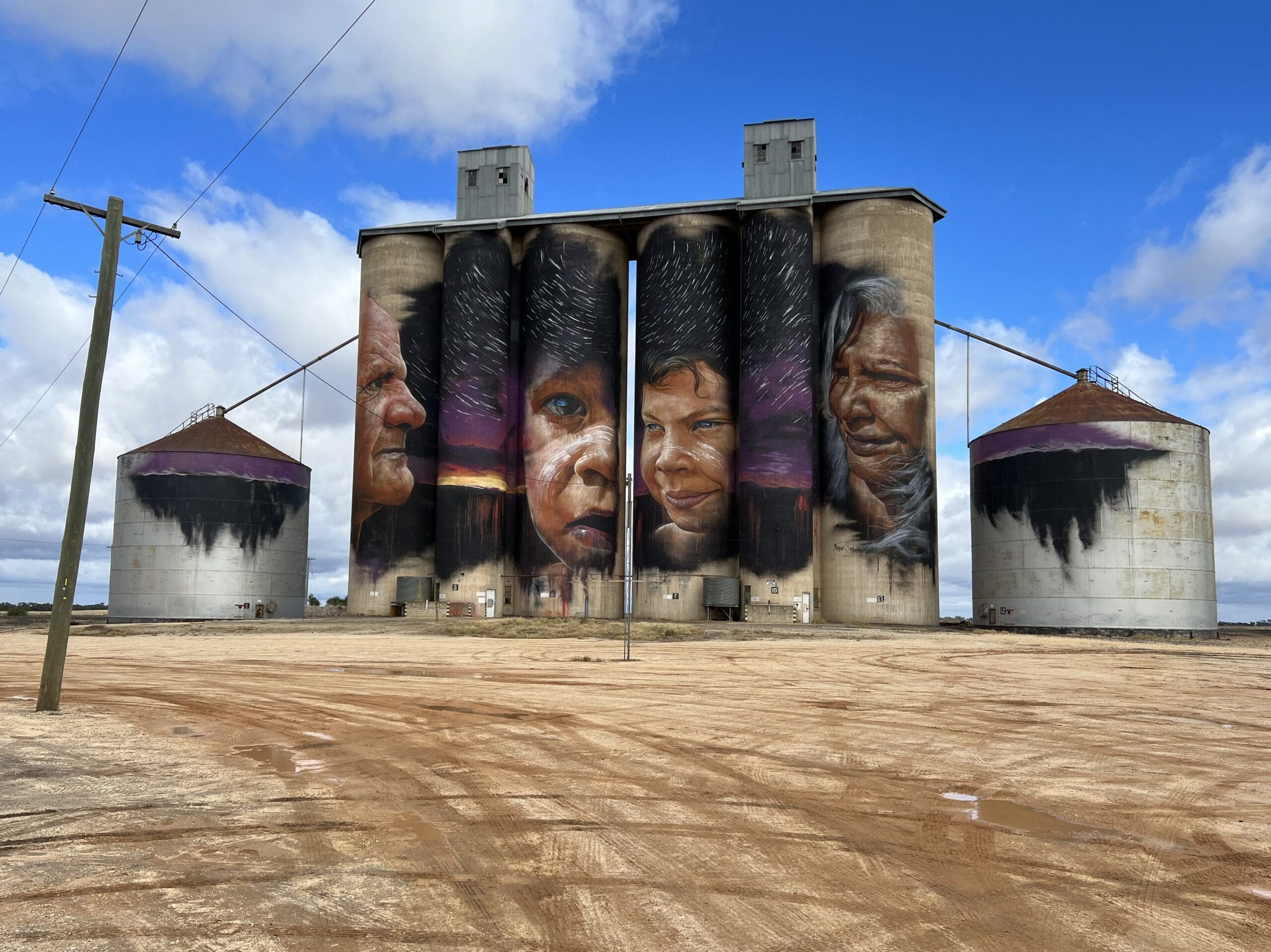
At the site there is an information board, which gives interesting background to the art. In this case the art is inspired by Adnate’s friendship with the Barengi Gadjin Land Council and took four weeks to complete from inception.

The Sheep Hills GrainCorp silos were built in 1938, Adnate’s depiction of Wergaia Elder, Uncle Ron Marks, and Wotjobaluk Elder, Aunty Regina Hood, alongside two young children, Savannah Marks and Curtly McDonald celebrates the richness of the area’s Indigenous culture.
In the picture, the night sky represents elements of local dreaming and the overall image signifies the important exchange of wisdom, knowledge and customs from Elders to the next generation.
Adnate says that he sought to shine a spotlight on the area’s young Indigenous people and highlight the strong ancestral connection that they share with their Elders.
Check out Adnate on his website , Instagram and Facebook . Most of the info above is also available on the Silo Art official website .
1 thought on “Victoria Silo Art Trail – Magnificent Wimmera Mallee Road Trip”
Pingback: Mildura Road Trip in Victoria – Interesting Places to Stop and Explore in the Mallee
Comments are closed.

THE STUNNING AUSTRALIAN SILO ART TRAIL GUIDE [+MAPS]
The Australian Silo Art trail features more than 40 silos that have been turned into works of art. If you’re looking for a unique way to explore the country, consider taking a trip to see some of these artistic masterpieces on the Australian Silo Art Trail!
Where was the first Australia Silo painted?
How many painted silos are there in australia, what about water towers, which state has the most silo art, how do towns and artists decide what to paint on their silos, silo art and water towers in new south wales, nsw silo art map, things to do nearby, merriwa silo (2019) – david lee pereira, narrandera water tower (2019), victoria silo art trail, victoria silo art map, lascelles (2017) – rone, goorambat silo art (2018-19) – jimmy dvate, devenish silo art (2018) – cam scale, the silo art trail in south australia, south australia silo art map, silo trail in western australia, western australia silo map, merredin silo (2017) – kyle hughes-odgers, silo art in queensland, queensland silo map.
This post contains affiliate links. Our full disclosure policy is here .
Silo Art is all about turning dull grey silos into beautiful pieces of artwork. Today we will share everything you need to know about it, from where to find the silos to who created them, how many there are and most importantly, perhaps, things to do nearby.
Since the first mural was painted on a Western Australian silo in 2015, silo art has become a surefire way to draw visitors to small communities across the country. Many people now travel to towns they would otherwise have never heard of to see these beautifully decorated silos. Hopefully spending some time and money in the community in the process.
The large canvases these artworks provide street artists have opened up a movement and given us Australia’s largest outdoor gallery.
We have included some water towers as the murals on these are just as impressive. As we have not yet seen all the silo’s ourselves, we asked a few friends to contribute and have noted this below.
Life on the lap, read our interviews with full-time travellers about lap their lap about Australia
Australian Silo Art Trail FAQ
The first official silo artwork appeared in Western Australia in 2015 when Phlegm and HENSE painted a silo in Northam. However, the Silo Trail concept was started by the Yarriambiack Shire Council in 2016. Since then, artists from Australia and around the world have been invited to paint silos with their own artistic expression.
There are approximately 45 painted silos in the Australia Silo Trail, although that number is constantly changing with new silos going up and, sadly, at least one coming down.
There are approximately 80 painted water towers in Australia, they are more common than silos in NSW, and there are more on the way.
Victoria has 20 * 19 silos making it the state with the most silo art in Australia. It is also our most compact state, so the best place to see a number of murals quickly. *One of Victoria’s original silos has been demolished.
If you are keen to explore beyond Australia’s coastline, hunting down silo art is a good way to get started.
While it is generally a collaborative process, artists take their inspiration from residents of the local community, the environment or the history of a place.
![The Stunning Australian Silo Art Trail Guide [+maps] 2 Silo close up](https://australiayourway.com/wp-content/uploads/2021/03/Silo-close-up.jpg)
In NSW, we have more water towers than silos. There are seven silos on the NSW Silo trail; in comparison, there are 23 water towers, and I have included the ones we have seen too! Three of the NSW silos were painted by Melbourne based artist Heesco. We managed to visit most of them last year as part of our NSW road trip.
We have featured the silos and water towers marked on this map.
![The Stunning Australian Silo Art Trail Guide [+maps] 3 NSW Silo art map](https://australiayourway.com/wp-content/uploads/2021/03/NSW-Silo-map.jpg)
Barraba (2019) – Fintan Magee
The 40m high grain silos at Barraba were Brisbane artist Fintan Magee’s second silo work after completing a mural at Patchewollock in 2016. He chose to paint the “Water Diviner”, which illustrates the old practice of looking for groundwater using metal rods or sticks, although, in this work, he has shown the farmer with sticks. The silos took a little over 3 weeks to complete.
![The Stunning Australian Silo Art Trail Guide [+maps] 4 Barraba silo 1](https://australiayourway.com/wp-content/uploads/2021/02/Barraba-silo-1.jpg)
If you have any interest in antiques or generally enjoy quirky things, be sure to check out the Shed of Knowledge museum, it’s opening hours are a bit hit and miss, so ask at the visitors centre when you get into town. Nearby Sawn Rocks in Mount Kaputar National Park is a great place to do some bushwalking. Another gem is Horton Falls, 45 mins drive from Barraba; there are two lookouts over the 83-metre drop; however, the falls best viewed after rain and the view not so impressive much of the year.
Where: Located 90km north of Tamworth along the Fossickers Way, Barraba is known as a bird watchers paradise with fourteen signposted bird routes.
Where to stay : We based ourselves in Tamworth and Armidale and drove past the silo on the way between the two, but there are plenty of campsites nearby. There is also a caravan park in town.
Coonamble Water Tower (2017) – John Murray, Sooty Welch and Bob Barrett
On the Castlereagh Highway, this water tower was a collaboration by Lightning Ridge local John Murray who painted the birds and Wailwan Elder Kevin “ Sooty ” Welsh, who added the Dreamtime artwork near the base. It was completed over 11 days and received a touch up in October 2020, just days after we took this photo.
![The Stunning Australian Silo Art Trail Guide [+maps] 5 Coonbamble Water Tower art NSW painted by John Murray](https://australiayourway.com/wp-content/uploads/2021/02/Coobamble-Water-Tower-art-NSW.jpg)
Galahs are common in this part of the state; we saw several on our overnight stay in Galargambone just down the road, making them a great fit for this design. The 25m tall tower is easily spotted from the road and there is plenty of parking nearby.
The town is a popular stop on the road from Dubbo to Lightning Ridge , and the drought has hit hard. We visited in September 2020, and many of the shops and even the pub were closed. They could really use your support so perhaps plan a meal stop here. There was a lovely cafe about a block from the tower heading into town. Directly across the road is a park perfect for a picnic lunch.
Wander the main street and discover the Nickname Hall of Fame , caricature of locals and how/why there were given their names. An insight into the Aussie sense of humour and some interesting background on how many nicknames were bestowed on the local settlers by the Aboriginal inhabitants based on their physical appearance or character.
Where to stay: There is a free camp at Nakadoo , on a farm just north of town. Take the optional shed tour for $10 to support the farm and learn more about the property’s history.
Galargambone Water Tower (2018) – Jenny McCraken – Lucky Dip
Just 50 minutes or so south of Coonamble is Galargambone’s water tower. The tower was painted as part of a local festival, ‘Pave the Way to Gular’, which saw artists including Kaff-Eine, Goodie, Sam Brooks, Peter Brown, Claire Foxton, Rudy Kistler, John Murray and DNart head to town to bring it to life with dozens of murals.
![The Stunning Australian Silo Art Trail Guide [+maps] 6 Galargambone Water Tower painted by Jenny McCraken](https://australiayourway.com/wp-content/uploads/2021/02/Galaragambone-Water-Tower.jpg)
Once you have visited the tower, spend some time hunting down the rest of the towns artworks. Pop into the local cafe for a coffee and a chat. The small town of 500 has worked hard to create their cafe, and it has a fascinating back story which I am sure they will be happy to share.
Australia Post released the kingfisher’s image on a stamp in 2020 as part of their commemorative Water Tower Art series.
Galargambone is about 1 hour from Warrambungle National Park and Siding Spring Observatory. Emu Logic Farm , just 35 minutes away, is also a fun place to visit ($15) and learn more about emus and maybe even find an emu egg. The farm is wheelchair accessible.
Where to stay: You can’t go past the Galargambone Caravan Park, one of the friendliest of our five-week NSW road trip. It’s dog friendly and has its own little farm on site. This is a lovely little town to stop and rest for a while.
Grenfell Silo (2019) – Heesco Khosnaran
Heesco painted his first silo in Weethalle in 2017 and it was that artwork that caught the eye of the owner of this silo at Grenfell Commodities who then commissioned the work.
![The Stunning Australian Silo Art Trail Guide [+maps] 7 Grenfell Silo painted by Heesco NSW](https://australiayourway.com/wp-content/uploads/2021/02/Grenfell-Silo-750.jpg)
Painted over five weeks, the mural depicts the local farming community and talking to locals; it’s clear the artist is much loved.
Grenfell is best known as the birthplace of the Australian poet Henry Lawson, and you will find the statue of him on a seat – pop in next to him for a selfie! It’s also worth stopping in at the old train station where you will also find another of Australia’s Big Things, the Big Gold Pick and Pan.
A visit in September will reward you with stunning canola fields on the roads near the town. In June, the town holds the Henry Lawson Festival .
Where to stay : There is a free camp near the railway station with BBQs and new bathrooms with hot showers. You will find them a 3-minute drive from the silo. You can find more details on camping nearby here .
Merriwa is a small, quiet, rural town located in the west of the Hunter Region of NSW. An agricultural town, it is best known for its cropping and sheep producing endeavours. Each year the Festival of the Fleeces is held in Merriwa, which features the famous ‘ Running of the Sheep ’, an event where hundreds of sheep run down the main road, all wearing red socks!
![The Stunning Australian Silo Art Trail Guide [+maps] 8 Merriwa Silos](https://australiayourway.com/wp-content/uploads/2021/02/Merriwa-Silos-1.jpg)
This iconic event is now depicted in the stunning silos painted by artist David Lee Pereira and completed in April 2019. The silos also feature the yellow canola flowers, which you can see growing in paddocks everywhere in spring.
Where to stay : If you are a caravanner and like the occasional free camp, then the ideal spot to stay is behind the Merriwa Services Club, don’t forget to drop into the club for some friendly country hospitality and a great meal.
Contributed by Mel from All Around Oz
Narrandera is a small rural town located in the Riverina district of NSW, right on the banks of the Murrumbidgee River. A once important stop for paddle steamers, who plied their trade up and down the river, the remains of the Wagga Wagga steamer can still be seen in the river today.
![The Stunning Australian Silo Art Trail Guide [+maps] 9 Narrandera 2](https://australiayourway.com/wp-content/uploads/2021/02/Narrandera-2.jpg)
During World War II a RAAF training base was established in town. A small museum in the town is now home to a DH82 Tiger Moth, together with other memorabilia, from the days of the training school. The museum is open seven days a week and entry is by a gold coin donation.
Narrandera is also home to a colony of some 200 koalas. If you take a walk through the Flora and Fauna Reserve, you may just be lucky enough to spot one or two. These koalas are an important part of keeping our koala population flourishing and healthy.
A community project in 2019, saw the two water towers overlooking the town, painted by the team from Apparition Media. The first tower depicts a koala and life on the river, whilst the second pays homage to the area’s strong Indigenous history.
Where to stay : If you are looking for somewhere to stay, then Lake Talbot Tourist Park is the ideal spot to base yourself for a few days.
Portland Silo (2018) – Guido Van Helten
Enhancing the industrial patrimony of rural towns can be a challenge. But one that some mural artists are certainly keen on. Old cement silos can be seriously ugly and often dominate the landscape of small towns in New South Wales .
![The Stunning Australian Silo Art Trail Guide [+maps] 11 Portland Silo NSW](https://australiayourway.com/wp-content/uploads/2021/02/lesterlost-travel-australia-nsw-portland-silo-art-trail-australia-your-way-1.jpg)
In the upper Blue Mountains, Portland is now a fairly run-down little town but was once known as the “town that built Sydney” due to its quarries, kilns and cement processing. The area around Lithgow, north of Katoomba, is fairly industrial, with power stations and collieries. The cement works of Portland were built in 1902 and became a significant employer. For a while, Portland thrived and even built an Olympic swimming pool. The cement works buildings are still fairly run down; however, they now house artists’ studios and events. The Foundations Portland, as the site is known, has yet to be fully renovated and repurposed, but the Coronation Hotel is an old pub open for business. The silos have been adorned by a mural composed by Australian artist Guido Van Helten. It consists of six local characters, long term employees of the cement works, who shared their stories and memories of working for the company to chronicle the life and legacy of Portland’s industrial past. Dressed in their everyday clothes and portrayed under different angles, the characters seem alive, and there is a touching, photographic element hidden in the folds of their clothing.
Visit Hassans Walls Lookout, just 30 mins from the silo. Where : Portland is 164 km west of Sydney and about 30 minutes from Lithgow.
Where to stay : You can make a day trip from the Blue Mountains or stay in nearby Lithgow, we stayed at the Workers Club on our last visit.
Contributed by Delphine from Lester Lost
Weethalle Silo (2017) – Heesco
This was Heescos’s first mural silo mural in NSW; he has now painted three, making him the state’s most prolific silo artist. You will find the 21m high silos on the main street of the tiny town 60km West of West Wyalong.
![The Stunning Australian Silo Art Trail Guide [+maps] 12 1024px Mural Painted Silos NSW 25460170988 1](https://australiayourway.com/wp-content/uploads/2021/02/1024px-Mural_Painted_Silos_NSW_25460170988-1.jpg)
One of my favourites for the cheeky sheep watching out from the middle silo, the silo also features a sheerer and a grain farmer.
Pop into the Road Kill Grillz for a snack.
Where to stay : Weethalle Showground offers basic camping for $10 per night.
The Victorian trail is the best known and most established, with twenty silos. It is also the easiest to visit with many of the silos quite close together. In fact, a single 200km road trip that starts 300km from Melbourne can help you tick off ten along a trail stretching from Rupanyup to Patchewollock .
Many of the Victorian murals are in the Wimmera Mallee region, with a few others closer to the South Australian border. You can also tour at least 4 in a day’s drive of Benalla. There are eleven water towers in Victoria.
![The Stunning Australian Silo Art Trail Guide [+maps] 13 Victorian Silo Art Trail](https://australiayourway.com/wp-content/uploads/2021/03/Victorian-silo-art-1024x596.jpg)
Rupanyup (2017) – Julia Volchkova
This smaller double silo structure, features two local kids in their sporting uniforms, a netballer and a rugby league player. Sport is a huge part of life in rural communities.
![The Stunning Australian Silo Art Trail Guide [+maps] 14 49535931971 2474b85b36 c](https://australiayourway.com/wp-content/uploads/2021/02/49535931971_2474b85b36_c.jpg)
Painted by Russian Artist Julia Volchkova, who was the first woman to paint an Australian silo. The monochrome design is beautiful in its simplicity. The mural features two local children Emily Baker, a netballer and Jordan Weidemann, in his AFL uniform.
Head into town to find the two murals of local firefighters created by Melbourne artist Georgia Goodie.
Where to stay: There are rooms at the Commerical Hotel in town, or you can camp Rupanyup Memorial Park for $10 per night.
It’s just 35km down the road to your next silo
Sheep Hills (2016) – Adnate
Known for his work portraying indigenous people, Melbourne artist Adnate’s mural includes portraits of Wergaia Elder Uncle Ron Marks and Wotjobaluk Elder Aunty Regina Hood and two local children. The mural took 4 weeks to complete
![The Stunning Australian Silo Art Trail Guide [+maps] 15 Painted silo Victoria Australia](https://australiayourway.com/wp-content/uploads/2021/02/149217-56-Adnate-SIlo-Victoria.jpg)
There is not much to see or do in Sheep Hills however nearby is the town of Minyip where the much loved Aussie TV show Flying Doctors was set. In Warracknabeal you will find The Creekside Hotel , the only one in the region with “water views”
Where is it: 325 km north-west of Melbourne
Just 45km along and you will reach Brim
Brim Silos (2015) – Guido Van Helton
The first silo in Victoria portrays a family of local farmers aka the ‘Farmer Quartet’ Van Helton painted these four 30m high silos over a three week period.
![The Stunning Australian Silo Art Trail Guide [+maps] 16 Rupanyup, VIC, Australia - November 08, 2017: Painted silos from artist Guido Van Helten, tourist attraction on Hume highway](https://australiayourway.com/wp-content/uploads/2021/02/Guido-Van-Helton-Silo-Victoria-742x1024.jpg)
Things have changed a lot since the completion of the mural for this little town of 100 residents with visitors now stopping by daily to take them in.
There is not a lot to do in the area; the Brim pub is a great place to grab a meal and support the community. You may even get to learn more about the faces on the silo from the friendly locals.
Where to stay : There is a campsite two minutes away from the silo. It costs approx $10 per night with or without power, and there are hot showers.
Next up 27km along the road, you will find Kaff-eine’s silo in Rosebery
Rosebery (2017) – Kaff-eine
Kaff-eine discovered the silo trail while her friend Rone was painting the silo at Lascelles and before long had one of her own to work on
![The Stunning Australian Silo Art Trail Guide [+maps] 17 Mural by artist Kaff-eine of farmers at Rosebery](https://australiayourway.com/wp-content/uploads/2021/02/Silo-art-Australia.jpg)
There is not much around this silo, but Horsham, a major centre for the region, is only a few km away
So far only five silo’s on the trail have been painted by women!
45 minutes in the car and you will reach Fintan’s impressive work at Patchewollock.
Patchewollock (2016) – Finan Magee
The 35m tall portrait of local grain farmer Nick ‘Noodle’ Hulland is one of the most popular along the trail. We are scheduled to see this one later in the year but thankfully our good friend Deborah Williams has come to the party and given us her shot to use (Thanks Deb!).
![The Stunning Australian Silo Art Trail Guide [+maps] 18 Patchewollock Silo Victoria](https://australiayourway.com/wp-content/uploads/2021/02/Patchewollock-Silo-Victoria.jpg)
Check out Phil Riggs’s Mallee Hen Sculptures . A visit in spring rewards with beautiful canola crops. October usually sees the Patchewollock Music Festival.
Melbourne artist Rone painted 4th generation farmers Geoff and Merrilyn Horman over a two week period. Stay tuned for this one when we visit in May. We also hope to visit nearby Lake Lascelles, where there is a free camp.
If you want more silos you can head 33km to Sea Lake where you will find a huge new mural by Joel Fergie & Travis Vinson.
The next four silos are located within 30km of each other and you can string them with three more located to the west to cover seven silos in 220km and a great short getaway.
This silo complex was completed in two stages, the first two parts with the first two scenes, a barking owl and a country scene, these working Cylsdales were added a year later.
![The Stunning Australian Silo Art Trail Guide [+maps] 19 Goorambat Silo Art Victoria](https://australiayourway.com/wp-content/uploads/2021/02/Goorambat-Silo-Art-Victoria.jpg)
Just 10km away in Devenish, you will find the next silo
This work commemorates those from the region who have served Australia during the war and includes a WW1 nurse and modern combat medic and a member of the Lighthorse Brigade.
![The Stunning Australian Silo Art Trail Guide [+maps] 20 Devenish Silo Victoria](https://australiayourway.com/wp-content/uploads/2021/02/Devenish-Silo-Victoria.jpg)
There are two more silos along this part of the trail that we have yet to discover in St James and Tungamah. From here you can head up to the Picola silo before backtracking down to Rochester.
Rochester (2018) – Jimmy D’Vate
The Victorian town of Rochester sits on the banks of the Campaspe River 200km north of Melbourne. The town’s twin silos were painted by Jimmy D’Vate in 2018 and feature images of threatened local wildlife – a squirrel glider and an azure kingfisher.
![The Stunning Australian Silo Art Trail Guide [+maps] 21 Rochester Silo Art](https://australiayourway.com/wp-content/uploads/2021/02/Rochester-Silo-Art-Curious-Campers.jpg)
The silos are on Ramsey Street in the middle of town; there is plenty of parking for people visiting with a van in tow. Rochester is a lovely looking town with plenty of parklands surrounded by heritage buildings. From the silos, you can’t miss the imposing Shamrock Hotel; it’s a great place for lunch and they also have accommodation.
Echuca is less than 30 minutes from Rochester, and there is a lot to do there. Explore the historic wharf area, go on a paddleboat ride or check out the National Holden Motor Museum. There are some great little towns around Rochester too. If you like the idea of a retro ice-cream bar visit Ciurleo’s in nearby Lockington.
The Gunbower National Park is less than one hour from Rochester. We spent half a day driving and walking around the wetlands and it is at the top of the list to go back with kayaks and camp there for a while. The scenery and wildlife in the park are wonderful.
Where to stay : There are plenty of caravan parks and Airbnb options around Echuca. We stayed at the Moama Riverside Holiday Park and had a relaxing time there. There are sites right on the river; it’s a beautiful spot.
Contributed by Natalie of Curious Campers
You will find the final silo in this section at Colbinabbin, a two-hour drive from Melbourne.
As of Feb 2021, there are nine silos in South Australia. The first was painted in 2017 by Guido Van Helton and can be found in Coonalpyn. The most recent was unveiled at Farrell Flat in October 2020. There are five water towers that you will find more about here . We have not seen any of the SA silos but have a trip planned for later this year.
![The Stunning Australian Silo Art Trail Guide [+maps] 22 South Australia Silo map](https://australiayourway.com/wp-content/uploads/2021/03/South-Australia-Silos.jpg)
Coonalpyn (2017) – Guido van Helten
Guido painted 5 local children over a one month period on these operational 30m high grain silos. The result – three new businesses and a steady supply of tourists.
![The Stunning Australian Silo Art Trail Guide [+maps] 23 Silo in Coonalpyn by Guido van Helton](https://australiayourway.com/wp-content/uploads/2021/03/Guido-van-Helten-silo-South-Australia.jpg)
Take a walk through town to explore more that has been installed since the Silo success. Get something to munch on from Waffles and Jaffles .
Where to stay : The pub in town is your best option if you want to stay the night
Wirrabara (2018) – Smug
The sleepy little town of Wirrabara in South Australia’s mid-north was just another bunch of buildings on the highway before their amazing silo art appeared in October 2018.
![The Stunning Australian Silo Art Trail Guide [+maps] 24 Wirrabara Silo Art Trail South Australia](https://australiayourway.com/wp-content/uploads/2021/02/Wirrabara-Silo-Art-Trail-South-Australia.jpg)
It took prolific, Australian-born street artist Smug three weeks to paint his first set of silos. The mural is 28m high and shows a woodcutter and a gorgeous little red robin. The theme and trees in the background and a tribute to the nearby Wirrabara Forest. Unlike other silos that used a local as the model, Wirrabara chose not to use a local as the face of their artwork.
When in Wirrabara, take advantage of that nearby forest for some hiking or pack a picnic for a relaxed lunch amongst the trees. If you happen to be in Wirrabara on the third Sunday of the month, enjoy browsing through the local produces markets and pick up some local produce and crafts. Where : Wirrabara is about one hour from the Clare Valley in one direction and even closer to the Southern Flinders Ranges in the other direction.
Stay a while: While there is accommodation at the Wirrabara Hotel or the Wirrabara Caravan park, why not enjoy a little luxury at the Wander Inn Wongabirrie, a delightful tiny house in a renovated stone building in the heart of town.
Contributed by Josie from Exploring South Australia
Check out these South Australia Road trips and find the rest of the SA Silos
Western Australia is where it all began, with the very first silo being painted in Northem by Phlegm & HENSE in 2015. There are now six in the state, but it has been a few years since there were any new ones. Looking forward to seeing more in the coming years. There are four water towers in Western Australia.
![The Stunning Australian Silo Art Trail Guide [+maps] 25 WA silo art](https://australiayourway.com/wp-content/uploads/2021/03/Western-Aust-silos.jpg)
Northem Silo (2015) – Phlegm & HENSE
You will find the mural that got the whole show on the road is also one of the most colourful. Located in the Avon Valley along the Central Wheatbelt there is plenty to do in the region to keep you busy making the drive a great choice for a getaway.
![The Stunning Australian Silo Art Trail Guide [+maps] 26 Silo in NorthamWestern Australia by HENSE and Phlegm](https://australiayourway.com/wp-content/uploads/2021/02/PUBLIC_2015_Northam_Silos_site-specific_mural_installation_on_the_CBH_Group_grain_silos_curated_by_FORM_funded_by_FORM_and_CBH_Group_in_Northam_Western_Australia_by_HENSE_2_of_2-1.jpg)
Be sure to drop into the flour mills and see the stunning artwork The Last Swans” by Amok Island and take some time to explore the visitors centre that highlights the post-war migrant history of the region. Finally, don’t miss the Bilya Koort Boodja indigenous centre , where you can learn about the area’s culture and environmental history.
Where to stay: Whitegum Farm is a great choice and only $25 for powered sites. You will find it 20 km east of York.
Just another 160km or so down the road you will find Merredin and a silo by artist Kyle Hudges-Odgers.
Newdegate Silo (2018) – Brenton See
Featuring native Western Australia wildlife, the public silos in Newdegate were painted by well-known Perth artist Brendon See in June 2018. They feature the Western Bearded Lizard, Mallee Fowl, Thigh Spotted Tree Frog, and Red-tailed Phascogale.
![The Stunning Australian Silo Art Trail Guide [+maps] 27 Newdegate photo by Rhonda Albom 1](https://australiayourway.com/wp-content/uploads/2021/03/Newdegate-photo-by-Rhonda-Albom-1.jpg)
About an hour’s drive to the west sits Lake Grace, one of Australia’s largest salt lakes. Or an hour’s drive southwest brings you to Pingrup.
Don’t miss the famous pink salt lakes and some great walking trails. If you can time your visit with wildflower season, you will be well rewarded. About 50km from town at Lake Grace is the Walker’s Hill Vineyard.
Where to stay: The Caravan Park offers pet-friendly sites.
Contributed by Rhonda from Albom Adventures
Pingrup (2015) – Evoca1
Pingrup’s silo art was completed in 2018 by Miami-based artist Evoca1 and represent a tribute to Western Australia’s farming communities.
![The Stunning Australian Silo Art Trail Guide [+maps] 28 Pingrup photo by Rhonda Albom PB040229 1](https://australiayourway.com/wp-content/uploads/2021/03/Pingrup-photo-by-Rhonda-Albom-PB040229-1.jpg)
After seeing the silos, be sure to relax with a coffee and a meal at the volunteer-managed co-op Store Cafe 6343.
From here, an hour’s drive west will bring you to Dumbleyoung, where you will find a replica of the Blue Bird, the vessel that broke the water speed record on Lake Dumbleyoung.
Where to stay: The Pingrup Caravan Park is clean and tidy and very affordable.
Contributed by Rhonda from Albom Adventures – Check out Rhonda’s WA Silo road trip to plan your trip
Ravensthorpe (2016) – AMOK Island
Taking 31 days to complete this 25m tall silo features the area’s most famous plant Banksia Baxteri. Showing all six stages of the development of the flowers.
![The Stunning Australian Silo Art Trail Guide [+maps] 29 Merredin Silo in Ravensthorpe WA 2019](https://australiayourway.com/wp-content/uploads/2021/02/MERREDIN-WESTERN-AUSTRALIA-1.jpg)
If you can time your visit with wildflower season, you will be delighted as the region comes alive with colour between August and October. The Annual Wildflower Show is usually held in early September.
Visit Fitzgerald River National Park , a UNESCO Biosphere Reserve, the largest National Park in Western Australia. You might also want to hunt down the Big Lollypop .
Where to stay : Less than 2km from the silo you will find the Green Haven Tourist Park
Albany (2018) – Yok & Sheryo – Seadragon
Albany’s historic port wheat silos were transformed in March 2018 as part of the PUBLIC Silo Trail in WA. The seadragon is the 4 th installment courtesy of FORM, a not-for-profit group looking to beautify and breathe new life into industrial areas of WA’s Wheatbelt.
![The Stunning Australian Silo Art Trail Guide [+maps] 30 Albany Silos Best Australian Street Art](https://australiayourway.com/wp-content/uploads/2021/02/Albany-Silos-Best-Australian-Street-Art.jpg)
The eye-catching 35m high seadragon was painted by Brooklyn-based Aussie/Singaporean duo Yok & Sheryo over 17 days. The bright and contemporary design, inspired by the little-known local marine species the Ruby Seadragon has really brightened up an otherwise dull industrial area of the port town, famous for its past whaling history and the historic departure point of troops for World War I.
Throughout Albany, you will also find wonderfully painted Western Power substations as part of the same art project, which has helped to brighten up the city and make for some great drive by fun when exploring Albany on WA’s south coast.
Unlike most of the WA silo installations in quite small country towns, the Albany silos are situated only minutes away from the CBD and the National ANZAC Centre on Mount Clarence, easy to take in as part of a scenic drive around Albany’s historic and sensationally beautiful King George Sound.
Where to stay : You will find plentiful accommodation options in town and in holiday parks spotted along the coast.
Contributed by Keri from Our Globetrotters
While you are in Western Australia don’t miss the street art in Bunbury , south of Perth
There are currently three painted silos in Queensland. The first was completed in 2017 and can be found in Thallon, and the most recent at Three Moon, Monto, in July 2020. Queensland is home to 38 water towers.
![The Stunning Australian Silo Art Trail Guide [+maps] 31 Queensland silo map](https://australiayourway.com/wp-content/uploads/2021/03/Queensland-Silo-art.jpg)
Yelarbon (2019) – Brightsiders
Complete your next installment on the Silo art trail and venture into Southern Outback Queensland . You will find the Yelarbon silo, 35 minutes from Goondiwindi, near the NSW border.
![The Stunning Australian Silo Art Trail Guide [+maps] 32 Queensland Silo Art in Yelarbon](https://australiayourway.com/wp-content/uploads/2021/02/DJI_0914.jpg)
This was the 31st Art piece to be entered into the Silo Trail and was created by Jordache Castillejos and Jordon Bruce of Brightsiders, and Steve Falco from Procreative. At 24 metres high, it is a unique construction with two tall and six small silos that were bought to live with 1000 litres of paint in 2019.
The Silo titled “When the rain comes” depicts a young boy cooling off in the nearby Yelarbon Lagoon, with his paper boat set to float across the water. The paper boat was painted from remnants of historical new papers, symbolising the history of the region.
If you have some time, I suggest checking out the Yelarbon Lagoon. With picnic tables and barbecues available, this could be a great “bring your own” lunch stop with a lake view.
Where to stay : The Yelarbon community consists of less than 500 people, and you’ll be able to access some accommodation that suits your budget from camping, motels, and pubs. Alternatively, Goondiwindi is 30 mins to the west and Stanthorpe 1.5 hours towards the east. The silos are on the Highway, and an easy 15 mins stop when passing through.
Contributed by Chris Fry from Aquarius Traveller.
As we continue to explore, we will add to this page so bookmark it and head back before your next trip!
Got a question? Head over to our Australia Travel Tips Facebook Group and ask a local.
Leave a comment
Privacy overview.
only1invillage

Victoria’s Silo Art Trail – Don’t Miss Out!
Need inspiration for a weekend getaway from Melbourne? The Victoria Silo Art Trail is packed with fantastic art work and history. Get up close and personal to these monumental silo paintings which are truly fascinating and also give an insight into rural life in Australia.
Quick Index
- Where are the Victoria art silos located?
- How to get to the silos
- Map of the silo art trail
- Goorambat silos
- Devenish silos
- St James silos
- Tungamah silos
Think you can tell apart a Monet from a Manet, a Van Gogh from a Gaugain? Well, you won’t have to on the Victoria Silo Art Trail because the massive grain silos have been painted by local Australian artists! Go and visit the countryside towns and inject some cash into the rural communities this weekend.
Where are the Victoria Art silos located?
Situated about 2.5 hours drive from the city of Melbourne in the state of Victoria. The first town is called Goorambat. Even though it is called officially the North East Victoria Silo Art Trail, the first town with a silo is Goorambat.
How to get to the Victoria Art silos
You really need a car to get around the small rural towns to see all the artworks. They’re not as close together as they look on a map. They’re definitely not within walking distance of each other either.
Map of the Victoria Silo Art Trail
It is best to download this map from the Benalla Tourism office.
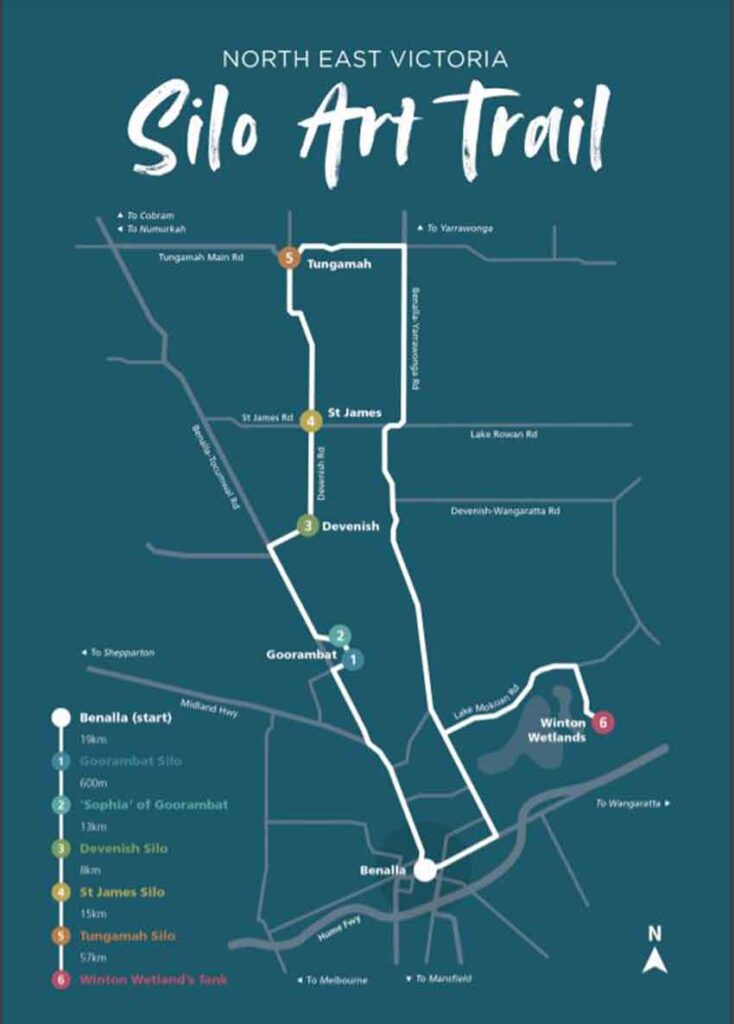
Incidentally, before you embark on the Victoria Silo Art Trail, you should stop off in the town of Benalla. At the local Art Gallery, which is free, there is also an excellent coffee shop. An attached gift shop, is also a chance to buy a unique Australian souvenir.
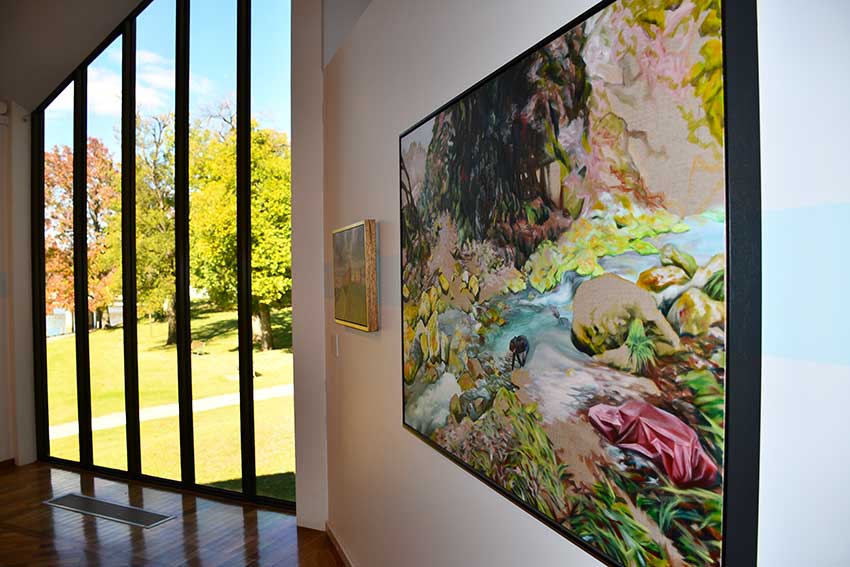
Outside the art gallery, along the river, there are also some interesting Gaudi-esque type installations which are worth a look. Plus, the town itself has lots of wall murals to discover.
What you’ll see on the North East Victoria Silo Art Trail
You’ve guessed it, tall silos with paintings on them!
Goorambat Silos
As the map suggests you start in Goorambat. This is where you’ll see the horses silo, the owl and the Church painting, (“the Sophia”) if it is open.
When you turn to your left, you’ll see the endangered animal bird of prey silo.
If you’re feeling a bit peckish or thirsty, head over the road to the Railway hotel pub!
Time to jump back in the car and find the next painting. Dubbed “Sophia”, she is the female representation of God. The artist is Matt Adnate. Originally the painting completed in 2017, was only meant to be open for the Easter weekend. It proved so popular that it is now open every day for visiting tourists.
Devenish Silos
After seeing the lady herself, it’s time to go to Devenish, which is 13kms away. It isn’t signed very well and Google maps isn’t great. Check your odometer and if you haven’t arrived in 10 minutes, you’re lost. Alternatively, you can follow other cars because there’s only one place they’re going, to the next silos on the trail, like you!
The Devenish silos pay homage to the military and in particular to ANZAC day. ANZAC day is an Australian holiday that commemorates soldiers in the Australian and New Zealand Army Corps.
The local town of Devenish saw fifty young men and women enlist for WWI. Seven never made it home and the artist, Cam Scale wanted to honour the memory of these fallen with the third silo painting of a young man and his horse. There are detailed information boards to read at every silo site, where you can get the full history of the paintings.
If you’re feeling hungry again, or, you didn’t stop at the pub in Goorambat, you can have some scones at the Devenish pub, directly opposite the silos! Word has it that they’re very tasty!
In Devenish in front of the silos are information boards which give you a deeper insight into the history of the silos. Right, onto the next town called St James.
St James Silos
The St James Silos tell a story about rural farming life and how one of Australia’s largest supermarkets started. You’ll see some familiar horses pulling bushels of wheat on a wagon, a truck, a portrait of George Coles and two men sewing up a wheat sack.
Tim Bowtell is the artist. You might recognise his work from other pieces in the town of Benalla, including work in the Makoan Rest Area.
Tungamah Silos
Stop 5 is the small town of Tungamah. There are two colourful silos to see here.
The Tungamah silos celebrate Australian birds. You will see dancing brolgas, a kookaburra, a pink and a grey galah, a Humming bird, an owl, a Sulphur-crested cockatoo, two small wrens and white Ibis. The tree is a native Australian gum tree. The silos still work and are privately owned. They have been fenced off.
The artist is Sibrane Simcock. She is the first female silo artist.
According to the map, you can now drive on to the Winton wetlands area. You may just spot some of the birds you’ve seen at the Tungamah silos! We didn’t get there, but if you do, we’d love to hear all about it. Please share your comments and thoughts below.
Related Posts
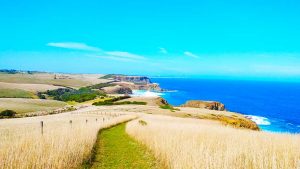
George Bass Coastal Walk
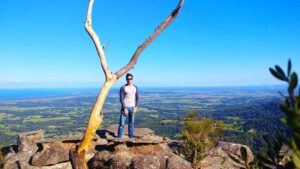
Drawing Room Rocks Walk the perfect picnic spot
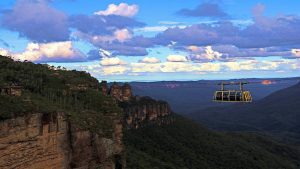
A Wonderful Weekend Hiking and Sightseeing in the Blue Mountains.
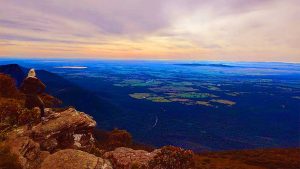
The Grampians 7 days of wonderful walks
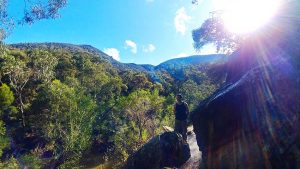
Don’t miss this quick 1hr refreshing Lerderderg Grahams Dam walk
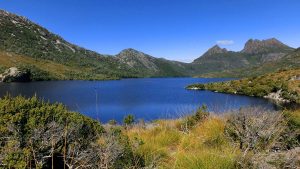
Tasmania 5 things you must do
Village news.
Subscribe to our newsletter to hear about unique travel destinations, when to go, what to see and other top travel tips!
Email address:
Leave a Reply Cancel Reply
Your email address will not be published. Required fields are marked *
You may use these HTML tags and attributes:
Sign me up for the newsletter!
Road trip Australia: the remote Silo Art Trail
Book your individual trip , stress-free with local travel experts
- roughguides.com
- road-tripping-australias-remote-silo-art-trail
Plan your tailor-made trip with a local expert
Book securely with money-back guarantee
Travel stress-free with local assistance and 24/7 support
written by Anita Isalska
updated 21.09.2018
Australia's largest open-air art gallery is so vast that you'll need a car and a map to explore it. Deep in Victoria's farming country, the Silo Art Trail consists of grain silos adorned with epic portraits, spread across a distance of more than 125 miles.
- Rupanyup: embarking on Australia's Silo Art Trail
Sheep Hills and Brim: portraits of a tight-knit community
Rosebery: harsh landscapes, hardy communities, lascelles and patchewollock: the end of the road.
Four hours' drive from Victoria's capital, Melbourne, these old grain silos are a fitting canvas for artwork representing the triumphs and challenges of life in the back of beyond. Standing sentinel over tiny rural communities, the painted silos offer a fascinating insight into small-town Victoria. It's a thoroughly unique Australian road trip.
Tailor-made travel itineraries for Australia, created by local experts

12 days / from 2900 USD
Explore Western Australia from Perth to Broome
Western Australia is the country's largest state, covering more than a third of Australia. This self drive itinerary allows you to explore sunny Perth, stunning national parks and waterfalls, the remote wild west outback, empty beaches and much more.
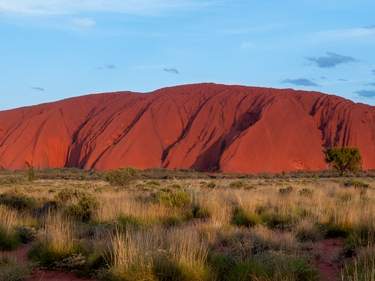
16 days / from 3300 USD
Explore South Australia and the Northern Territory
Explore South Australia and the Northern Territory on this self-drive adventure. Start in Adelaide and make your way over the Ayers Rock, Kings Canyon, and Alice Springs to the Kakadu National Park and ultimately Darwin.

23 days / from 4150 USD
Cross Western Australia to Darwin
Western Australia offers wonderfully remote outback experiences: from spectacular national parks to sandy deserts, pristine beaches to working cattle stations. This itinerary allows you to explore the way from Perth to Darwin in depth and at your own pace, in your own rental car.
Rupanyup: embarking on Australia's Silo Art Trail

Local sporting heroes on the Rupanyup silo by Julia Volchkova © Nicole Reed
The traffic begins to pick up speed as I drive out of Melbourne. Before long, a lone pie shop and gas station appear – the sum of a town. Crows pick at wallaby carcasses by the side of the road. The sky hangs heavy and velvet, like a theatre curtain.
My first stop is Rupanyup, home to the southernmost work in the Silo Art Trail . A black-and-white mural of two local sporting heroes is emblazoned across a huge grain silo. Painted by Russian artist Julia Volchkova in 2017, each figure has an enigmatic gaze.
There's not a great deal for them to gaze upon in Rupanyup, with a population of 344. Boasting ideal soil conditions in which to grow chickpeas and lentils, Rupanyup bills itself as 'A town with pulse'. When I ask a local in the general store if there's a good place in town to stay the night, he replies with a familiar Aussie refrain – "Yeah, nah" – and urges me to drive on.

Indigenous people by Adnate © Nicole Reed
Some 30km beyond Rupanyup is Sheep Hills, a remote trading post that became a township when the railway arrived in 1886. Tucked away from the main road is the Silo Art Trail's most dazzling piece of work, a violet-flecked group portrait of generations of local indigenous people.
Forty minutes further north, past Warracknabeal (claim to fame: birthplace of Nick Cave) is Brim (claim to fame: a million-dollar bale of fine wool). The township's name comes from the aboriginal word for 'spring', and it's also the source of the trail, the place where the first artwork sprang up. A local community group had become concerned that their decommissioned silo, which dates to 1938, was becoming an eyesore, so they were seeking a way to beautify the space.
"Their thinking was a nice garden in front of it," explains Shaun Hossack, originator of the Silo Art Trail concept. "But we took that a whole lot further with the now famous Brim artwork by Guido Van Helten."
Renowned street artist Van Helten covered the silo with a sepia portrait of generations of Brim locals, which blends harmoniously with the dun-brown landscape. Thanks to solar lighting, it's also the only silo you can view at night.
"We wanted to create work about people, for the people," elaborates Shaun. "Farming is tough sometimes and we wanted to reflect the strong character of the people that engage with this form of work as a living."

Farmers and livestock by Kaff-eine in Rosebery © Nicole Reed
Country grit and determination also emanate from an artwork 23km north, in Rosebery, depicting a man and a woman with their livestock. The woman has a confident stance, and meets the viewer's gaze.
"I wanted to reflect what I saw happening in the area," explains the artist Kaff-eine . "Female farmers, even very young ones, were confidently and passionately taking the reins in family farms and running the enterprises on their own."
Meanwhile, the male figure is in a relaxed pose, almost nuzzling his horse.
"I wanted to paint the type of outback masculinity that I feel should be championed," he continues. "The generous, secure masculinity which allows for gentleness, genuine relationships, quiet and introspection."
There's a lot of life in this pocket-sized township (population 100), largely thanks to the multipurpose cafe, gallery and venue known as Mallee Sunsets, which occupies a timber church built in 1920. Maxine Mitchell has owned this building for almost two decades, having rescued it from dereliction. She chuckles as we discuss the impending 20-year anniversary of Mallee Sunsets.
"I'm hoping to make it to 2020," Maxine laughs. Will she be popping some champagne?
"I'll have a sausage sizzle," she replies. Spoken like a true Aussie.

Artist Fintan McGee's Patchewollock mural © Nicole Reed
My car's fuel gauge is dipping lower as I drive out of Rosebery, but I pay it no mind. My trusty online map has flagged up a number of fuel outposts, so I speed ahead to Lascelles and its double-barrelled silo. Melbourne street artist Rone sought out people who had lived their whole lives in Lascelles, and found inspiration in the merry-faced Geoff and Merrilyn Horman. Their faces, bleached by the sun, now smile gently down on Lascelles.
30 miles further on, Patchewollock takes its name from aboriginal word 'wallah' meaning 'porcupine grass' – something like tumbleweed, somewhat fitting for this lonely place. Standing tall in technicolour is artist Fintan McGee's mural, a portrait of a local farmer with hay-coloured hair set against a periwinkle-blue sky.
I pull up by Patchewollock's sole fuel outfit and general store, where a hand-written sign urges me to call one of two mobile phone numbers. No-one's around. As I ponder a long night in Patchewollock, a lady rushes to my aid, advising that I'll likely make it to the town of Speed, just 12 miles away.
"I'll follow you with my jerry-can," she says, eager to help a stranger whose car is at risk of clapping out on a dusty country road.
The presence of my jerry-can-toting guardian angel acts as a talisman and I reach the Speed petrol station without issue. As she pulls away, she calls out, "Watch out for the emus". The buzz of the petrol pump at my hand, I ponder at how much, in this unforgiving landscape, one is totally reliant on human kindness.
My car kicks up a flare of ochre-coloured dust as I begin the drive back south. The road slices through clusters of silver gum trees, passing a few silos that are unadorned: they seem like blank canvases. With so many stories out here in Victoria's countryside, it can't be long before they, too, are given tales to tell.
Top image: Brim locals by artist Van Helten © Nicole Reed

Anita is an editor and writer based in California. British by birth, Polish at heart, Aussie by marriage and French by sheer obsession, Anita writes about inspiring people, places and technology. When she isn't researching Central and Eastern Europe, interviewing wine makers or editing copy, Anita is thundering down ski slopes. Follow her @lunarsynthesis on Twitter and Instagram .
- See & Do
Planning your own trip? Prepare for your trip
Use Rough Guides' trusted partners for great rates
Travel advice for Australia
From travel safety to visa requirements, discover the best tips for traveling to Australia
- Eating and drinking in Australia
- Getting around Australia: Transportation Tips
- Travel Health Australia
- Sports and Outdoor activities in Australia
- How to get to Australia
- Travel Tips Australia for planning and on the go
- Travelling with children in Australia
- Best time to visit Australia
Find even more inspiration for 77 here

Ready to travel and discover Australia?
Get support from our local experts for stress-free planning & worry-free travels.
- Where to stay
- Itineraries
- Travel advice
DRIVES AND ROAD TRIPS

The Australian Silo Art Trail – Ultimate Guide
Since cultural organisation, FORM , conceived the idea to paint a gigantic vault in the WA town of Northam in 2015, silo art has exploded across Australia.
Colourful creations are now plastered all over these towering structures in upwards of 50 locations, predominantly regional centres.
And that’s without mentioning the many painted water towers and tanks scattered across the land.
Where can you see silo art in Australia? Here’s a highlights package of key areas and locations to note for your next road trip – separated by state.
Whether on the way or detouring from the main stretch, add pretty pics of these spectacular artworks to your social accounts.
Where it all began – Northam, WA. Photographer: Bewley Shaylor. Image courtesy: FORM.
Silo art trail Victoria
While the movement didn’t originate within its borders, Victoria has emerged as the ‘silo art capital of Australia’. Twenty-plus locations boast vibrant storage structures: The Wimmera-Mallee and North East regions are hotspots.
Wimmera-Mallee silo art
More than half of Victoria’s silo art destinations are found in this area, which incorporates the western reaches of the state. Highlights include:
Albacutya: A multi-faceted and extremely colourful creation; 235km south of Mildura .
Brim: VIC’s first silo mural and the work of renowned artist, Guido van Helten; 170km southwest of Swan Hill .
Goroke: Native birds steal the spotlight; 70km west of Horsham.
Kaniva: More winged wonders vibrantly showcased; 45km east of Bordertown, SA.
Kaniva is on the main route that links Melbourne with Adelaide.
Lascelles: Heroes a local couple, as created by famous street artist, Rone; 105km west of Swan Hill.
Nullawil: Reveals a classic country scene of a kelpie with its owner; 85km southwest of Swan Hill.
Sea Lake: World-famous Lake Tyrrell features on a truly magnificent mural; 70km west of Swan Hill.
Sheep Hills: Another absolute eye-catcher, this one with an Indigenous focus; 55km northeast of Horsham.
The Wimmera-Mallee silo art map is a handy guide.
The silo art at Sea Lake is awash with captivating colours.
North East Victoria silo art
This pocket of the state has a high concentration of tinged towers, too. Head to the following towns:
Devenish: Two neighbouring silos are a nod to community involvement in major military conflicts ; 45km west of Wangaratta .
Goorambat: Various enchanting scenes appear over three silos; 45km west of Wangaratta.
St James: A tribute to Coles supermarket founder and one-time resident, Sir George Coles; 50km northwest of Wangaratta.
Tungamah: Various birds again take centre stage; 30km southwest of Mulwala , NSW.
Poignant: Devenish silo art.
Elsewhere, other highlights include silos at Rochester , 65km west of Shepparton ; Rupanyup , 65km north of Halls Gap ; and St Arnaud , 105km west of Bendigo .
Rupanyup is among myriad places in VIC to admire artists' talents.
Silo art trail NSW
The artwork is spread far and wide around NSW. Check out the intricate designs displayed on these towns’ sizeable storage bins:
Barraba: Artwork speaks to the pertinent theme of drought; 90km north of Tamworth .
Dunedoo: Multiple silos. A side of one structure features legendary racehorse, Winx, her trainer, and her regular jockey who was born in Dunedoo; 80km north of Mudgee .
Grenfell: Spectacular representation of the local shire; 65km south of Forbes .
Gunnedah: Includes an image of Dorothea Mackellar and an extract from her famed poem, My Country ; 75km west of Tamworth.
Perspective: Barraba silo art. Credit: Destination NSW.
Merriwa: Art centred around the all-important merino-sheep industry; 125km northeast of Mudgee.
Murrumburrah: Illustrates scenes of great significance to the area; 125km northeast of Wagga Wagga .
Portland: Honours former Portland Cement workers. Just off the main path between Sydney and Mudgee; 110km south of Mudgee.
Weethalle: Portrayal of the region’s deep agricultural heritage; 200km northeast of Hay .
Agricultural heritage is the theme of the day at Weethalle. Credit: Destination NSW.
Silo art trail WA
This is where it all began! And since a silo in Northam was slapped with paint, the colour show has extended to half-a-dozen destinations in WA. They are:
Albany: Pays tribute to the rare discovery of a seadragon off the state’s south coast in 2017. Check it out on a Perth to Albany road trip . Albany is 420km southwest of Perth.
Merredin: Artwork influenced by the region’s agricultural industry; 260km east of Perth .
Newdegate: Local wildlife is the headline act, showcased in colourful fashion; 275km northeast of Albany.
Newdegate's silo art features local wildlife. Photographer: Bewley Shaylor. Image courtesy: FORM.
Northam: Features a long row of silos with two distinct murals at either end; 95km northeast of Perth.
Pingrup: Art inspired by events and attractions of significance to the town; 235km northeast of Albany.
Ravensthorpe: Cleverly illustrates the growth of an endemic shrub; 305km northeast of Albany.
See the PUBLIC Silo Trail map .
Pingrup is one of six WA sites displaying colourful vaults. Photographer: Bewley Shaylor. Image courtesy: FORM.
Silo art trail SA
More than a dozen striking silos are dotted around the state and include the following areas…
Riverland silo art
Witness the eye-catching storage structures in these two towns:
Paringa: Four silos honouring local legends; 260km east of Adelaide, 5km east of Renmark .
Waikerie: Dual-sided art allows viewing ops from the river and on land ; 180km northeast of Adelaide.
If driving from Adelaide to Loxton , the main path takes in Karoonda . Its silo art is a nod to the town’s farming heritage.
Admire Waikerie's silo art from all angles. Credit: David Sickerdick.
Eyre Peninsula silo art
The Eyre Peninsula is rich with scenic sights. The painted silos in these locations simply add to its army of eye candy:
Cowell: Depicts a story of a local celebrity; 105km southwest of Whyalla.
Kimba: Stunning piece spread over five-and-a-half silos; 145km west of Whyalla.
Tumby Bay: Features two people jumping from the local jetty; 50km northeast of Port Lincoln, 390km southeast of Ceduna .
Simply stunning: Kimba silo art. Credit: Michael Waterhouse Photography.
Coonalpyn silo art
Located 65km southeast of Tailem Bend , Coonalpyn is home to the first silo painted in SA (March 2017). It highlights five local primary school children.
The town makes a great stop on the Dukes Highway when taking the most direct route between Adelaide and Melbourne. Alternatively, pull over for a break and a photo op during an Adelaide to Mt Gambier road trip .
Coonalpyn's mighty murals can be viewed from the highway.
SA silo light shows
The Flinders Ranges town of Quorn and Wallaroo , 20km north of Port Hughes on the Yorke Peninsula, both have spectacular night shows that add an extra layer of captivation to their respective silos. This is also the case for aforementioned Karoonda .
Up in lights: Karoonda silo art. Credit: Mezzino Photography.
Silo art trail QLD
There is a trio of locations to keep in mind when taking a QLD road trip. Each has bold works painted on multiple silos:
Thallon: Depiction of a Thallon sunset is a highlight; 365km west of Warwick .
Three Moon: Vivid colours detail a local legend; 40km southeast of Cania Gorge National Park .
Yelarbon: Includes two tall and six shorter silos; 50km east of Goondiwindi.
Yelarbon's silo art is extensive. Credit: Tourism and Events Queensland.
Meanwhile, in Tasmania…
Silo art has not taken off in Tassie, but that doesn’t mean the eyes can’t be treated to a captivating kaleidoscope of colour.
The pleasant dairy-farming town of Sheffield, 25km south of Devonport and just a tad further from Ulverstone , has reinvented itself to earn the title of Tasmania's Outdoor Art Gallery.
It’s all to do with a whopping 200 or so murals that adorn the walls of buildings scattered around Sheffield as well as its neighbouring towns.
The paintings are a tribute to the area’s past, its people, and various events.
Sheffield is a sea of colour. Credit: Jess Bonde.
Silo art trail map
This silo art map is a great visual aid for getting a handle on the many superb silos sprinkled around Australia.
Spotlight stealer: Sheep Hills silo art.
Time for a road trip? Start by booking a stay with BIG4 now. See all parks here .
Perks+ members SAVE on stays, plus loads more!
Already a member? Sign in
Find a park
- Make a Booking
- Pet Friendly Parks
- New South Wales
- Northern Territory
- South Australia
- Western Australia
BIG4 Membership
- Become a Member
- Sign in to Membership
- Renew Membership
- Forgot Member Number or Password?
- Member Benefits
- Membership FAQs
Shop & Order
Big4 gift cards.
- Join Our Park Network
- Media Enquiries
- FAQs & Help
- BIG4 Privacy Policy
- Holiday Guide
Inspire someone you know to get out and explore this beautiful country of ours. Start them on their way by surprising them with a BIG4 Gift Card .
BIG4 Holiday Perks+ Membership
Enjoy 10% savings (up to $50) on every BIG4 holiday plus heaps more! Learn more .

*For more information on BIG4's Price Guarantee please see our Terms & Conditions
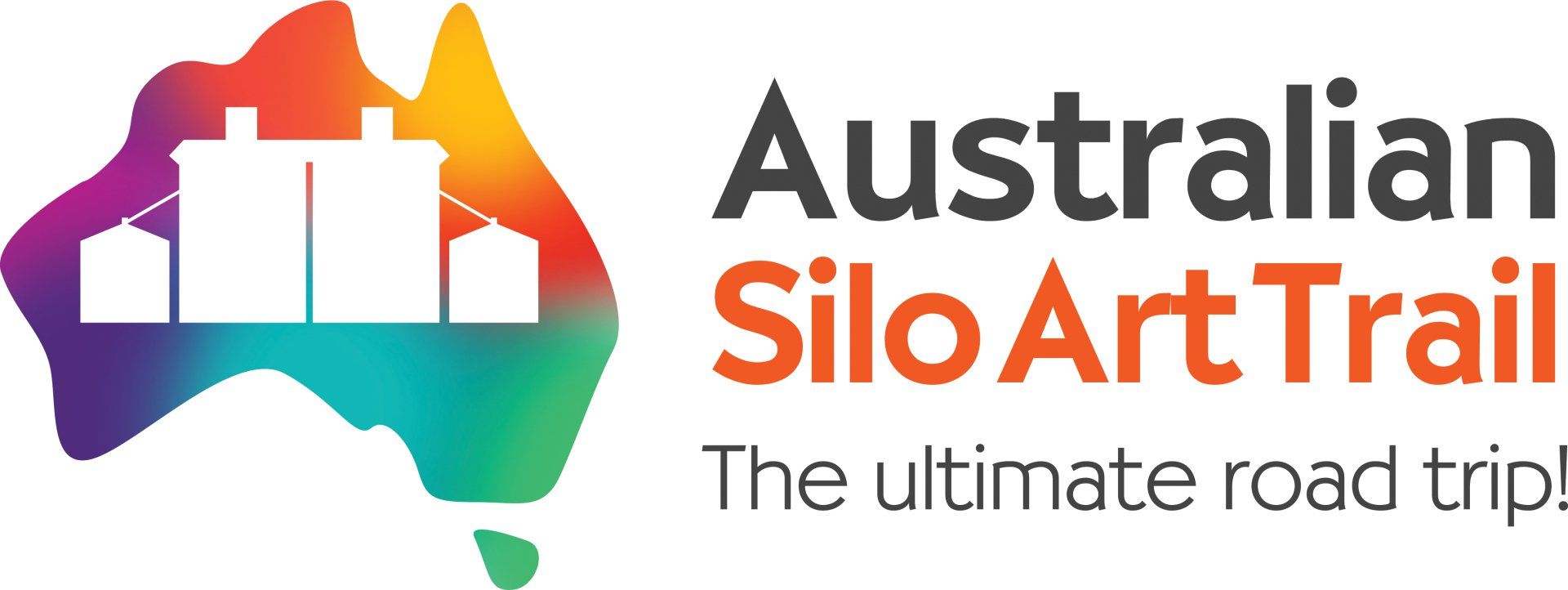
- WATER TOWER ART
- STREET ART TOWNS
- WORK WITH US
- 2025 Silo Art Calendar Nomination
- PROPOSED NEW SILOS
- COPYRIGHT GUIDELINES
Silo & Water Tower Art Map
Red Pins... Silo Art. Purple Pins .... Water Tower Art. Black Pins ... Street Art Towns
Maroon Stars .... Street Art Locations.
To expand the map and access search functions, click the square in the top right corner.
Know of any missing artwork? Please let us know.
PO Box 1983, MANDURAH WA 6210, Australia
Asking for Copyright permission?
Water Towers About
Privacy policy, american silo art, work with us, online store, credit application, menu home silos water towers about gallery contact faq downloadable map work with us media kit online store credit application.
Account Options

Originally just a local community project , Brim silo’s murals were an instant success, drawing in visitors from far and wide and bringing much needed tourist dollars .
The idea for a silo art trail quickly followed. Five other silos in the Wimmera Mallee region were given the same treatment, all linked by around 200 kilometres of rural highways , and each painted by a different artist. The theme of each artwork is to celebrate the local community.
Nullawil silo - the Latest Addition to the Silo Art Trail
Originally the silo art trail consisted of six painted silos. In July 2019, the seventh and latest addition to the Victoria silo art trail was completed in the town of Nullawil .
Sticking to the celebratory theme of the silo art trail, Nullawil’s painted silo honours one of Australian farming’s most loyal workers, the kelpie sheepdog .
How to Get to Victoria's Silo Art Trail

Victoria’s silo art trail is in the north west of the state. The seven painted silos all form part of a 300 kilometre long route .
The most southerly silo is found in the small town of Rupanyup , around a three and a half hour drive from Melbourne , and two hours from both Ballarat and Bendigo . Halls Gap in the Grampians is just under an hour away.
The Painted Silos of Rural Victoria

Rupanyup Silo by Julia Volchonkova
At the southernmost end of Victoria’s silo art trail is Rupanyup . Rupanyup’s silo focuses on the town’s youth and future, featuring monochrome portraits of Ebony Baker and Jordan Weidemann, two of the town’s young athletes .
Kitted out in their sporting attire, the portraits of Baker and Weidemann are imbued with a sense of hope and optimism.
Rupanyup silo was painted by the Russian artist Julia Volchkova, who has created several large scale murals in places all over the world, most recently in Mexico and Malaysia .
Sheep Hills Silo by Adnate

Sheep Hills ‘ silo is without a doubt the most colourful on the trail. Painted by Melbourne based artist Adnate , Sheep Hills’ silo art celebrates the region’s strong Indigenous culture and heritage .
Across six silos, Adnate has painted a stunning series of celebratory portraits of two local Aboriginal elders, Uncle Ron Marks and Aunty Regina Hood, alongside two Indigenous children, Savannah Marks and Curtly McDonald.
A bold and brilliant burgundy sunset represents the complex and hugely important ancient Aboriginal spiritual belief commonly known as Dreamtime .
Adnate’s portraits also symbolise the historical and significant Aboriginal tradition of handing down wisdom and learning from one generation to the next.
Brim Silo by Guido Van Helten

Brim ‘s silo was the very first to be painted in the area, the success of which inspired the idea for a silo art trail.
Looking for a suitable location to paint a series of large scale portraits, Guido Van Helten was offered the chance to paint on the decommissioned silos at Brim.
Van Helten stayed in Brim for a month in order to spend time within the local farming community and pick up inspiration for his portraits.
The four figures painted on to Brim’s silos aren’t members of the local community but anonymous portraits that symbolise the older and newer generations of rural farmers .
The four figures, painted in an unguarded moment, depict the dedication that farming requires alongside the changing times and continued challenges that rural communities like Brim face.
Rosebery Silo by Kaff-eine
The two portraits by Melbourne’s Kaff-eine on Rosebery’ s grain silo honours the past, present and future of regional farming . One portrait shows a young female sheep farmer ready to take on farming’s frequent hardships and an uncertain future with grit and determination.

The second portrait features a poignant moment of reflection and contemplation between an older farmer and his trusted horse.
Once a lawyer, Kaff-eine is now an internationally recognised street artist. Kaff-eine spent several weeks living in the local community before beginning work on the Rosebery silo to help her get a greater understanding of life in rural Victoria. Kaff-eine also helped the artist Rone with his artwork on the silo in nearby Lascelles.
Patchewollock Silo by Fintan Magee

Patchewollock silo’s narrow frame is the perfect canvas for the portrait of the tall and thin local sheep farmer Nick Hulland .
Fintan Magee ‘s portait shows a pensive Hulland wearing a bright check shirt that, judging by the portraits along the silo art trail, seems to be a mandatory uniform for Australian farmers.
When Magee met Hulland he knew that he had found the perfect subject for his silo painting. Hulland’s somewhat distracted, troubled gaze hints at the difficulty and uncertainty that comes with farming in such a harsh and susceptible climate.
Lascelles Silo by Rone
Lascelles ‘ silos are adorned by portraits of two of the community’s long standing citizens. Geoff and Merrilyn Horman’s family have lived in the area for four generations.
Rone has depicted the couple with expressions of wisdom and strength to symbolise their experience and their deep rooted links to the region.

As with all of the portraits on Victoria’s silo art trail the photorealistic detail in the paintings on Lascelles silo is remarkable.
Rone has painted the couple in an understated style, so that their images blend in with the dark concrete textures of the silo’s surface.
Nullawil Silo by Smug
Nullawil silo is the latest addition to Victoria’s silo art trail was completed in July 2019. Around an hour from the next nearest painted silo, the artwork on Nullawil’s silo is a fabulous addition to the trail.
The subject is a beautiful Australian kelpie sheepdog , sat alongside his farmer. A mainstay of farming in Australia, kelpies are famous for their agility and obedient temperament and are experts at herding and managing livestock.
They also posses an incredible natural work ethic, and have long played a vital role in Australian farming for over a century.

The kelpie on Nullawil silo is shown in a typical pose, eyes zoned in and focussed and ready to work. His farmers hand seems to hold him back, as if having to force him to take a break.
The painting of Nullawil silo was funded via a community grant programme run by the Victorian state government. Though an Aussie, the artist Smug now lives in Scotland and flew back to Australia especially to paint Nullawil’s silo.
Tips for Driving Victoria's Silo Art Trail
The best way to see the silo art trail will depend on where you’re coming from, where you’re heading afterwards and how much time you have.
The whole trail is just under 300 kilometres in total and there are long drives between each silo . The whole trail is around a three hour drive without stops, but allow for a lot more time than this.
With an early start you can easily visit all of the silos in a day if you’re staying near enough to the start and end of the trail. If you’re coming from Halls Gap in the Grampians or Bendigo, for example, it’s a very doable one day road trip .
There are plenty of petrol stations along the route and the larger towns of Warracknabeal , Hopetoun and Sea Lake are your best bets for any essentials or a decent bite to eat.

Street art in Sea Lake and the welcome sign in Warracknabeal, the birthplace of Nick Cave.
Many people choose to visit the trail over a couple of days, breaking up the journey by staying overnight somewhere close to the route. This makes sense, especially if you’re coming from Melbourne , which is at least a three hour drive from the first silo.
If you’re travelling over a weekend be aware that there’s not a lot open along the trail on Sundays, especially if you’re looking for something to eat. You may need to detour to one of the larger towns nearby to find somewhere open.
Silo Art Trail Accommodation
There aren’t a lot of accommodation options in the silo towns, but there are good places to stay in the town of Horsham , not far from Rupanyup, including a very good Comfort Inn .
At the other end of the trail, the recently renovated and reopened Royal Hotel in Sea Lake is another good option to consider.
Share this:
Explore Even More of Australia
- How to spend a day in Cooktown
- Discover ancient Aboriginal Art at Quinkan Split Rock Art Site
- What to see on a two week road trip around Tasmania
- The best things to do in the Grampians National Park
- Here’s the perfect Great Ocean Road road trip itinerary
- Discover Western Australia’s beautiful Margaret River
- These are the seven best beaches in Margaret River
- Take a road trip along Victoria’s Silo Art Trail
You might also like:
- The perfect two week road trip around New Zealand’s South Island
- Discover Northland, the beautiful far north of New Zealand
- How to spend two days in Tokyo
- The ultimate four day Bangkok itinerary
- What to see in 5 days in Singapore
- The best things to do in three days in Kuala Lumpur
- These are the best books about North Korea
Please note that this post contains some affiliate links. If you click these links and go on to make a purchase we will earn a small commission at no extra cost to you.
DESTINATIONS TRAVEL ITINERARIES ROAD TRIPS BLOG
ABOUT US CONTACT DISCLAIMER & PRIVACY POLICY SUBSCRIBE
POPULAR DESTINATIONS
JAPAN AUSTRALIA SINGAPORE NEW ZEALAND
SUBSCRIBE TO OUR NEWSLETTER
© WhereYoureBetween.com – 2023
Cookie Consent
Cookies help us deliver our services. By continuing to browse this site, you agree to our use of cookies.
There's a World Out There. Let's Go!
Sign up to our email newsletter for a monthly(ish) dose of wanderlust

IMAGES
COMMENTS
Overview. Celebrate the rich heritage of Victoria's Wimmera/Mallee region with a journey along the Silo Art Trail, the country's biggest outdoor gallery. Cruise from town to town and witness this innovative art project that sees renowned street artists from Australia and across the globe transform wheat silos into giant works of art.
The silo art trail started in the small town of Brim, in Victoria's north-west. GrainCorp, who owns most of the silos in Australia, agreed to allow Brisbane artist Guido van Helten to paint a mural on the 30 metre high decommissioned silos in Brim. The idea was originally intended to be a small community project, dreamt up by Brim Active ...
Victoria's Silo Art Trail is Australia's ultimate road trip. Getting there. While you can travel the route in any direction, I will take you from Rupanyup in the south to Patchewollock in the north - the approach we took on our road trip.-> From Melbourne to Bendigo is 151 kilometres (approximately a 2-hour drive).
The Silo Art Trail is a great self-drive road trip in Victoria. You'll want to set aside at least a couple of days to really enjoy the region, as it's quite a long drive from Melbourne. The closest silo art to the city is at Rupanyup, which is 289km or just over a three-hour drive from the CBD.
The 900 metre trail will take you from the Kaniva Silo Art, to the Kaniva Wetland and Fauna park, and a bit of everything in-between. It is an excellent way to discover the town and see fantastic local art along the way. Details -. Pick up a map from the Kaniva Visitor Information Centre to find them all.
Explore Victoria's silo art in Echuca Moama & District. Total driving time, excluding stops, is approximately 3.5-4 hours. Echuca Moama & District is home to many of Victoria's silo and water tank art installations. Watch the video, download the map, and follow the trail below. Explore the many art and cultural attractions along the way.
Open full screen to view more. This map was created by a user. Learn how to create your own. Map of the Silo Art Trail in Victoria with sites to see around the trail. For more, visit: birdgehls ...
Victoria's Silo Art Trail: how to explore Australia's biggest outdoor art gallery. Spanning 700-kilometers and featuring works by Rone, Adnate, and other iconic artists, discover Australia's largest outdoor art gallery on this unique Victorian road trip. Australia is home to plenty of big things : big prawns, big merinos, and big bananas.
Open full screen to view more. This map was created by a user. Learn how to create your own. Shows the mural locations and driving route for the Silo Art Trail. Get the full guide at: https ...
Get ready to marvel at the large-scale murals along the Silo Art Trail in Victoria. Stretching over 200 kilometres, Victoria's Silo Art Trail is Australia's largest outdoor gallery (and one of 100 Amazing Road Trips). Conceived after the success of the first silo artwork in Brim in 2016, the trail recognises and celebrates the Wimmera ...
The car-stopping Silo Art Trail stretches takes two and half hours to travel over 200 kilometres. The ambitious project bought a team of renowned artists from Australia and across the world to visit the region, meet the locals and transform each old grain silo into an epic work of art; each one telling a story unique to the host town. To travel the Silo Art Trail from one end (Julia Volchkova ...
The official Silo Art Trail in Victoria consists of 8 silos spread over 200 kilometres in the Wimmera Mallee region. The closest silo to Melbourne is The Rupanyup Silo by Julia Volchkova, which is where most people choose to start the trail. It takes approximately 3.5 hours to reach Rupanyup from Melbourne by car, if you set out early.
The Victoria Silo Art Trail is an ideal public-holiday weekend road trip, for anyone who is based in or around Melbourne, Geelong, Bendigo and Ballarat. Have a look below for the perfect itinerary. We just got back from a trip exploring the northwest top-end of Victoria and decided this would be the second part of our trip.
Victoria Silo Art Trail. The Victorian trail is the best known and most established, with twenty silos. ... There are eleven water towers in Victoria. Victoria Silo Art Map. Rupanyup (2017) - Julia Volchkova ... Contributed by Rhonda from Albom Adventures - Check out Rhonda's WA Silo road trip to plan your trip . Ravensthorpe (2016 ...
Download this handy map of the North East Victoria Silo Art Trail to your phone. Incidentally, before you embark on the Victoria Silo Art Trail, you should stop off in the town of Benalla. At the local Art Gallery, which is free, there is also an excellent coffee shop. An attached gift shop, is also a chance to buy a unique Australian souvenir.
The movement transcends the boundaries of art, becoming a robust engine that drives tourism, invigorates local economies, and rekindles the social fabric of communities. The Australian Silo Art Trail is a collection of painted silos and water towers across Australia. It connects rural communities through art and tourism and gives people from ...
Australia's largest open-air art gallery is so vast that you'll need a car and a map to explore it. Deep in Victoria's farming country, the Silo Art Trail consists of grain silos adorned with epic portraits, spread across a distance of more than 125 miles.
Open full screen to view more. This map was created by a user. Learn how to create your own. Silo Art Trail.
Paringa: Four silos honouring local legends; 260km east of Adelaide, 5km east of Renmark. Waikerie: Dual-sided art allows viewing ops from the river and on land; 180km northeast of Adelaide. If driving from Adelaide to Loxton, the main path takes in Karoonda. Its silo art is a nod to the town's farming heritage.
Silo & Water Tower Art Map. Hard copy Silo Art guides and maps and downloadable versions are available from our online store. Red Pins... Silo Art. Purple Pins .... Water Tower Art. Black Pins ... Street Art Towns. Maroon Stars ....
Australian Silo Art Trail. Australian Silo Art Trail. Sign in. Open full screen to view more. This map was created by a user. Learn how to create your own. ...
Road Trips. The Victoria silo art trail is Australia 's largest outdoor gallery. Seven huge grain silos over the space of 300 kilometres in rural north western Victoria have been handed over to local and international street artists to use as canvases. Each silo now features stunning portraits that celebrate a variety of local people from ...